文章
Miss Chen
2017年08月08日


Succulent jade plants are popular houseplants because they are easy to care for and rarely suffer from pests or diseases. A healthy jade plant has plump, green leaves with glossy surfaces. If your jade plant has white dots or spots on its leaves, this could be a sign of insect infestation or incorrect growing conditions. Investigate any potential problem straightaway before it has a chance to spread.
Mealy Bugs
Mealy bugs are small, soft-bodied insects up to 1/4 inch long. They are covered with a layer of white dust or filaments that are mobile. Mealy bugs gather on new stems and on the undersides of jade plant roots. Treat mealy bugs by dabbing them with a paintbrush dipped in a 70 percent solution of rubbing alcohol. Deal with severe infestations by using a systemic insecticide formulated for houseplants.
Salt
Jade plants naturally develop small crystals of salt on their leaves. The salt is absorbed through the roots and excreted by the leaves. It dries into small, white dots. You can't prevent these but you can remove them with a damp cloth. Flush out the soil of your jade plant with plenty of water if it is covered with a white crust of salt.
Oedema
Jade plants that receive too much water suffer from a condition known as oedema. The first symptom is develop blisters on the leaves. These pop and form small, corky spots that go from yellowish-white to brown. Reduce watering of jade plants showing signs of oedema. The spots that are already present are permanent but no new ones will appear. Oedema is most common on jade plants during the winter.

Other Causes
Water drops drying on jade plant leaves leave white spots on their surfaces, especially in hard-water areas. Wipe them off with a damp cloth. Jade plants exposed to household chemical sprays or hot cooking oil may also develop discolored spots on the leaves. Indoor jade plants kept in a humid room such as a bathroom sometimes develop powdery mildew on their leaves in the winter. Decrease the local humidity levels or increase the airflow around the plant to prevent it from growing again.
1
0
文章
Dummer. ゛☀
2017年08月08日

While many people have both heard of and dealt with root rot in houseplants, most are not aware that this disease can also have an adverse effect on garden plants outdoors, including shrubs and trees. Learning more about the cause of root rot and how to look for early signs of root rot in garden plants will go a long way in its treatment. For root rot prevention and treatment info, keep reading. What is Root Rot? Root rot is a disease that attacks the roots of plants growing in wet soil. Since the disease spreads through the soil, the only root rot remedy for garden plants is often to remove and destroy the plant. However, you can try these corrective measures if you want to attempt to save a particularly valuable plant: Keep the soil as dry as possible. Don’t irrigate the plant unless the soil is almost completely dry. Pull back the soil to allow moisture to evaporate from the soil. The cause of root rot is a fungus. Species of the Pythium, Phytophthora, Rhizoctonia, or Fusarium fungi are the usual culprits. These fungi thrive in wet soil, and you can transfer them from one part of the garden to another when you transplant ailing plants.
When it comes to identifying root rot, look at the plants. Plants with root rot can’t absorb moisture and nourishment from the soil properly. The plants often resemble those suffering from drought and stress and mineral deficiencies. Signs of root rot in garden plants include stunting, wilting and discolored leaves. Foliage and shoots die back and the entire plant soon dies. If you pull up a plant with root rot, you will see that the roots are brown and soft instead of firm and white. Trees with root rot develop cankers, ooze reddish or black sap, and sometimes develop dark vertical streaks. Treatment for Root Rot The best root rot remedy for garden plants is prevention. Prevent root rot by filling in low parts of the garden and improving the soil with organic matter so that it drains freely. If you can’t improve the drainage, use raised beds where the where plant roots sit above the soil. Taking care not to overwater garden plants will also help. There are chemical fungicides and biological agents labeled as treatment for root rot disease; however, you should not use these products unless you know which fungus is causing the problem.
Once you know which fungus you are treating, your agricultural extension agent can recommend a product to treat that specific fungus. Fungicides are toxic chemicals that should be used with caution. Read the label and follow the instructions exactly. Store them in their original container and out of the reach of children. Even when all of the precautions are taken in the garden, root rot may still occasionally become an issue. However, if you pay attention to the signs of root rot in garden plants, you’ll have a better chance of saving your plants.

When it comes to identifying root rot, look at the plants. Plants with root rot can’t absorb moisture and nourishment from the soil properly. The plants often resemble those suffering from drought and stress and mineral deficiencies. Signs of root rot in garden plants include stunting, wilting and discolored leaves. Foliage and shoots die back and the entire plant soon dies. If you pull up a plant with root rot, you will see that the roots are brown and soft instead of firm and white. Trees with root rot develop cankers, ooze reddish or black sap, and sometimes develop dark vertical streaks. Treatment for Root Rot The best root rot remedy for garden plants is prevention. Prevent root rot by filling in low parts of the garden and improving the soil with organic matter so that it drains freely. If you can’t improve the drainage, use raised beds where the where plant roots sit above the soil. Taking care not to overwater garden plants will also help. There are chemical fungicides and biological agents labeled as treatment for root rot disease; however, you should not use these products unless you know which fungus is causing the problem.

Once you know which fungus you are treating, your agricultural extension agent can recommend a product to treat that specific fungus. Fungicides are toxic chemicals that should be used with caution. Read the label and follow the instructions exactly. Store them in their original container and out of the reach of children. Even when all of the precautions are taken in the garden, root rot may still occasionally become an issue. However, if you pay attention to the signs of root rot in garden plants, you’ll have a better chance of saving your plants.

0
0
文章
Dummer. ゛☀
2017年08月06日

BOTANICAL NAME: Spathiphyllum
PLANT TYPE: Houseplant
SUN EXPOSURE: Shade
FLOWER COLOR: White
Peace lilies are one of the most common houseplants because they are so easy to grow. Most household varieties grow up to 16 inches tall, but larger cultivars can reach 6 feet in height.
Peace lilies produce white flowers in the early summer and continue to bloom throughout the year.
Note: Keep peace lilies out of the reach of small children and pets, as all parts of the plant contain calcium oxalate, an irritant and toxin.
PLANTING
Plant with an all-purpose potting soil and keep it lightly moist throughout the year.
Repotting annually in the spring is good for the lily because it will need refreshed soil.
CARE
Keep the soil moist at all times, but do not overwater.
During the winter, fertilize every 6 weeks or so.
Peace lilies enjoy a warmer environment, so keep them in temperatures above 60°F.
Keep out of direct sunlight, but in a well-lit area.
If no flowers are appearing, the plant may not be getting enough light.
PESTS/DISEASES
Brown leaf tips are common with excessive light, over fertilization, or lack of water and/or low humidity. Keeping the plant on a tray of moistened gravel can help increase humidity.
PLANT TYPE: Houseplant
SUN EXPOSURE: Shade
FLOWER COLOR: White
Peace lilies are one of the most common houseplants because they are so easy to grow. Most household varieties grow up to 16 inches tall, but larger cultivars can reach 6 feet in height.

Peace lilies produce white flowers in the early summer and continue to bloom throughout the year.
Note: Keep peace lilies out of the reach of small children and pets, as all parts of the plant contain calcium oxalate, an irritant and toxin.
PLANTING
Plant with an all-purpose potting soil and keep it lightly moist throughout the year.
Repotting annually in the spring is good for the lily because it will need refreshed soil.

CARE
Keep the soil moist at all times, but do not overwater.
During the winter, fertilize every 6 weeks or so.
Peace lilies enjoy a warmer environment, so keep them in temperatures above 60°F.
Keep out of direct sunlight, but in a well-lit area.
If no flowers are appearing, the plant may not be getting enough light.

PESTS/DISEASES
Brown leaf tips are common with excessive light, over fertilization, or lack of water and/or low humidity. Keeping the plant on a tray of moistened gravel can help increase humidity.
1
0
文章
Dummer. ゛☀
2017年08月06日

BOTANICAL NAME: Saintpaulia
PLANT TYPE: Houseplant
SUN EXPOSURE: Part Sun
SOIL PH: Slightly Acidic to Neutral
FLOWER COLOR: PinkPurpleWhite
African violets are small, easy to grow houseplants with clusters are small flowers over fuzzy leaves. They will bloom with lower light, though medium to bright indirect light is best. African violets can be a bit fussy.
PLANTING
You can use an actual African violet potting mix or an all-purpose potting soil. Keep them planted in small pots and re-pot once a year to allow fresh soil. The soil should be loose and well-drained, and high organic matter content is beneficial.
CARE
Keep the soil lightly moist every day and avoid getting the leaves wet. Use room temperature water.
Fertilize every 2 weeks with a high phosphorous plant food, but only during the summer growing season. Only start to fertilize when the plant appears to need an extra boost. Over-fertilizing is a more common problem than under-fertilizing.
Many varieties prefer warm conditions (65 degrees F or warmer) though some varieties can grow in cooler conditions.
Thin, dark green leaves tell you that the plant is getting too little light.
Plants should be shifted to larger pots as they grow. The optimal time for repotting is after some leaves have wilted a bit.
PESTS/DISEASES
Cyclamen mites can occur. They are very hard to remove, so dispose of plant and and isolate other plants that may have been surrounding the African violet.
Powdery Mildew
Various forms of rot and blight
PLANT TYPE: Houseplant
SUN EXPOSURE: Part Sun
SOIL PH: Slightly Acidic to Neutral
FLOWER COLOR: PinkPurpleWhite
African violets are small, easy to grow houseplants with clusters are small flowers over fuzzy leaves. They will bloom with lower light, though medium to bright indirect light is best. African violets can be a bit fussy.

PLANTING
You can use an actual African violet potting mix or an all-purpose potting soil. Keep them planted in small pots and re-pot once a year to allow fresh soil. The soil should be loose and well-drained, and high organic matter content is beneficial.

CARE
Keep the soil lightly moist every day and avoid getting the leaves wet. Use room temperature water.
Fertilize every 2 weeks with a high phosphorous plant food, but only during the summer growing season. Only start to fertilize when the plant appears to need an extra boost. Over-fertilizing is a more common problem than under-fertilizing.
Many varieties prefer warm conditions (65 degrees F or warmer) though some varieties can grow in cooler conditions.
Thin, dark green leaves tell you that the plant is getting too little light.
Plants should be shifted to larger pots as they grow. The optimal time for repotting is after some leaves have wilted a bit.

PESTS/DISEASES
Cyclamen mites can occur. They are very hard to remove, so dispose of plant and and isolate other plants that may have been surrounding the African violet.
Powdery Mildew
Various forms of rot and blight
2
2
文章
Dummer. ゛☀
2017年08月04日

Haworthia are delightful little succulents that form very attractive and singular small houseplants. Generally easy to grow, the same best practices that yield healthy aloe and echeveria plants will also produce beautiful Haworthia.
In terms of appeal, these small, low growing plants form rosettes of fleshy green leaves that are generously covered with white, pearly warts or bands, giving them a distinctive appearance.
Just like other succulents, these plants appreciate bright light, adequate moisture in the summer, and relatively drier conditions in the winter. Don't overwater, but don’t also let them dry out too much.
Growing Conditions
Light: Bright light, but not direct sunlight. These grow in similar conditions to other succulents. White or yellow leaves usually signify too much sun.
Water: Water evenly and generously in the summer, letting the soil media dry out between waterings. In the winter, reduce watering to every other month. Never allow water to collect in the rosette.
Temperature: Warmer summers but cool in the winter (down to 50 degrees F).
Soil: Use a cactus mix or very fast-draining potting soil mixed with sand.
Fertilizer: Fertilize during the summer growing season with a cactus fertilizer. Don't feed during the winter.
Propagation
Haworthia can be propagated at repotting time using offsets from the mother plant.
When taking offsets, use a sharp knife or snippers and cut as close to the mother stem as possible to including as many roots as possible, then allow the offset to dry briefly before repotting it (similar to cuttings from other succulents). Pot the offsets in a small pot, using the same soil as the mother plant, put it a warm, bright spot, and make sure to adequately water.
Repotting
Haworthia are small (usually remaining between 3" and 5" in height) and relatively slow-growing. They are often grown in small clusters in wide, shallow dishes. Over time, clusters will naturally enlarge as the mother plant sends off small plantlets.
When the cluster has outgrown its dish, repot in the spring or early summer into a new wide and shallow dish with fresh potting soil. This is also the time to take offsets for propagation.
Varieties
There are about 80 species of Haworthia, but their classification can be complex. The main difference between the common species is the size of the leaves and the orientation of the white markings on the leaves. H. margaritifera has warty white projections on the leaves, while H. fasciata features horizontal white stripes and is sometimes called the zebra plant.
Some of the species, such as H. bolusii have "tufted" edges to the leaves, while H. attenuata features long, pointed green leaves. In general, the best advice is to buy the most attractive variety based on leaf form and markings—they all have similar cultural requirements.
Grower's Tips
Haworthia are not considered difficult houseplants to grow—if you can keep a pot of aloe alive on a windowsill, chances are you can do the same with a dish of Haworthia.
As with all succulents, the most dangerous situation is too much water—they should never be allowed to sit in water under any circumstances.
At the same time, these decorative little plants can be grown in interesting containers such as tea cups and even miniature baby shoes. If you're given a Haworthia in such a container, make sure the container had adequate drainage. If it doesn't, it might be a good idea to pop the plant out of its container and add a layer of gravel to the bottom to reduce the wicking action of the soil above.
Finally, look out for sunburned spots on your plants.
In terms of appeal, these small, low growing plants form rosettes of fleshy green leaves that are generously covered with white, pearly warts or bands, giving them a distinctive appearance.
Just like other succulents, these plants appreciate bright light, adequate moisture in the summer, and relatively drier conditions in the winter. Don't overwater, but don’t also let them dry out too much.

Growing Conditions
Light: Bright light, but not direct sunlight. These grow in similar conditions to other succulents. White or yellow leaves usually signify too much sun.
Water: Water evenly and generously in the summer, letting the soil media dry out between waterings. In the winter, reduce watering to every other month. Never allow water to collect in the rosette.
Temperature: Warmer summers but cool in the winter (down to 50 degrees F).
Soil: Use a cactus mix or very fast-draining potting soil mixed with sand.
Fertilizer: Fertilize during the summer growing season with a cactus fertilizer. Don't feed during the winter.
Propagation
Haworthia can be propagated at repotting time using offsets from the mother plant.
When taking offsets, use a sharp knife or snippers and cut as close to the mother stem as possible to including as many roots as possible, then allow the offset to dry briefly before repotting it (similar to cuttings from other succulents). Pot the offsets in a small pot, using the same soil as the mother plant, put it a warm, bright spot, and make sure to adequately water.
Repotting
Haworthia are small (usually remaining between 3" and 5" in height) and relatively slow-growing. They are often grown in small clusters in wide, shallow dishes. Over time, clusters will naturally enlarge as the mother plant sends off small plantlets.
When the cluster has outgrown its dish, repot in the spring or early summer into a new wide and shallow dish with fresh potting soil. This is also the time to take offsets for propagation.

Varieties
There are about 80 species of Haworthia, but their classification can be complex. The main difference between the common species is the size of the leaves and the orientation of the white markings on the leaves. H. margaritifera has warty white projections on the leaves, while H. fasciata features horizontal white stripes and is sometimes called the zebra plant.
Some of the species, such as H. bolusii have "tufted" edges to the leaves, while H. attenuata features long, pointed green leaves. In general, the best advice is to buy the most attractive variety based on leaf form and markings—they all have similar cultural requirements.

Grower's Tips
Haworthia are not considered difficult houseplants to grow—if you can keep a pot of aloe alive on a windowsill, chances are you can do the same with a dish of Haworthia.
As with all succulents, the most dangerous situation is too much water—they should never be allowed to sit in water under any circumstances.
At the same time, these decorative little plants can be grown in interesting containers such as tea cups and even miniature baby shoes. If you're given a Haworthia in such a container, make sure the container had adequate drainage. If it doesn't, it might be a good idea to pop the plant out of its container and add a layer of gravel to the bottom to reduce the wicking action of the soil above.
Finally, look out for sunburned spots on your plants.
2
6
文章
Colorful
2017年05月23日
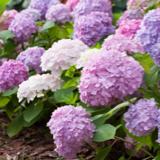
The houseplants in this list are exceptional; they are bold and pretty. Some of the most unique, beautiful indoor plants you should grow!Grow some of these plants indoors, and you’ll see a big change in your interior. These beautiful houseplants have the ability to change the appearance of any dull-boring room!1. Nerve Plant
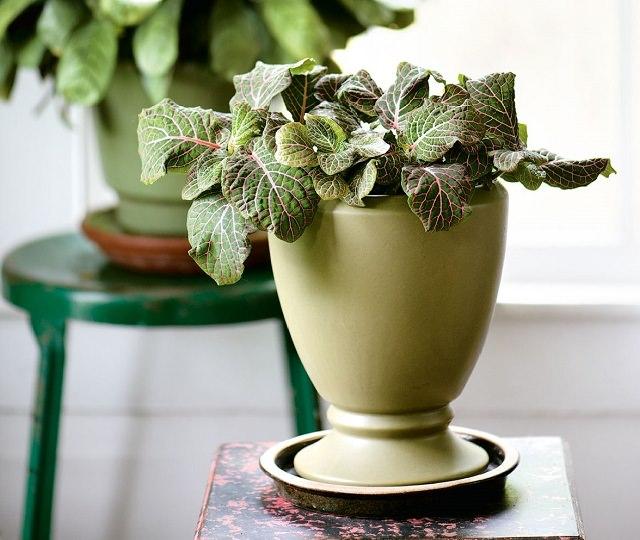
This demanding houseplant looks gorgeous due to its striking leaves. Picky about watering and dry indoor air and cold drafts. You must need to keep balance in watering.
2. Croton
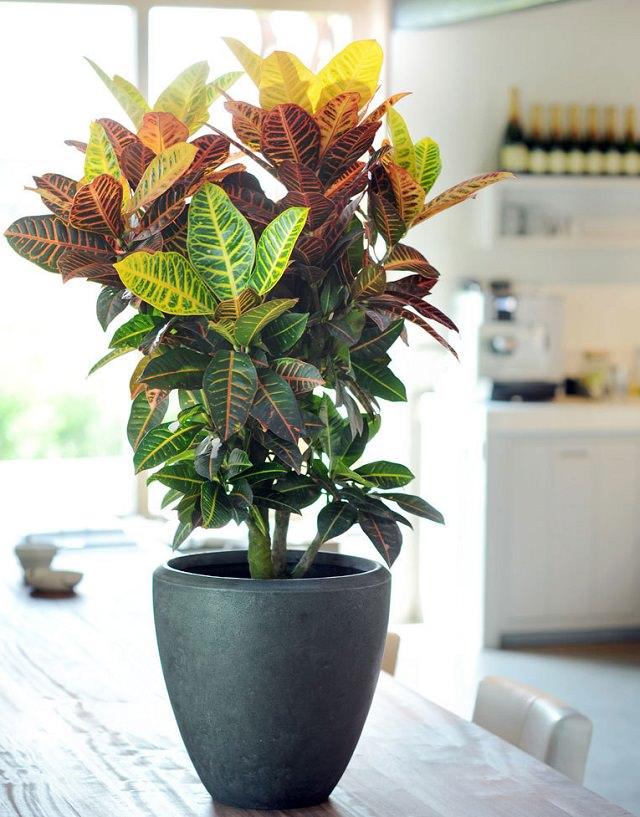
The bold and bodacious houseplant that is low maintenance too. The mix of yellow, amber, and orange color linear markings on thick dark green foliage, croton looks stunning. To grow, keep it in a spot that receives bright indirect light most of the time and water sporadically.
3. Calathea
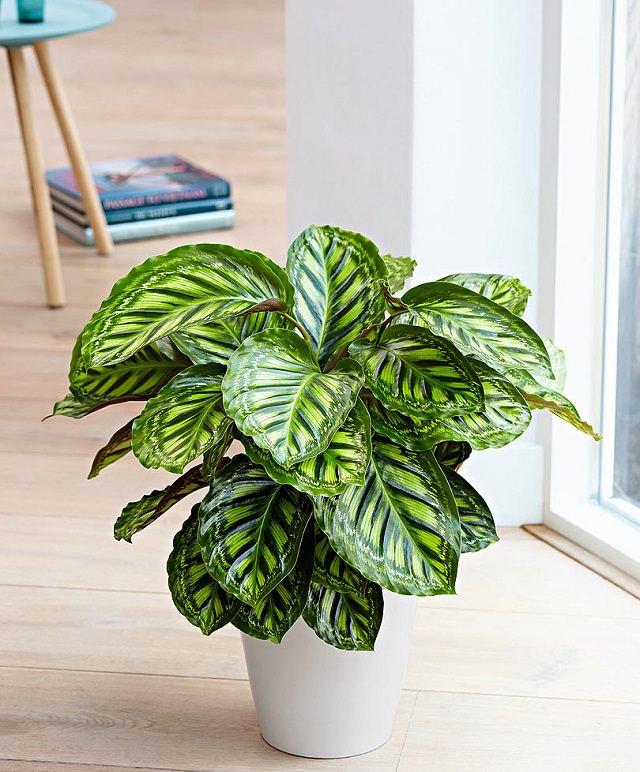
Lovely plant, great to look at! Many varieties are available in astonishing color combinations and patterns. This tropical houseplant doesn’t mind low light conditions. Keep it in warm, normal room temperature, saving from cold drafts. It likes humid surroundings and moderate watering.
4. Pencil Cactus
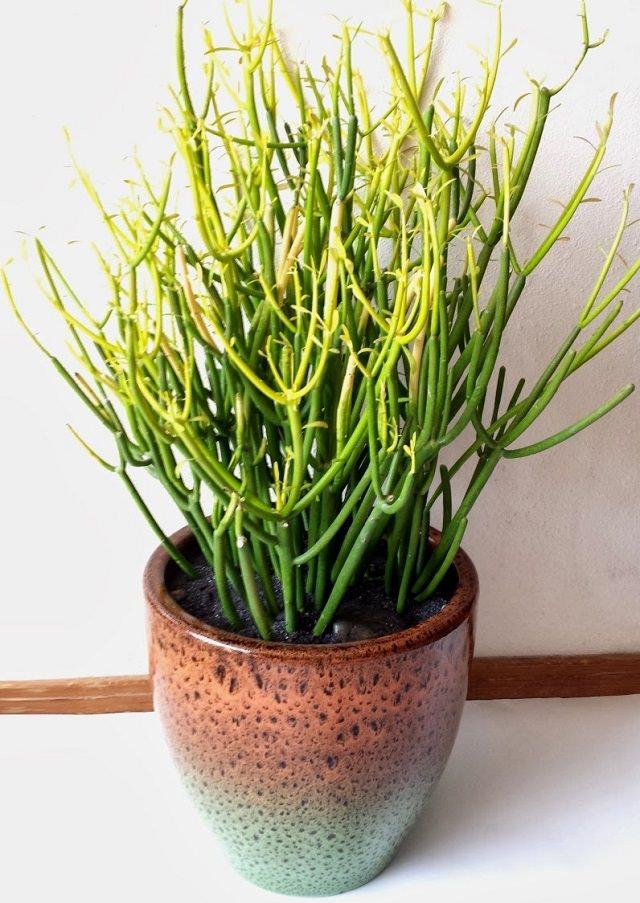
This unusual looking astonishing plant is notorious for its toxic milky sap (take care when handling this plant); still, it’s getting popular as a houseplant. Pencil cactus has medium to high light requirements and low watering needs; it also doesn’t mind dry air. Watering 2-3 times in a month is sufficient. To grow, keep the plant in a spot with ample light, a shaft of sunlight for a few hours or even more and it would do fine.
5. Silver Vase Plant
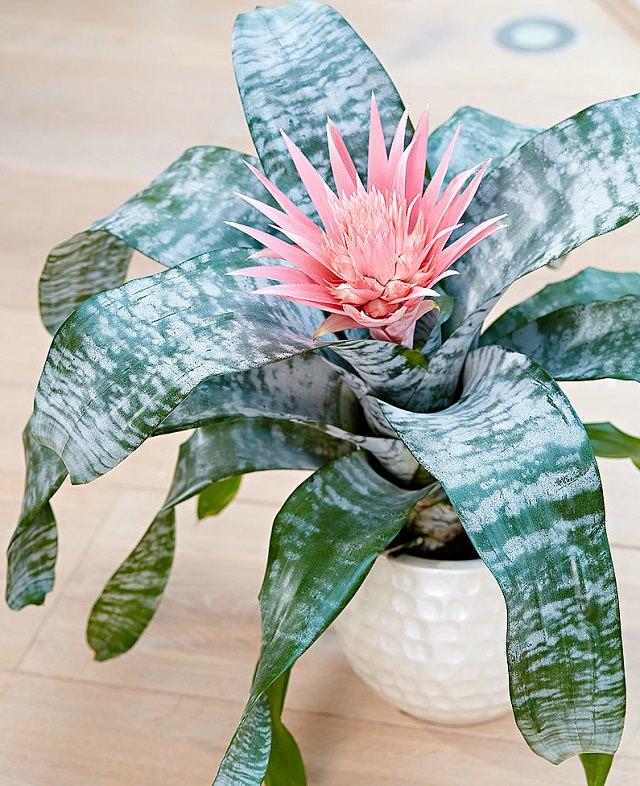
Unusual but a beautiful indoor plant, the silver vase or “urn plant” belongs to bromeliad family. Overall, growing this houseplant is similar to others– Be careful with watering, provide bright indirect light.
6. Fiddle Leaf Fig
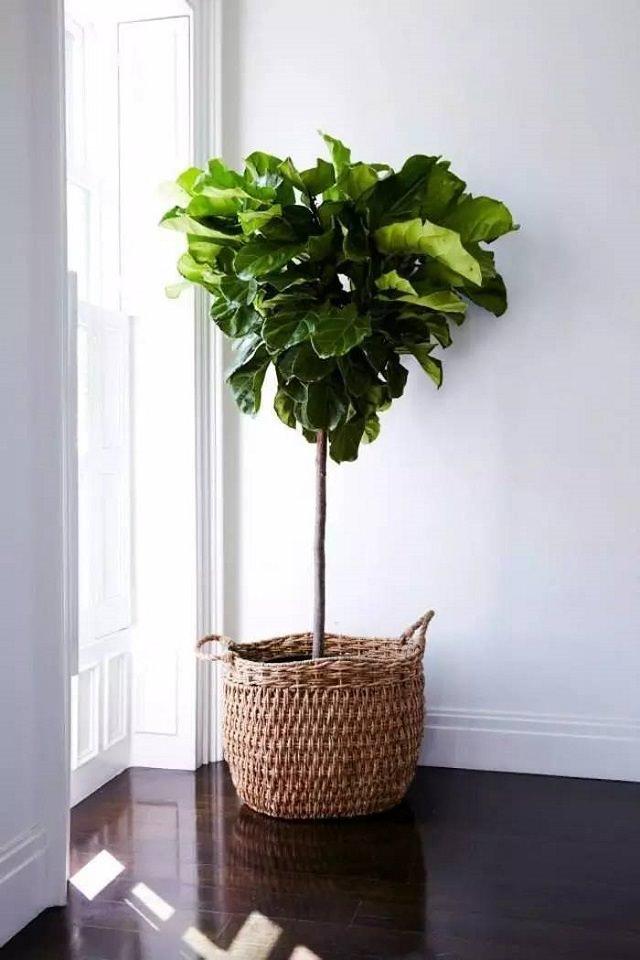
We couldn’t complete this list without adding fiddle leaf fig. Fiddle leaf is a tall, appealing houseplant with glossy, leathery foliage. This large houseplant can change the look of any room.
7. Aluminium Plant
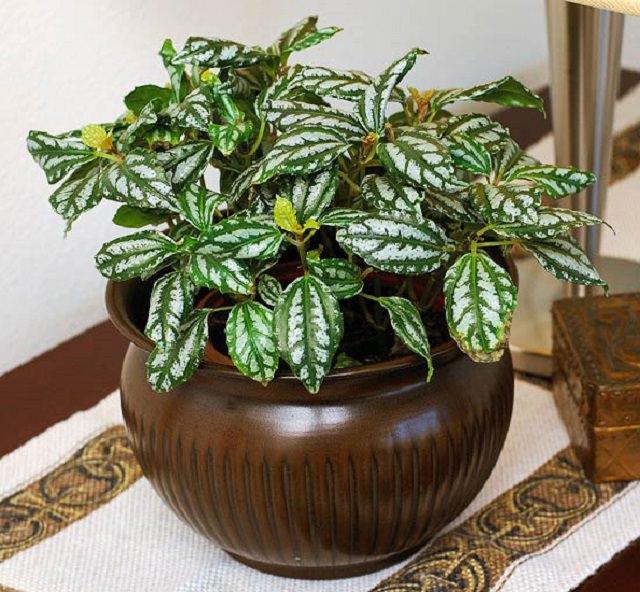
This plant is known for the beautiful silver strips that look like a color of aluminum; these strips appear over the glossy green color of each leaf. One of the beautiful indoor plants it is low maintenance. Keep it in a cool shady spot that receives a few hours of bright indirect light, water only when soil is dry.
8. Red Aglaonema
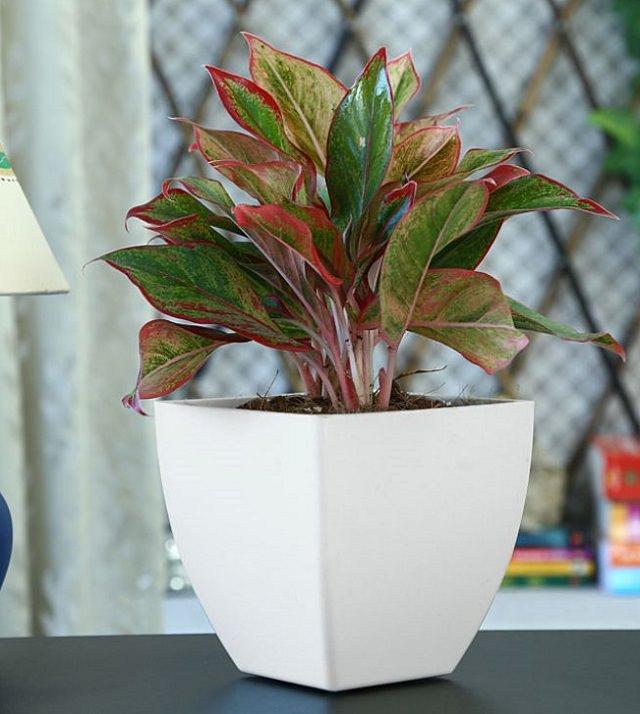
This beautiful houseplant’s dark green leaves with streaks of red and pink make it look really adorable indoors. It is absolutely easy to grow like Chinese evergreen and tolerates low light conditions and drought.
9. Anthurium
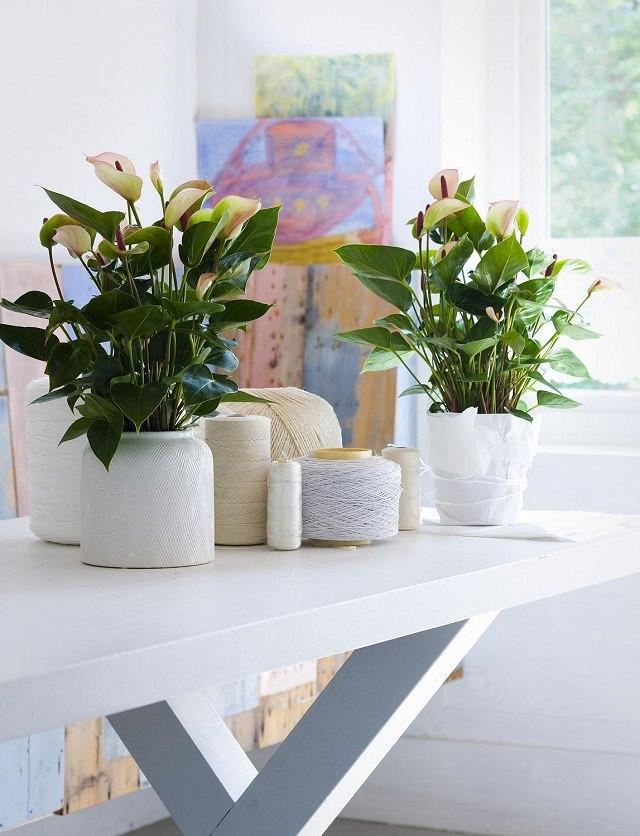
Anthuriums are beautiful houseplants that bloom in alluring shades of white, pink red or lavender. With a rich color palette, long lifespan and low care requirements, they are good for those with a busy lifestyle. Anthurium produces more foliage when grown in low-light conditions, so it’s you keep this plant in a spot that receives indirect sunlight all day.
10. African Mask Plant
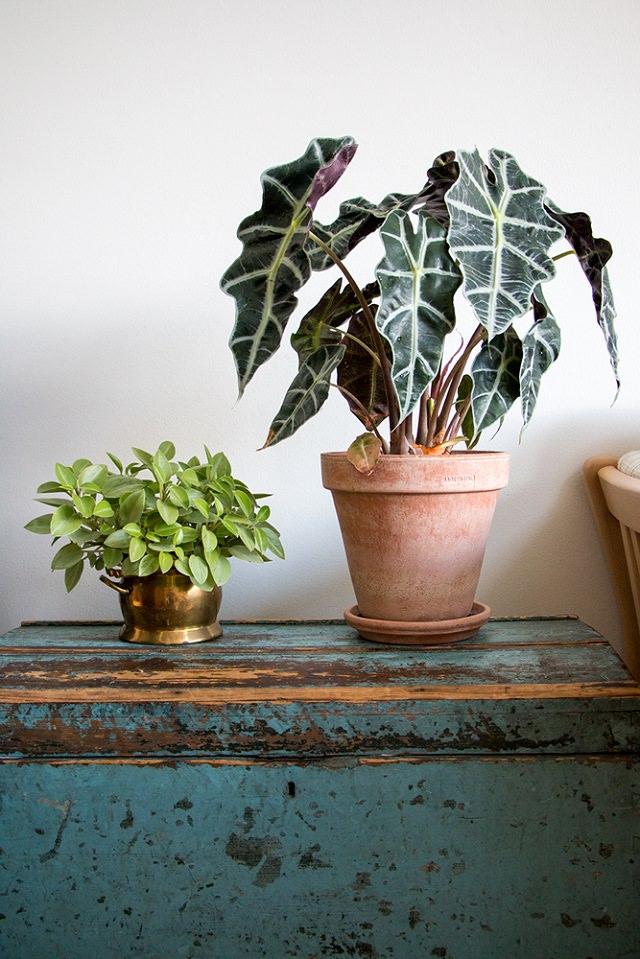
African Mask Plant with its dark green leaves and silvery-white veins can be easily mistaken for an artificial plant. This plant needs moderate watering and a bright position away from direct sunlight. Clean the leaves every few days to keep the plant looking attractive and healthy.
11. Prayer Plant
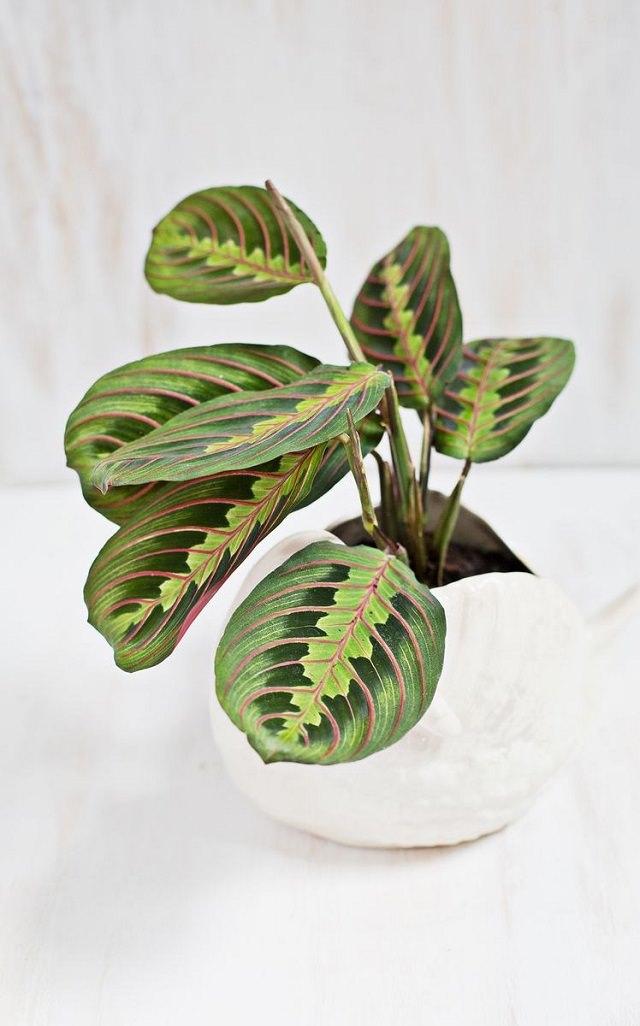
With its beautifully patterned oblong foliage and low care requirements, this exotic houseplant is a lovely addition to any home. It requires bright light, moderate watering, and warm room temperature when it’s grown indoors. One interesting fact about this houseplant is that it folds up its leaves in the night or in the dark place.
12. Bird’s Nest Fern
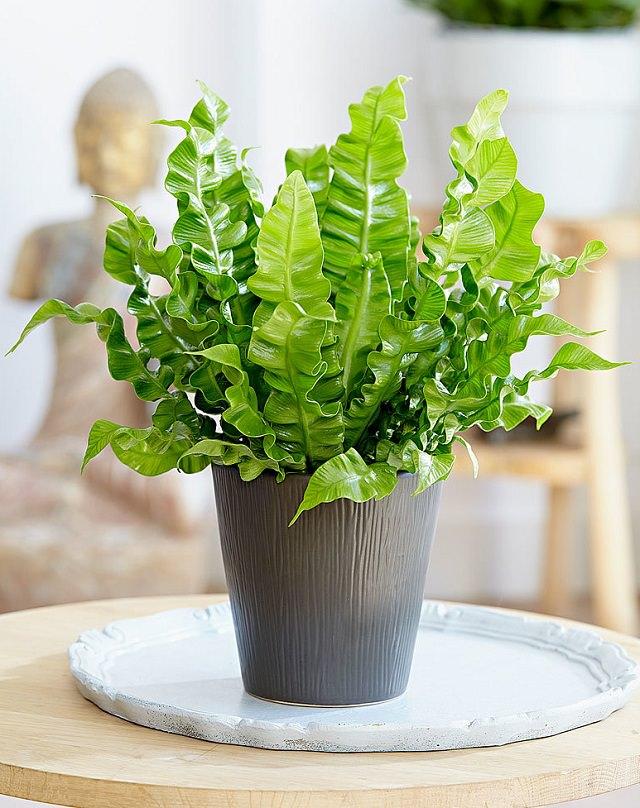
Native to Southeast Asia, bird’s nest fern (Asplenium nidus) is easy to grow if the proper conditions are given—mainly warmth and humidity. Bright indirect light and temperature around 70 F are optimum for growing bird’s nest fern indoors. Visit HGTV to learn more growing this!
13. Adenium
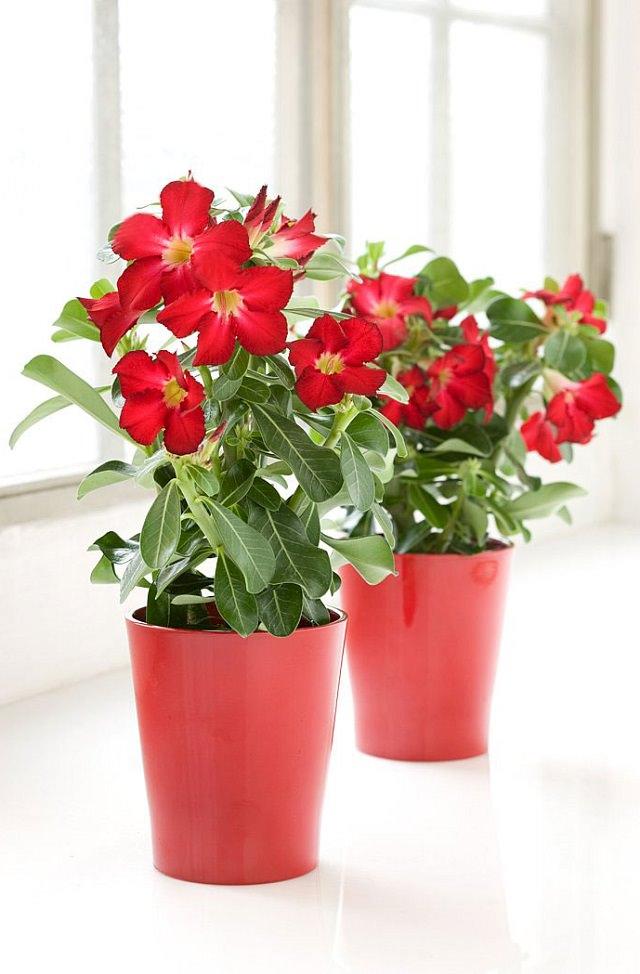
If you live in a warm climate and have a South or West facing window in your room, this is the plant you need to grow. Except for its sunlight requirements, Adenium is a low maintenance houseplant and flowers heartily throughout the year in frost-free climates.
14. Fiber-Optic Grass
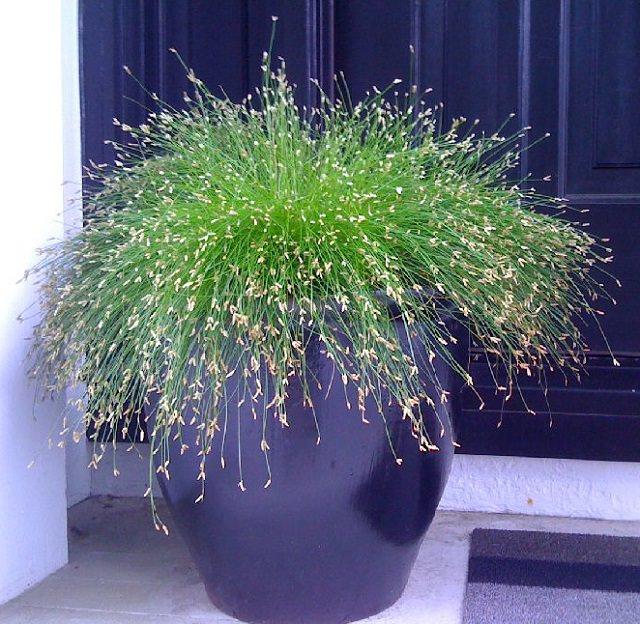
Fiber optic grass is a tropical grass that grows best in subtropical and tropical outdoor areas under USDA Zones (9-11), but it can be grown indoors in cooler regions too (We also added it to our list of BEST ORNAMENTAL GRASSES). Choose an ALLURING pot that will accentuate the beauty of this exotic grass, place it in a warm spot that receives bright light, and keep the soil slightly moist.
15. Ti Plant
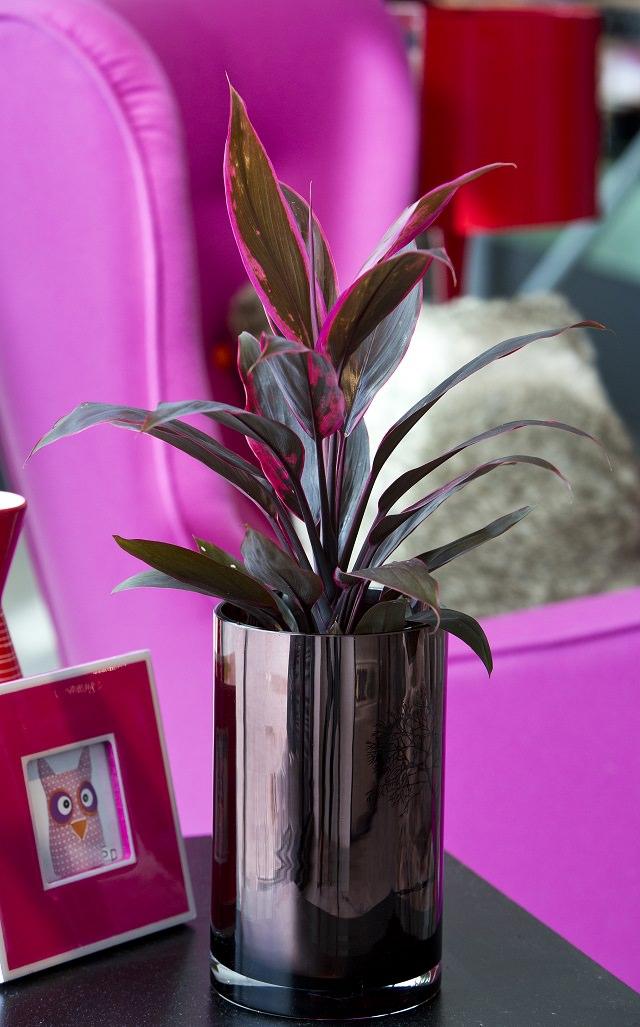
Purple foliage with streaks of blazing pink, the Ti plant looks hot and gorgeous. You can grow this plant for year around foliage attraction. This plant is drought tolerant but has a high light requirement, indoors, it must be kept somewhere where it can absorb direct and indirect light both.
16. Oxalis
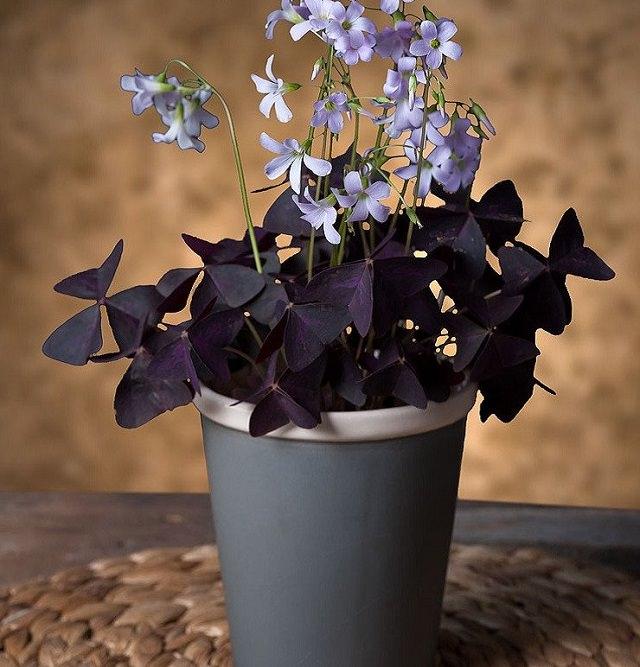
Oxalis belongs to a genus of edible, perennial plants characterized by striking mauve leaves and pink or white blooms. It prefers medium-to-bright light and performs better when grown in evenly moist soil.
17. Ponytail Palm
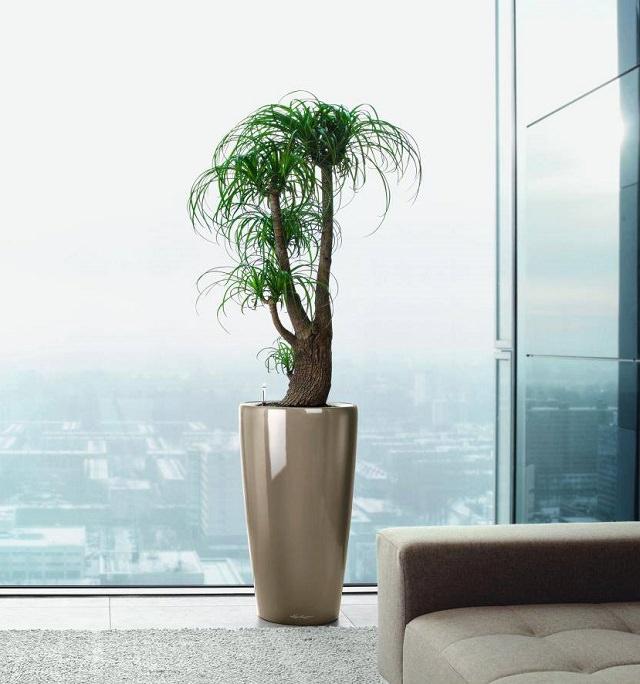
Ponytail Palm is an exotic succulent plant. It looks so interesting, one of the low maintenance plants as it has low watering needs and grows slowly, which means you don’t need to repot it frequently.
18. Poinsettia
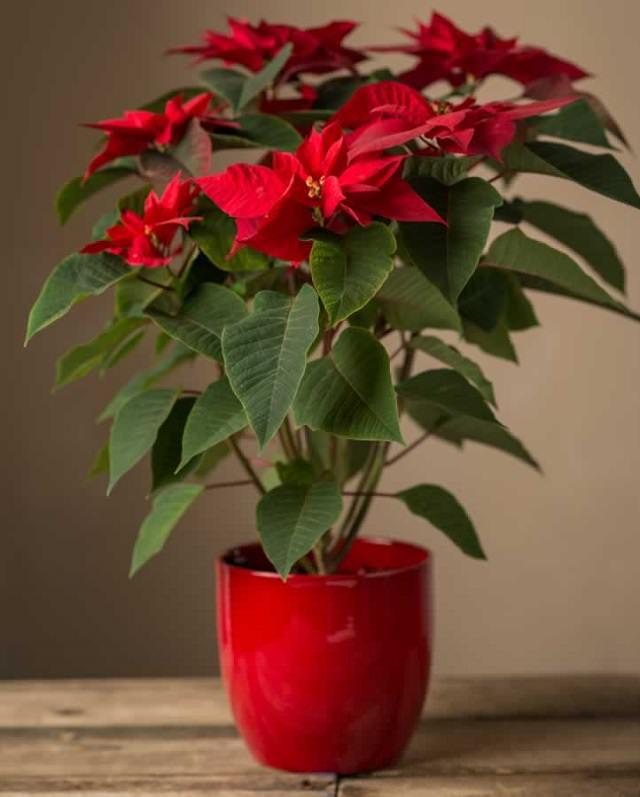
Poinsettias and holiday decorations go hand in hand. This plant looks stunning with or without blooms due to its colorful bracts and foliage. To remain healthy, cheery, and colorful, it needs a bright spot, a couple of hours of morning sunlight and indirect light all day long is sufficient. A draft-free place is best, watering when the soil is dry is required.
19. Rex Begonia
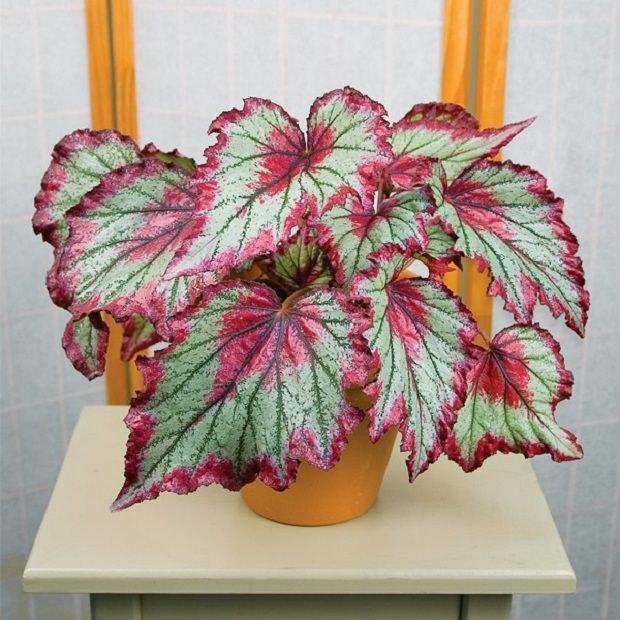
Rex begonias are best-looking begonias out there. Too showy, if you want to add a sparkle to your interior, grow them. Keeping in a bright shady spot in a well-drained medium, it’s important that you don’t overwater them.
20. Monstera Deliciosa
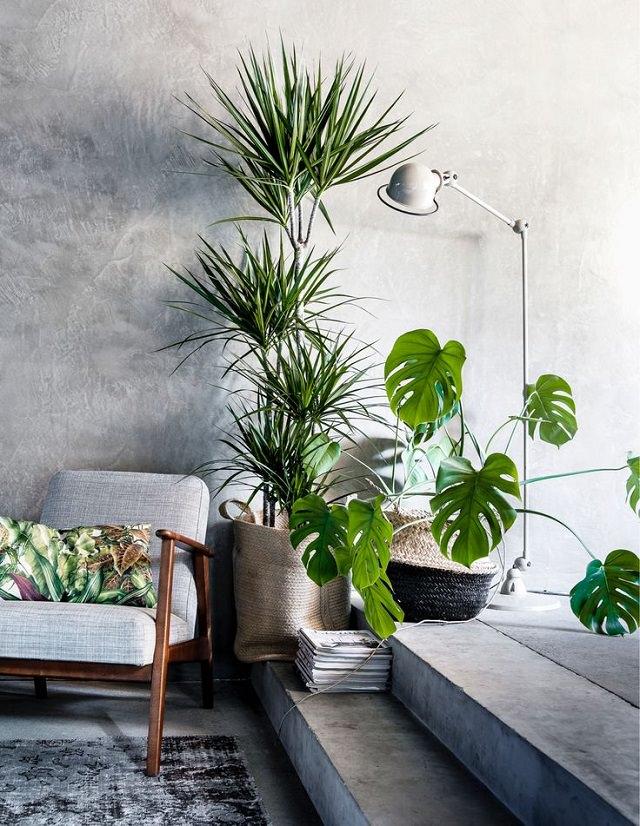
Monstera plant in a good looking pot standing beside a brightly painted wall in its supreme health displaying lush, oversized foliage of dark green color. You can imagine, it’ll look magnificent. Known as split leaf philodendron, you can also keep it in low light, for best result place it near a window where it’ll receive indirect sunlight all day long.
21. Schefflera (Umbrella Tree)
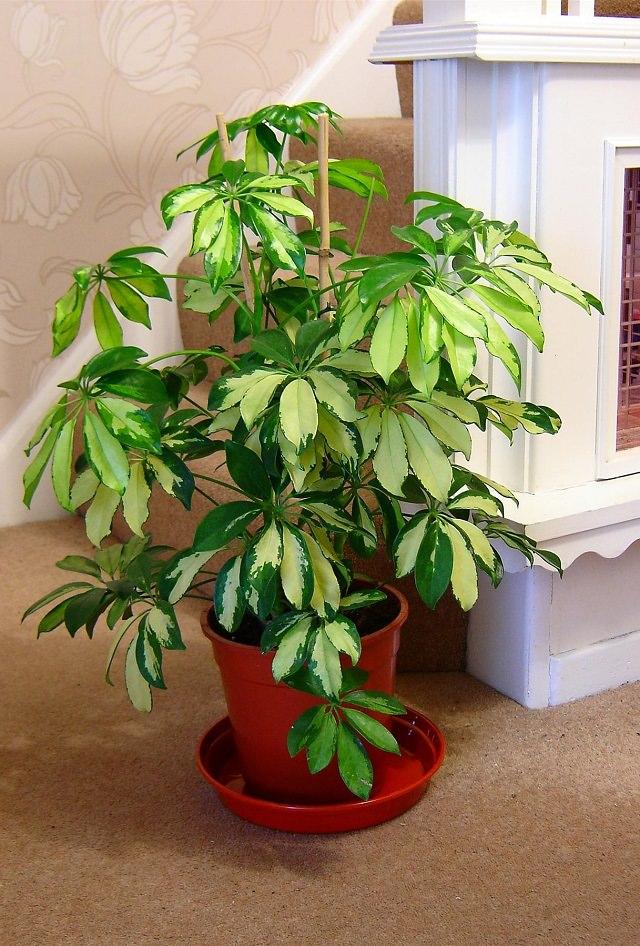
If you’re searching for a tall houseplant to improve the look of your interior, Schefflera is a good choice. Schefflera is finicky about its light requirements and doesn’t like direct sun but this doesn’t mean you can keep it in dim light, a spot near a window that receive indirect sunlight most of the time and have proper air circulation is what it demands. Watering should be done moderately.
22. Streptocarpus
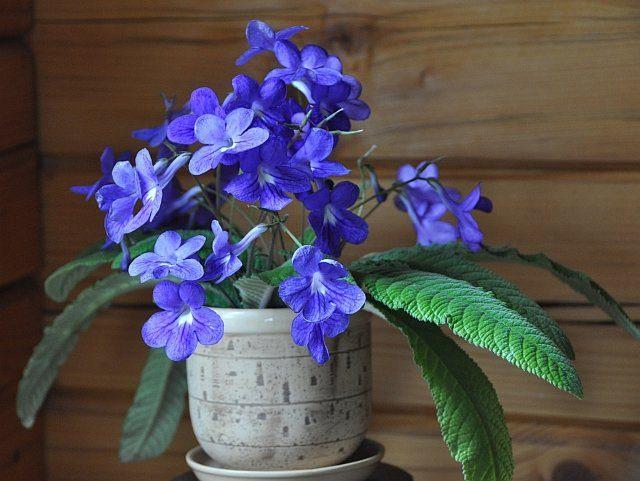
Streptocarpus, better known as the cape primrose is related to the African Violets; it prefers the same growing conditions of indirect light or filtered sunlight and moderately watered soil. Its velvety, deep green leaves and eye-catchy floral clusters hovering above the underlying foliage create a stunning appeal, which makes it perfect for adorning a secluded corner of a drawing room or adding a dash of color to an otherwise, dull space.
23. String of Pearls

The string of pearls is an easy-care succulent plant. It looks stunning in hanging baskets, trailing down. It is drought tolerant so you don’t need to water frequently, once in every other week would be enough.
24. Pleomele (Song of India)
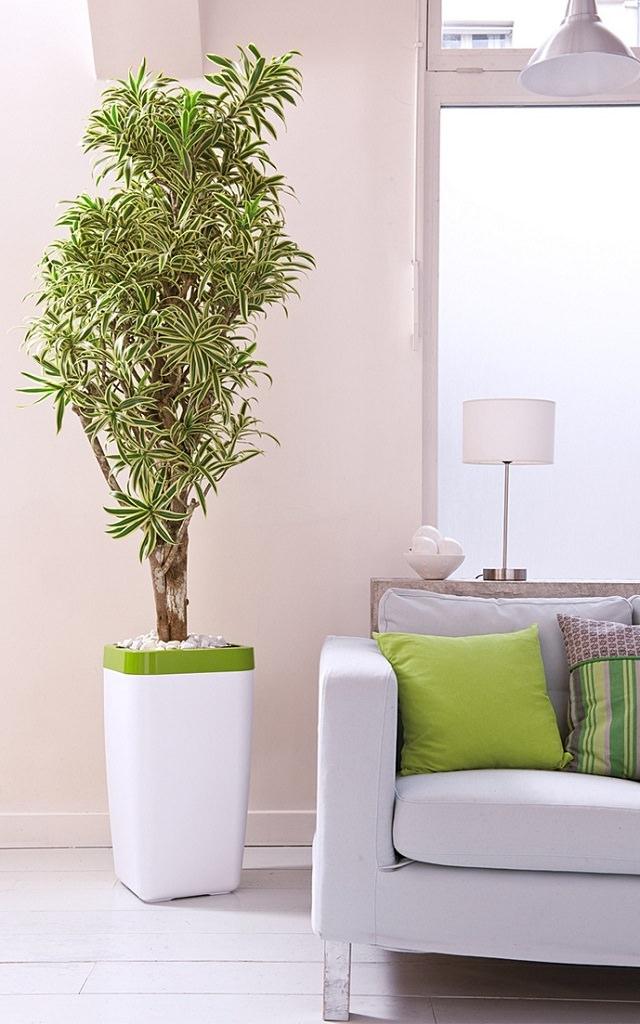
Dracaena reflexa like other plants of this genus is an easy-care houseplant. It’s one of the most ornamental dracaenas; the leaves have solid green color in the middle and a line of lime-yellow color on sides. Good for tabletops and plant stands as pleomele is a slow growing plant.
25. Brazilian Fireworks
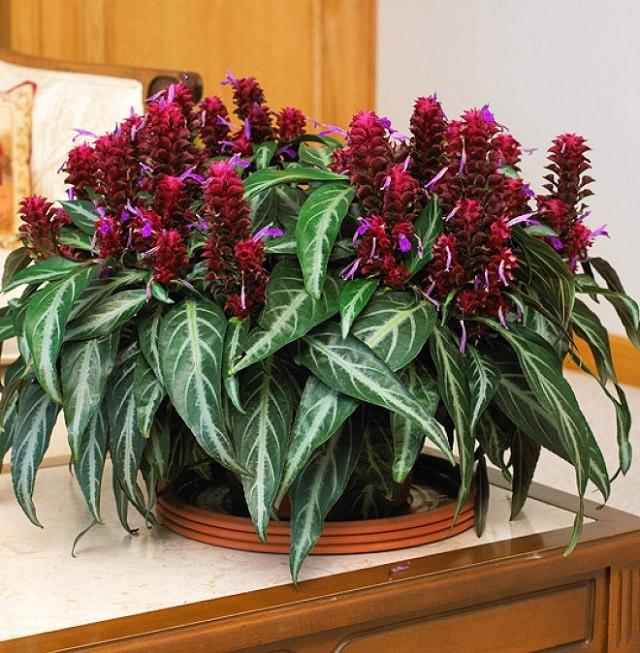
Whether you use this gorgeous tropical plant indoors, or in warm, shade gardens (if living in USDA zones 9-11), the Brazilian fireworks is a year-round delight with or without its flowers. This shade-loving plant is DEMANDING but thrives best when subjected to bright, indirect sunlight and occasional watering.
26. Peace lily
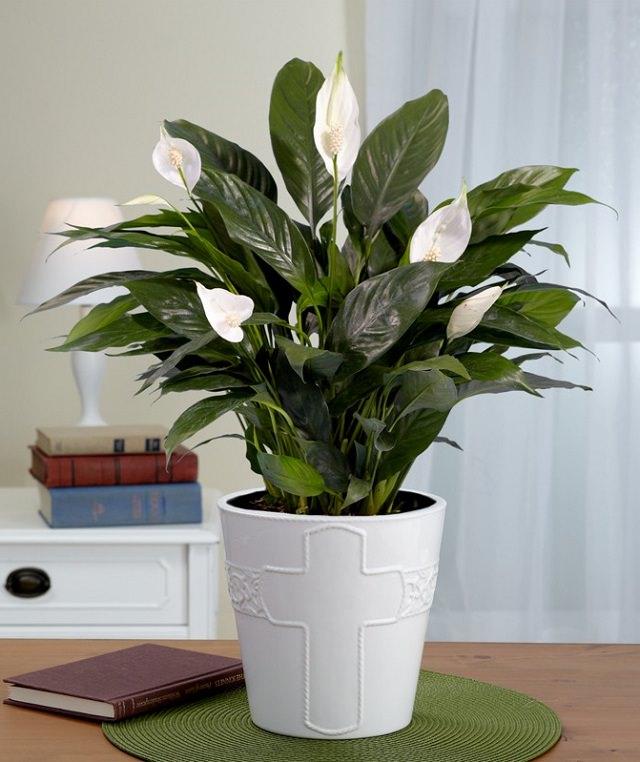
The peace lily is an attractive, low maintenance, air cleaning houseplant. This plant bears showy, spoon-shaped white spathe amidst a spike of white flower. Peace Lily survives best in a shady environment and easily tackle the absence of light.
27. Crown of Thorns
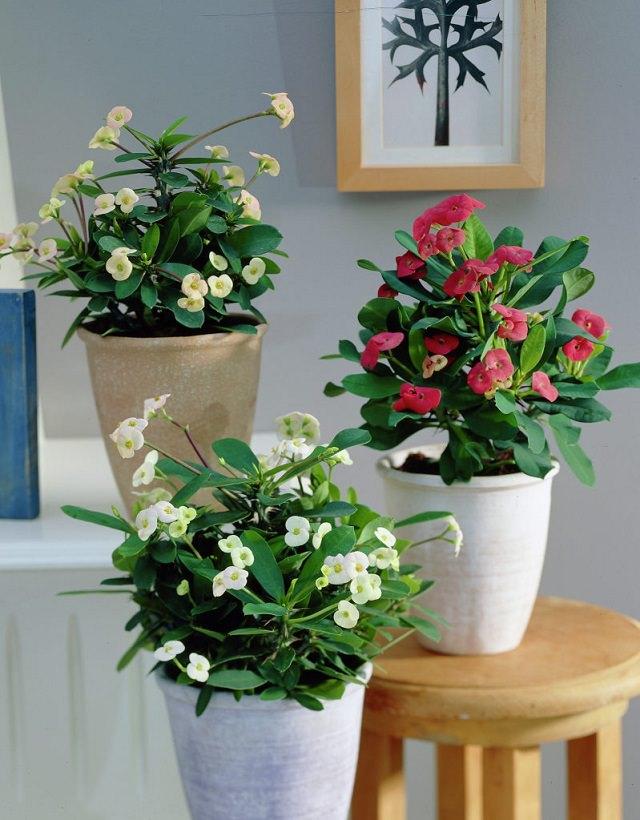
This lovely poinsettia relative is quite tolerant of neglect and thrives well as long as you place it in a bright spot and keep it in drier side. Appreciated for its showy flowers and thick, grayish-green leaves, it is a popular choice for indoor gardening.
28. Money Tree (Pachira Aquatica)

Tall, fat trunk, glossy-large foliage, the money tree is indeed a substitute for the fiddle leaf fig. Only a few indoor trees can become that tall. Also, it’s a low-maintenance houseplant. If you want to learn how to grow Pachira Aquatica indoors, click here!
29. African Violet

African violets are among the most easy-to-care flowering houseplants. They produce delicate, mauve flowers with little effort from your side. You can choose from several varieties, right from the white-edged blooms to the variegated foliage forms.

This demanding houseplant looks gorgeous due to its striking leaves. Picky about watering and dry indoor air and cold drafts. You must need to keep balance in watering.
2. Croton

The bold and bodacious houseplant that is low maintenance too. The mix of yellow, amber, and orange color linear markings on thick dark green foliage, croton looks stunning. To grow, keep it in a spot that receives bright indirect light most of the time and water sporadically.
3. Calathea

Lovely plant, great to look at! Many varieties are available in astonishing color combinations and patterns. This tropical houseplant doesn’t mind low light conditions. Keep it in warm, normal room temperature, saving from cold drafts. It likes humid surroundings and moderate watering.
4. Pencil Cactus

This unusual looking astonishing plant is notorious for its toxic milky sap (take care when handling this plant); still, it’s getting popular as a houseplant. Pencil cactus has medium to high light requirements and low watering needs; it also doesn’t mind dry air. Watering 2-3 times in a month is sufficient. To grow, keep the plant in a spot with ample light, a shaft of sunlight for a few hours or even more and it would do fine.
5. Silver Vase Plant

Unusual but a beautiful indoor plant, the silver vase or “urn plant” belongs to bromeliad family. Overall, growing this houseplant is similar to others– Be careful with watering, provide bright indirect light.
6. Fiddle Leaf Fig

We couldn’t complete this list without adding fiddle leaf fig. Fiddle leaf is a tall, appealing houseplant with glossy, leathery foliage. This large houseplant can change the look of any room.
7. Aluminium Plant

This plant is known for the beautiful silver strips that look like a color of aluminum; these strips appear over the glossy green color of each leaf. One of the beautiful indoor plants it is low maintenance. Keep it in a cool shady spot that receives a few hours of bright indirect light, water only when soil is dry.
8. Red Aglaonema

This beautiful houseplant’s dark green leaves with streaks of red and pink make it look really adorable indoors. It is absolutely easy to grow like Chinese evergreen and tolerates low light conditions and drought.
9. Anthurium

Anthuriums are beautiful houseplants that bloom in alluring shades of white, pink red or lavender. With a rich color palette, long lifespan and low care requirements, they are good for those with a busy lifestyle. Anthurium produces more foliage when grown in low-light conditions, so it’s you keep this plant in a spot that receives indirect sunlight all day.
10. African Mask Plant

African Mask Plant with its dark green leaves and silvery-white veins can be easily mistaken for an artificial plant. This plant needs moderate watering and a bright position away from direct sunlight. Clean the leaves every few days to keep the plant looking attractive and healthy.
11. Prayer Plant

With its beautifully patterned oblong foliage and low care requirements, this exotic houseplant is a lovely addition to any home. It requires bright light, moderate watering, and warm room temperature when it’s grown indoors. One interesting fact about this houseplant is that it folds up its leaves in the night or in the dark place.
12. Bird’s Nest Fern

Native to Southeast Asia, bird’s nest fern (Asplenium nidus) is easy to grow if the proper conditions are given—mainly warmth and humidity. Bright indirect light and temperature around 70 F are optimum for growing bird’s nest fern indoors. Visit HGTV to learn more growing this!
13. Adenium

If you live in a warm climate and have a South or West facing window in your room, this is the plant you need to grow. Except for its sunlight requirements, Adenium is a low maintenance houseplant and flowers heartily throughout the year in frost-free climates.
14. Fiber-Optic Grass

Fiber optic grass is a tropical grass that grows best in subtropical and tropical outdoor areas under USDA Zones (9-11), but it can be grown indoors in cooler regions too (We also added it to our list of BEST ORNAMENTAL GRASSES). Choose an ALLURING pot that will accentuate the beauty of this exotic grass, place it in a warm spot that receives bright light, and keep the soil slightly moist.
15. Ti Plant

Purple foliage with streaks of blazing pink, the Ti plant looks hot and gorgeous. You can grow this plant for year around foliage attraction. This plant is drought tolerant but has a high light requirement, indoors, it must be kept somewhere where it can absorb direct and indirect light both.
16. Oxalis

Oxalis belongs to a genus of edible, perennial plants characterized by striking mauve leaves and pink or white blooms. It prefers medium-to-bright light and performs better when grown in evenly moist soil.
17. Ponytail Palm

Ponytail Palm is an exotic succulent plant. It looks so interesting, one of the low maintenance plants as it has low watering needs and grows slowly, which means you don’t need to repot it frequently.
18. Poinsettia

Poinsettias and holiday decorations go hand in hand. This plant looks stunning with or without blooms due to its colorful bracts and foliage. To remain healthy, cheery, and colorful, it needs a bright spot, a couple of hours of morning sunlight and indirect light all day long is sufficient. A draft-free place is best, watering when the soil is dry is required.
19. Rex Begonia

Rex begonias are best-looking begonias out there. Too showy, if you want to add a sparkle to your interior, grow them. Keeping in a bright shady spot in a well-drained medium, it’s important that you don’t overwater them.
20. Monstera Deliciosa

Monstera plant in a good looking pot standing beside a brightly painted wall in its supreme health displaying lush, oversized foliage of dark green color. You can imagine, it’ll look magnificent. Known as split leaf philodendron, you can also keep it in low light, for best result place it near a window where it’ll receive indirect sunlight all day long.
21. Schefflera (Umbrella Tree)

If you’re searching for a tall houseplant to improve the look of your interior, Schefflera is a good choice. Schefflera is finicky about its light requirements and doesn’t like direct sun but this doesn’t mean you can keep it in dim light, a spot near a window that receive indirect sunlight most of the time and have proper air circulation is what it demands. Watering should be done moderately.
22. Streptocarpus

Streptocarpus, better known as the cape primrose is related to the African Violets; it prefers the same growing conditions of indirect light or filtered sunlight and moderately watered soil. Its velvety, deep green leaves and eye-catchy floral clusters hovering above the underlying foliage create a stunning appeal, which makes it perfect for adorning a secluded corner of a drawing room or adding a dash of color to an otherwise, dull space.
23. String of Pearls

The string of pearls is an easy-care succulent plant. It looks stunning in hanging baskets, trailing down. It is drought tolerant so you don’t need to water frequently, once in every other week would be enough.
24. Pleomele (Song of India)

Dracaena reflexa like other plants of this genus is an easy-care houseplant. It’s one of the most ornamental dracaenas; the leaves have solid green color in the middle and a line of lime-yellow color on sides. Good for tabletops and plant stands as pleomele is a slow growing plant.
25. Brazilian Fireworks

Whether you use this gorgeous tropical plant indoors, or in warm, shade gardens (if living in USDA zones 9-11), the Brazilian fireworks is a year-round delight with or without its flowers. This shade-loving plant is DEMANDING but thrives best when subjected to bright, indirect sunlight and occasional watering.
26. Peace lily

The peace lily is an attractive, low maintenance, air cleaning houseplant. This plant bears showy, spoon-shaped white spathe amidst a spike of white flower. Peace Lily survives best in a shady environment and easily tackle the absence of light.
27. Crown of Thorns

This lovely poinsettia relative is quite tolerant of neglect and thrives well as long as you place it in a bright spot and keep it in drier side. Appreciated for its showy flowers and thick, grayish-green leaves, it is a popular choice for indoor gardening.
28. Money Tree (Pachira Aquatica)

Tall, fat trunk, glossy-large foliage, the money tree is indeed a substitute for the fiddle leaf fig. Only a few indoor trees can become that tall. Also, it’s a low-maintenance houseplant. If you want to learn how to grow Pachira Aquatica indoors, click here!
29. African Violet

African violets are among the most easy-to-care flowering houseplants. They produce delicate, mauve flowers with little effort from your side. You can choose from several varieties, right from the white-edged blooms to the variegated foliage forms.
2
0
文章
Colorful
2017年05月23日

9 different colors of houseplants and how they impact your lifestyle! Learn about them and bring them in to beat the winter blues!
If you are suddenly feeling anxious, tired or sad and that you’re lacking energy, well join the club and don’t worry; winter is coming. Days are way too short, temperatures are low, sun is absent of the picture and summer gave way to a colder and heavier season. Yes, it’s tough, but winter also has advantages: snowfalls, holidays, skiing. If winter activities are not enough to kick the blues, we have lots of suggestions for ways to lift your spirits up and get rid of the winter melancholies.
You miss the light, the greenery and the colors of summer? So let’s bring them home! A lot of studies have shown that indoor plants can have positive effects on wellbeing. Besides providing a soothing environment, reducing stress or making you relax, indoor plants also stimulate us. This is exactly what we need to beat the winter blues, isn’t it?
And to make the solution even more effective, you should include flowers in the mix. Indeed, colors have healing powers that can cheer anyone up! Garden design trends are also incorporating color therapy. Meaning, that the arrangements include colorful flowers which trigger happy emotions, heightens feelings of life satisfaction and affects social behavior in a positive manner, as analyzed by behavioral studies led at Rutgers University. Let’s explore colors, shall we?
1. Red
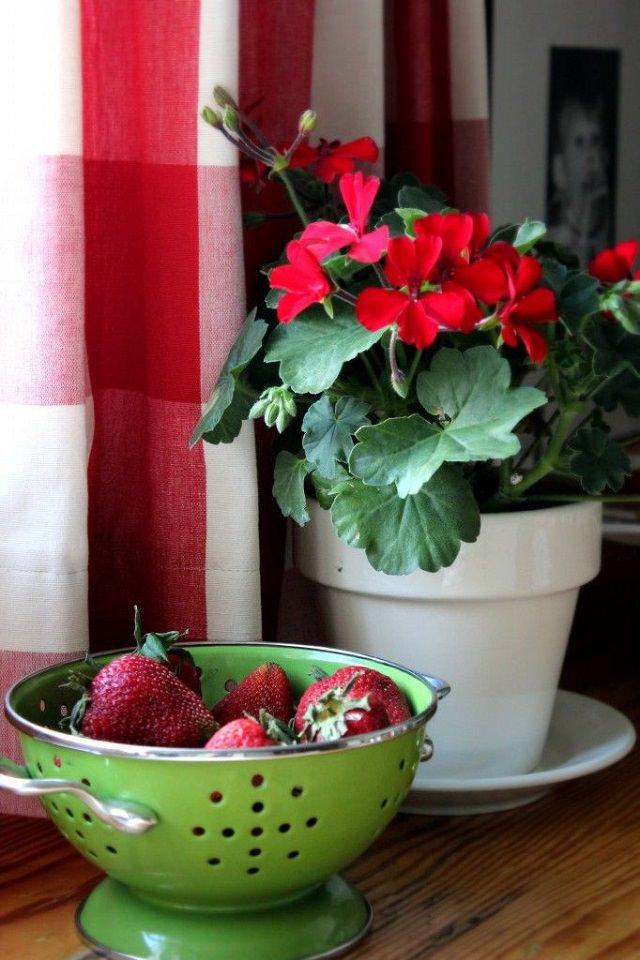
Even if red is not a recommended when it comes to the wall of your new bedroom, this color triggers a sense of vitality and boosts energy. This warm color is good for passive people and for those who always feel tired. Red also multiplies by ten the senses such as hearing, vision and touch. So what do you think about a Ranunculus bouquet in your bedroom or poisettias, Christmas cactus, geraniums, you have plenty of options.
2. Orange
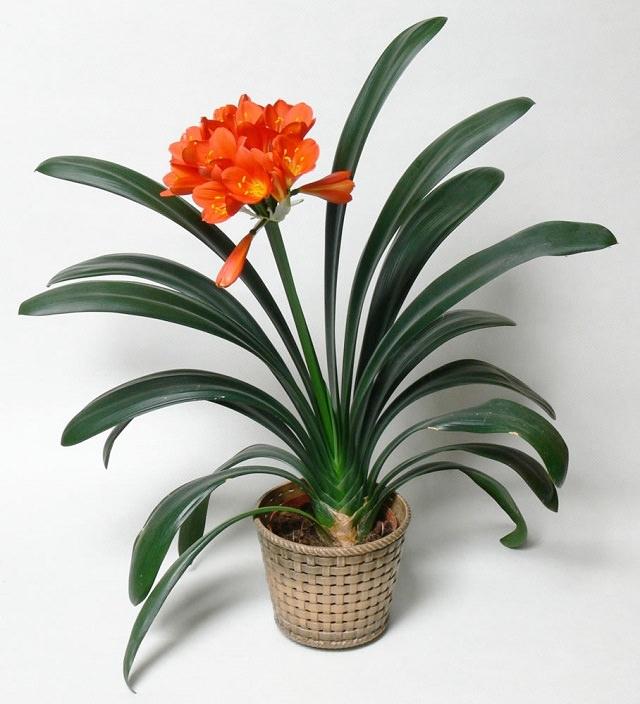
Don’t forget to add some orange in your indoor landscape design. Like red, it is a warm color but it’s less exciting. It still cheers people up but in a softer way. By seeing orange flowers such as begonias, people feel their body and mind relieved from pressures. Plus, orange fosters creative thinking, by helping people at rock bottom get out of it and imagine new possibilities in life.
3. Yellow
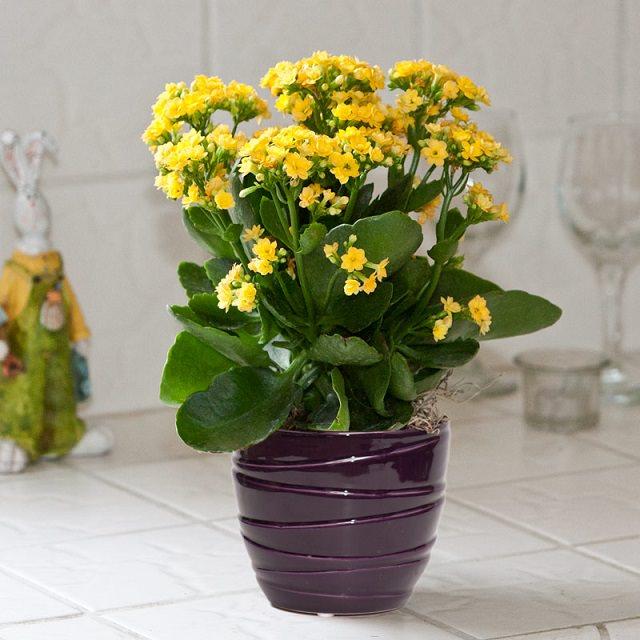
If creative people love yellow, it is because it allows them to be even more creative. This cheerful color, associated to the brightness of the sun, helps stimulate intelligence. Just be careful not to overuse it because it can lead to insomnia for example. So, just avoid putting those wonderful sunflowers in your bedroom. However, you have many other planting options like sweet potato vine, kalenchoe, black eyed susan etc.
4. Green
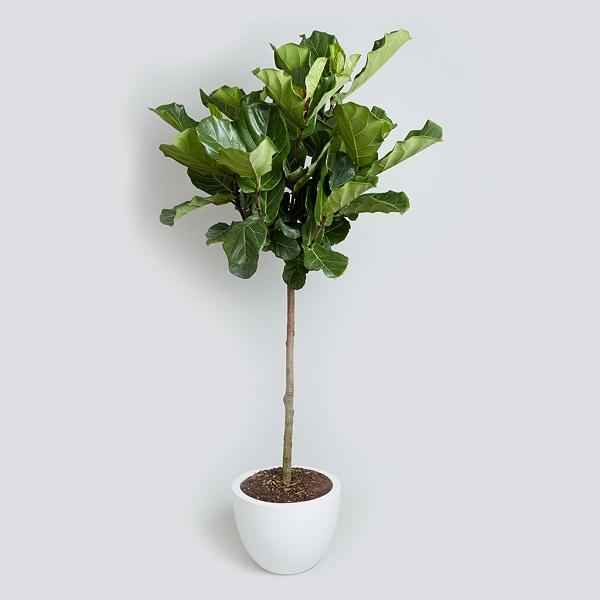
Because green is the color of nature and that represents the Earth, it symbolizes growth and renewal. So green bring balance and comforts you. A Spider Plant is perfect to bring harmony into a home.
5. Blue
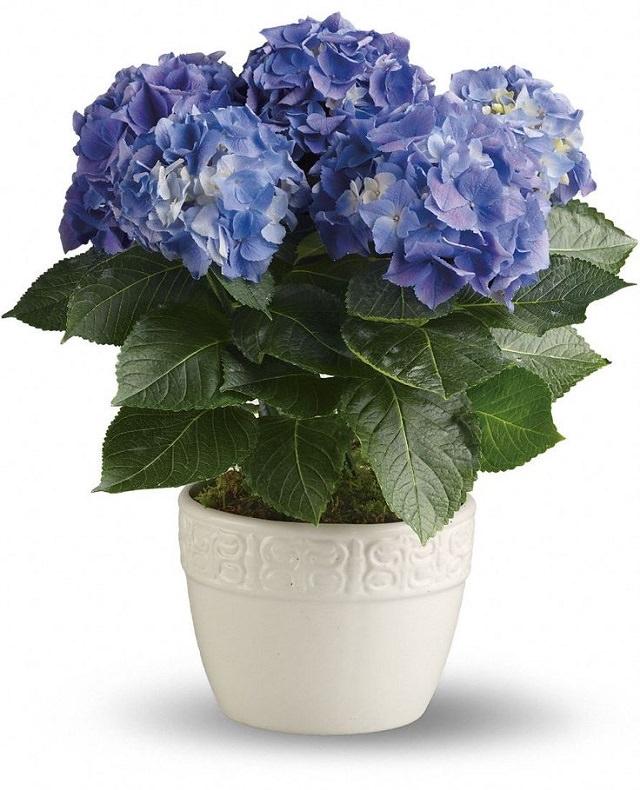
Blue is probably the most famous color in terms of soothing. As the color symbolizing the sky and the sea, it is linked with serenity. Blue calms strong emotions such as anger or hysteria. Grow Iris or hydrangea inside your home and you will definitely get rid of any rage signs. If you feel distressed, the blue color will lower blood pressure as well as your heart rate. Tranquility boost guaranteed.
6. Violet

Along with purple and lavender, the violet color is linked with the cerebral and nervous systems, and for that reason, it relaxes the mind by releasing any kind of emotional stress. Violet heals different states of mind like melancholy or hysteria by bringing spiritual insights. For that matter, violet gives way to renewal and motivates the transformation. Simply grow Pansies in your bedroom, it will help you sleep, and dreams will positively affect the day coming next.
7. White
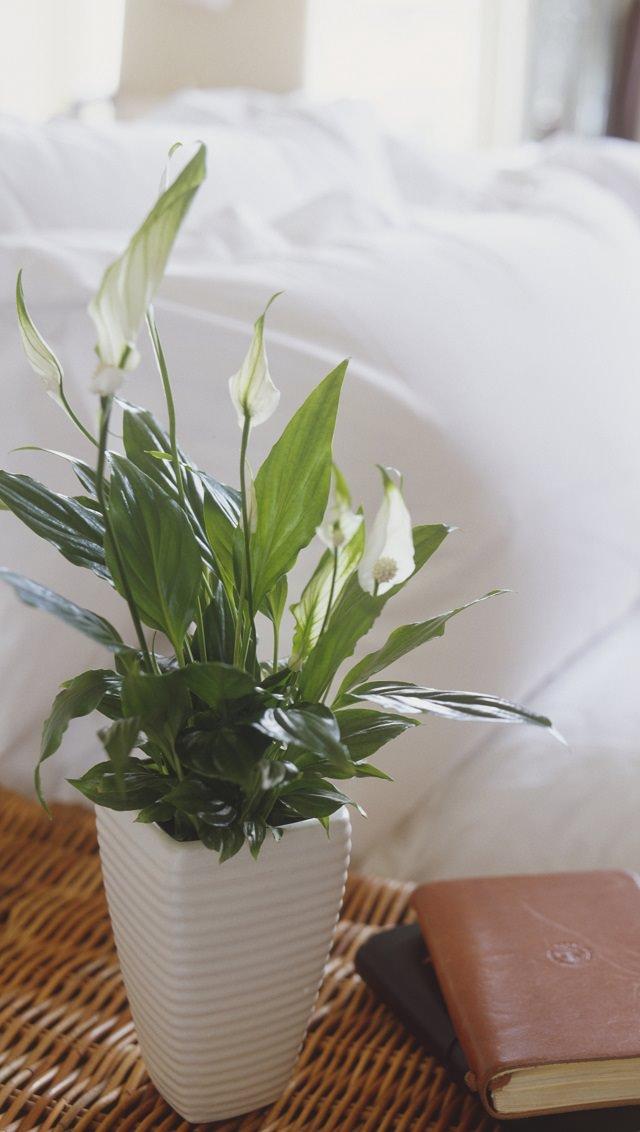
White is a sign of pureness, and that is why it helps to get rid of all the negative moods and reach the truth. If winter makes you feel insecure, simply add Paperwhites into your indoor landscape design and you’ll immediately feel the harmony getting the upper hand in every aspects of your life. There are many other beautiful houseplants that provide white color like peace lily, jasmine, gardenia.
8. Magenta
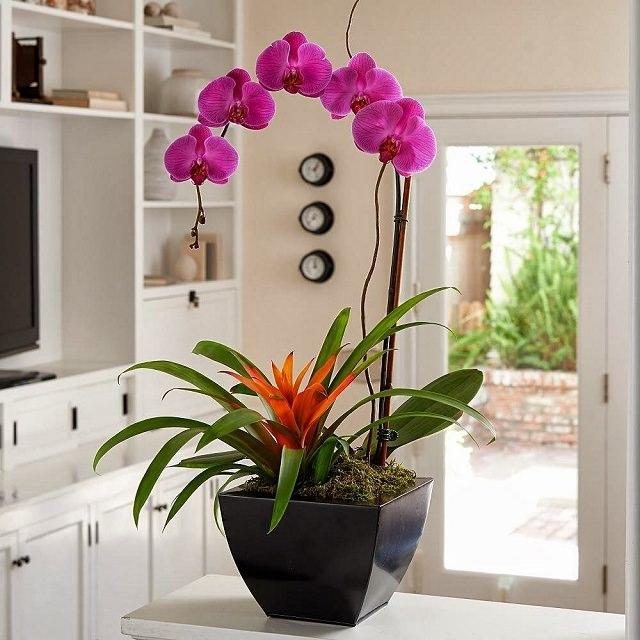
Like violet, magenta is also a spiritual color. It helps strengthen the link with your life purpose. And because it is a little bit flashier than purple, it boosts adrenaline. At home, Tulips do the job perfectly well or you can grow the orchids.
9. Pink
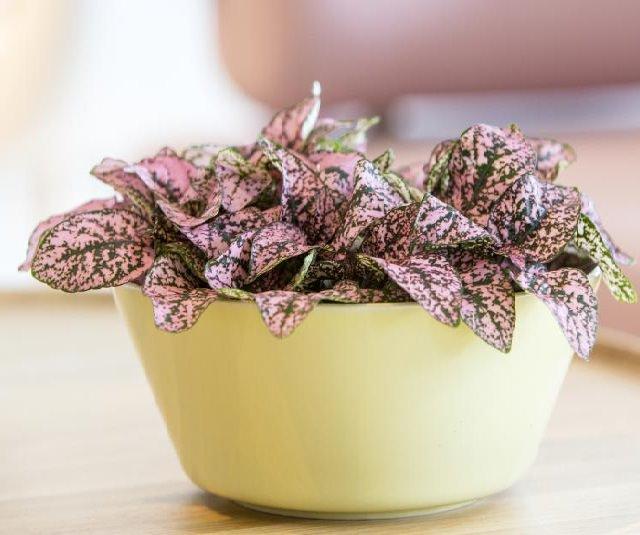
You see pink and you automatically see candies and tender images from your childhood. Pink definitely brings some youth back, and heals your grief and sadness, because it means affection and protection. For that matter, this bouquet of roses is going to please all the family. You can also look at other plants like pink hibiscus, geraniums, polka-dot plant, and begonia.
Now that you know how to set up your indoor garden to battle the winter blues, you don’t need to be afraid! Simply use flowers and plants from all different colors to boost your mood, and you will be the happiest person in the world!
If you are suddenly feeling anxious, tired or sad and that you’re lacking energy, well join the club and don’t worry; winter is coming. Days are way too short, temperatures are low, sun is absent of the picture and summer gave way to a colder and heavier season. Yes, it’s tough, but winter also has advantages: snowfalls, holidays, skiing. If winter activities are not enough to kick the blues, we have lots of suggestions for ways to lift your spirits up and get rid of the winter melancholies.
You miss the light, the greenery and the colors of summer? So let’s bring them home! A lot of studies have shown that indoor plants can have positive effects on wellbeing. Besides providing a soothing environment, reducing stress or making you relax, indoor plants also stimulate us. This is exactly what we need to beat the winter blues, isn’t it?
And to make the solution even more effective, you should include flowers in the mix. Indeed, colors have healing powers that can cheer anyone up! Garden design trends are also incorporating color therapy. Meaning, that the arrangements include colorful flowers which trigger happy emotions, heightens feelings of life satisfaction and affects social behavior in a positive manner, as analyzed by behavioral studies led at Rutgers University. Let’s explore colors, shall we?
1. Red

Even if red is not a recommended when it comes to the wall of your new bedroom, this color triggers a sense of vitality and boosts energy. This warm color is good for passive people and for those who always feel tired. Red also multiplies by ten the senses such as hearing, vision and touch. So what do you think about a Ranunculus bouquet in your bedroom or poisettias, Christmas cactus, geraniums, you have plenty of options.
2. Orange

Don’t forget to add some orange in your indoor landscape design. Like red, it is a warm color but it’s less exciting. It still cheers people up but in a softer way. By seeing orange flowers such as begonias, people feel their body and mind relieved from pressures. Plus, orange fosters creative thinking, by helping people at rock bottom get out of it and imagine new possibilities in life.
3. Yellow

If creative people love yellow, it is because it allows them to be even more creative. This cheerful color, associated to the brightness of the sun, helps stimulate intelligence. Just be careful not to overuse it because it can lead to insomnia for example. So, just avoid putting those wonderful sunflowers in your bedroom. However, you have many other planting options like sweet potato vine, kalenchoe, black eyed susan etc.
4. Green

Because green is the color of nature and that represents the Earth, it symbolizes growth and renewal. So green bring balance and comforts you. A Spider Plant is perfect to bring harmony into a home.
5. Blue

Blue is probably the most famous color in terms of soothing. As the color symbolizing the sky and the sea, it is linked with serenity. Blue calms strong emotions such as anger or hysteria. Grow Iris or hydrangea inside your home and you will definitely get rid of any rage signs. If you feel distressed, the blue color will lower blood pressure as well as your heart rate. Tranquility boost guaranteed.
6. Violet

Along with purple and lavender, the violet color is linked with the cerebral and nervous systems, and for that reason, it relaxes the mind by releasing any kind of emotional stress. Violet heals different states of mind like melancholy or hysteria by bringing spiritual insights. For that matter, violet gives way to renewal and motivates the transformation. Simply grow Pansies in your bedroom, it will help you sleep, and dreams will positively affect the day coming next.
7. White

White is a sign of pureness, and that is why it helps to get rid of all the negative moods and reach the truth. If winter makes you feel insecure, simply add Paperwhites into your indoor landscape design and you’ll immediately feel the harmony getting the upper hand in every aspects of your life. There are many other beautiful houseplants that provide white color like peace lily, jasmine, gardenia.
8. Magenta

Like violet, magenta is also a spiritual color. It helps strengthen the link with your life purpose. And because it is a little bit flashier than purple, it boosts adrenaline. At home, Tulips do the job perfectly well or you can grow the orchids.
9. Pink

You see pink and you automatically see candies and tender images from your childhood. Pink definitely brings some youth back, and heals your grief and sadness, because it means affection and protection. For that matter, this bouquet of roses is going to please all the family. You can also look at other plants like pink hibiscus, geraniums, polka-dot plant, and begonia.
Now that you know how to set up your indoor garden to battle the winter blues, you don’t need to be afraid! Simply use flowers and plants from all different colors to boost your mood, and you will be the happiest person in the world!
0
0
文章
Colorful
2017年05月23日

New to growing plants and no idea what you should grow indoors? Learn about these 15 Best Houseplants for Beginners. They all are easy to grow!
Potted houseplants provide a lavish look and can be used to decorate the interior at low cost. Also, they create positive impact and many of them purify the air. But what you’ll do if you don’t have much knowledge about growing plants and the houseplants that are best to grow? Simple! Learn about these 15 Best Houseplants for Beginners! They are easy to grow and tolerate poor conditions.
1. Snake Plant
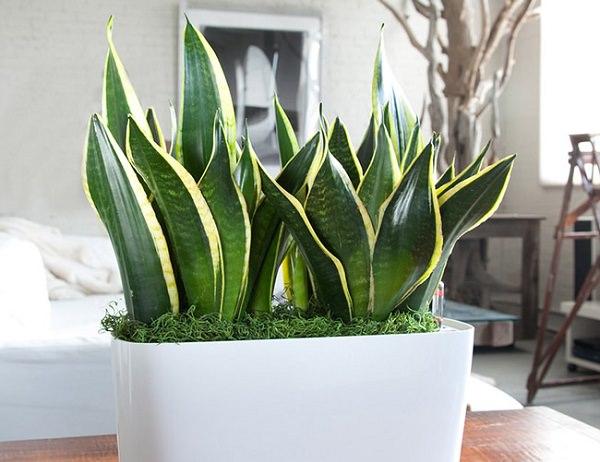
Snake plant is one of the best plants for the beginners. Easy to grow and hard to kill, it can be grown in low light and need to be watered occasionally. Snake plant also removes toxins from the air– All this makes it a perfect houseplant for beginners.
2. Heartleaf Philodendron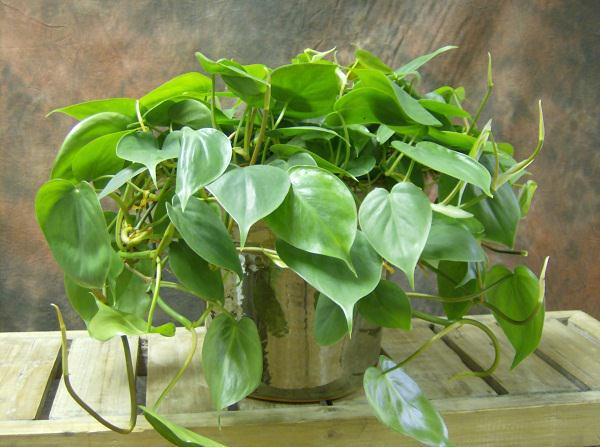
Philodendron scandens is extremely easy to grow and great for beginners. It needs a moderate amount of light and prefers the soil to dry out between watering spells.
3. Spider Plant
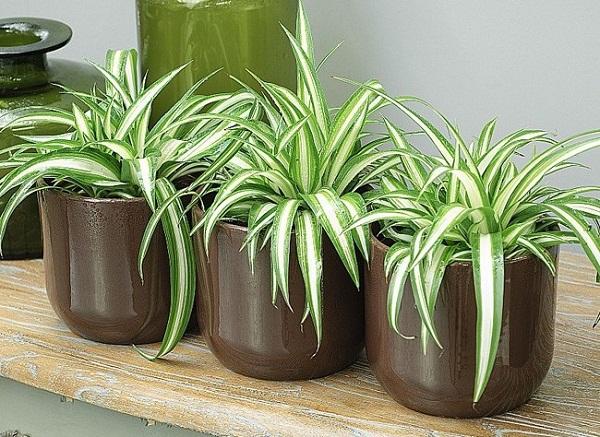
One of the most popular houseplants. Its popularity is due to its toughness and the ease of growing and maintenance. The plant can easily adapt to almost any condition. Keep the plant in a bright spot and maintain slight moisture in the soil and it will grow happily.
4. Peace Lily

The peace lily is among the easiest plants to grow indoors. It can tolerate a wide range of lighting conditions, and needs only moderate watering. With graceful curving leaves and white flower that rise up from the dark foliage, peace lily looks exotic and elegant.
5. English Ivy
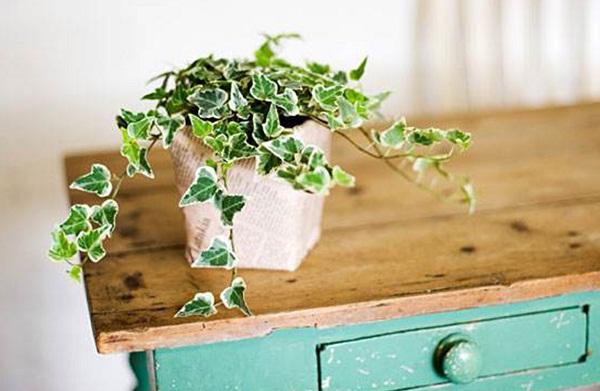
English Ivy is very hardy and easy to grow. Keep the pot in a spot that receives bright indirect sun and plant it in a container that is wide and shallow rather than narrow and deep.
6. Succulents and Cactus

Succulents and cacti are ideal for those who forget to water and care for plants. They are very adaptable and can survive many adverse conditions.
They need to be placed on a bright spot and a well-drained soil with little water.
7. Lucky Bamboo
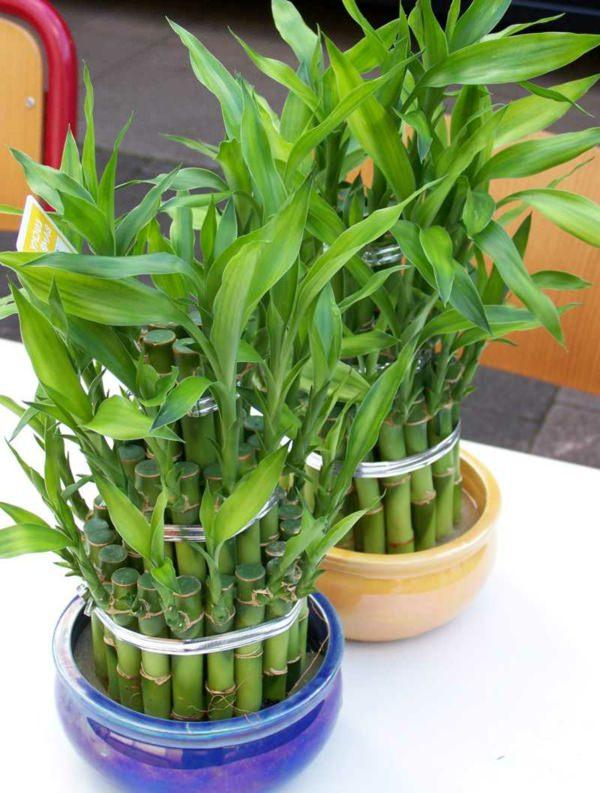
Lucky bamboo is not a bamboo, but a plant belongs to Dracaena genus. It is an easy-care houseplant. Just provide it abundant water and it’ll grow well even in indirect light. Protect the plant from cold drafts and provide iron fertilizer occasionally.
8. Jade Plant
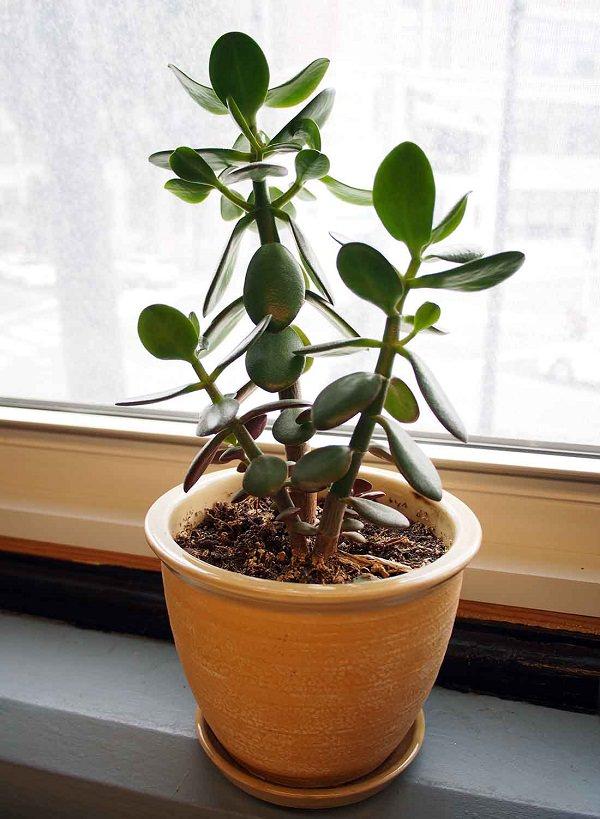
Jade plant is a succulent and is probably one of the best houseplants for beginners. When grown indoors, a jade plant can grow up to a size of a small shrub. Keep the plant in a spot that receives partial or indirect sunlight from having a healthy specimen.
9. Cast Iron Plant
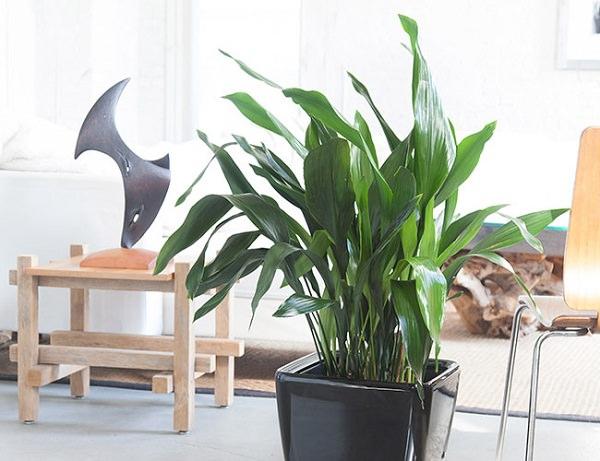
As the name suggest, one of the toughest plants that make it ideal for beginners. Cast-iron plant can withstands neglect, low light, low humidity, and a wide range of temperatures. It prefers moist soil.
10. Peperomia

Credit: Houseplants Expert
Another good plant for beginners is Peperomia. Peperomia is small striking houseplant that is available in different colors and shapes. Peperomia likes slightly moist soil and humidity but watering should be reduced in winter.
11. ZZ Plant
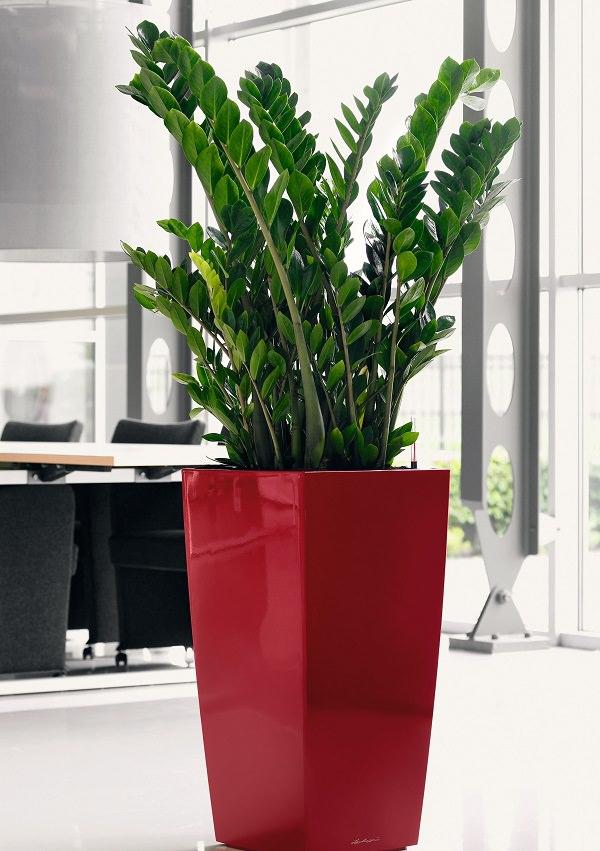
This super-tough plant is high resistant to adverse conditions like drought and low light. The plant prefers bright to moderate indirect light and well-drained soil. ZZ plant can do fine without fertilizer, but if you would like, you can fertilize the plant with half strength general fertilizer one to two times a year in the summer months.
12. Pothos (Devil’s Ivy)
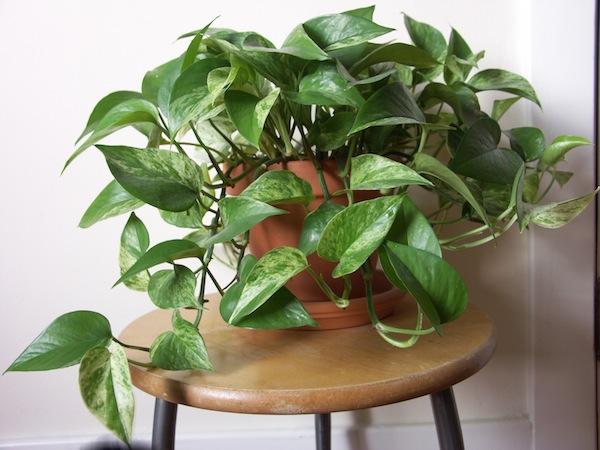
Plants of the pothos family are easy to grow and become great houseplants for beginners. This attractive and durable vine prefers bright indirect light and a draft free place. It can grow in low light and needs moist soil.
13. Dracaena
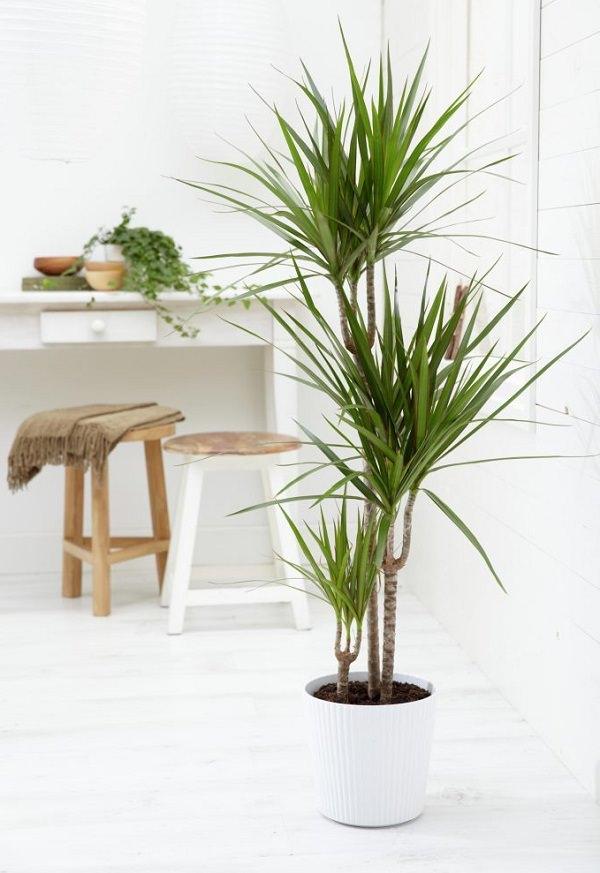
There are many varieties of Dracaena genus that are hardy houseplants, Dracaena marginata, Dracaena fragrans are among the most popular and easy to grow plants. This beautiful houseplant needs occasional pruning and regular watering. Keep the plant away from direct sun and avoid overwatering.
14. Bromeliads
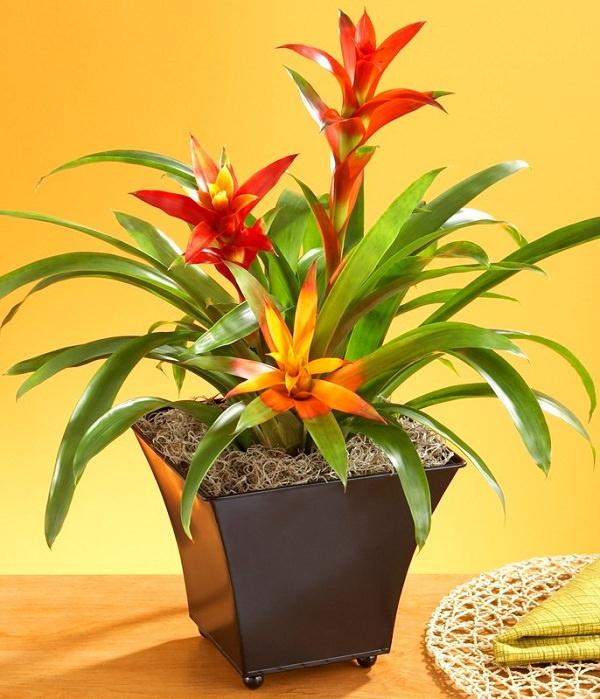
Bromeliad is a perfect plant to grow indoors, most of the varieties of this plant thrive easily indoors. Although it is difficult to make it bloom, there are many varieties that have beautiful foliage that makes an attractive display.
15. Rubber Plant
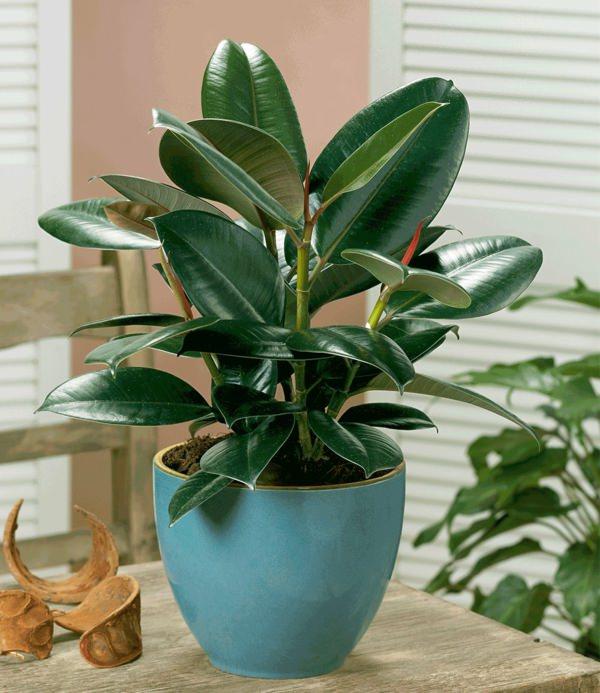
Rubber plant is a large houseplant that can become a focal point to any room. Low maintenance and easy to grow. Keep it in a well-lit position in your home and allow the soil to dry out between watering spells. Besides the ornamental aspect, rubber plant is also an air purifying plant.
Potted houseplants provide a lavish look and can be used to decorate the interior at low cost. Also, they create positive impact and many of them purify the air. But what you’ll do if you don’t have much knowledge about growing plants and the houseplants that are best to grow? Simple! Learn about these 15 Best Houseplants for Beginners! They are easy to grow and tolerate poor conditions.
1. Snake Plant

Snake plant is one of the best plants for the beginners. Easy to grow and hard to kill, it can be grown in low light and need to be watered occasionally. Snake plant also removes toxins from the air– All this makes it a perfect houseplant for beginners.
2. Heartleaf Philodendron

Philodendron scandens is extremely easy to grow and great for beginners. It needs a moderate amount of light and prefers the soil to dry out between watering spells.
3. Spider Plant

One of the most popular houseplants. Its popularity is due to its toughness and the ease of growing and maintenance. The plant can easily adapt to almost any condition. Keep the plant in a bright spot and maintain slight moisture in the soil and it will grow happily.
4. Peace Lily

The peace lily is among the easiest plants to grow indoors. It can tolerate a wide range of lighting conditions, and needs only moderate watering. With graceful curving leaves and white flower that rise up from the dark foliage, peace lily looks exotic and elegant.
5. English Ivy

English Ivy is very hardy and easy to grow. Keep the pot in a spot that receives bright indirect sun and plant it in a container that is wide and shallow rather than narrow and deep.
6. Succulents and Cactus

Succulents and cacti are ideal for those who forget to water and care for plants. They are very adaptable and can survive many adverse conditions.
They need to be placed on a bright spot and a well-drained soil with little water.
7. Lucky Bamboo

Lucky bamboo is not a bamboo, but a plant belongs to Dracaena genus. It is an easy-care houseplant. Just provide it abundant water and it’ll grow well even in indirect light. Protect the plant from cold drafts and provide iron fertilizer occasionally.
8. Jade Plant

Jade plant is a succulent and is probably one of the best houseplants for beginners. When grown indoors, a jade plant can grow up to a size of a small shrub. Keep the plant in a spot that receives partial or indirect sunlight from having a healthy specimen.
9. Cast Iron Plant

As the name suggest, one of the toughest plants that make it ideal for beginners. Cast-iron plant can withstands neglect, low light, low humidity, and a wide range of temperatures. It prefers moist soil.
10. Peperomia

Credit: Houseplants Expert
Another good plant for beginners is Peperomia. Peperomia is small striking houseplant that is available in different colors and shapes. Peperomia likes slightly moist soil and humidity but watering should be reduced in winter.
11. ZZ Plant

This super-tough plant is high resistant to adverse conditions like drought and low light. The plant prefers bright to moderate indirect light and well-drained soil. ZZ plant can do fine without fertilizer, but if you would like, you can fertilize the plant with half strength general fertilizer one to two times a year in the summer months.
12. Pothos (Devil’s Ivy)

Plants of the pothos family are easy to grow and become great houseplants for beginners. This attractive and durable vine prefers bright indirect light and a draft free place. It can grow in low light and needs moist soil.
13. Dracaena

There are many varieties of Dracaena genus that are hardy houseplants, Dracaena marginata, Dracaena fragrans are among the most popular and easy to grow plants. This beautiful houseplant needs occasional pruning and regular watering. Keep the plant away from direct sun and avoid overwatering.
14. Bromeliads

Bromeliad is a perfect plant to grow indoors, most of the varieties of this plant thrive easily indoors. Although it is difficult to make it bloom, there are many varieties that have beautiful foliage that makes an attractive display.
15. Rubber Plant

Rubber plant is a large houseplant that can become a focal point to any room. Low maintenance and easy to grow. Keep it in a well-lit position in your home and allow the soil to dry out between watering spells. Besides the ornamental aspect, rubber plant is also an air purifying plant.
0
2
文章
Colorful
2017年05月23日

Love the color purple? Then grow these 15 GORGEOUS purple houseplants known for their colorful foliage and warm texture!1. Purple Oxalis
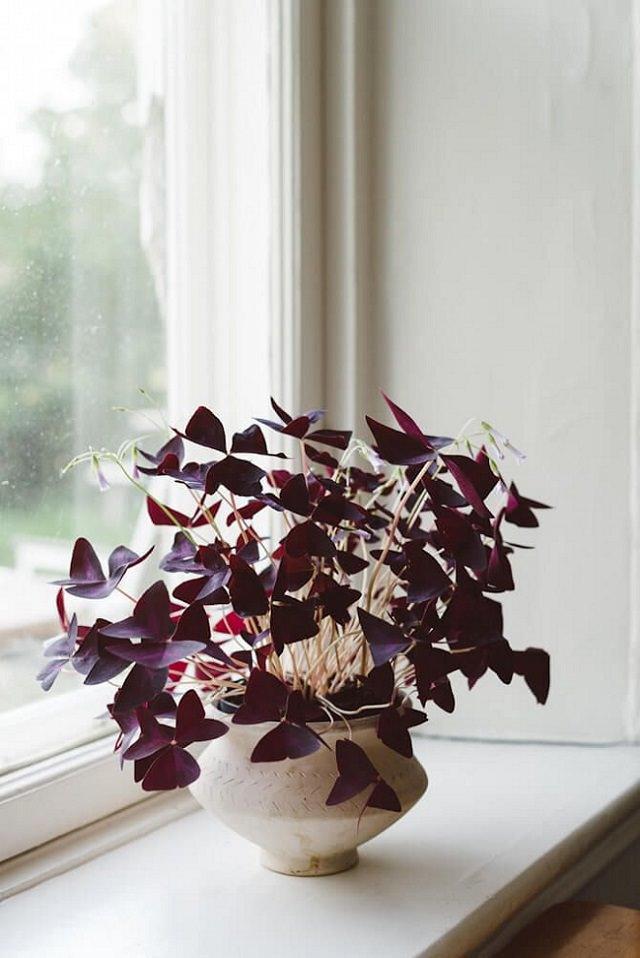
Native to Brazil, Oxalis plants display unique, pinwheel foliage and a wealth of starry blossoms. Some varieties produce purple leaves or foliage with deeper accent markings. Its delicate foliage and dainty flowers make it an ideal choice for containers and indoors alike. The tiny, triangular leaflets close at night, which make it a fun plant to have around the house.
2. Coleus
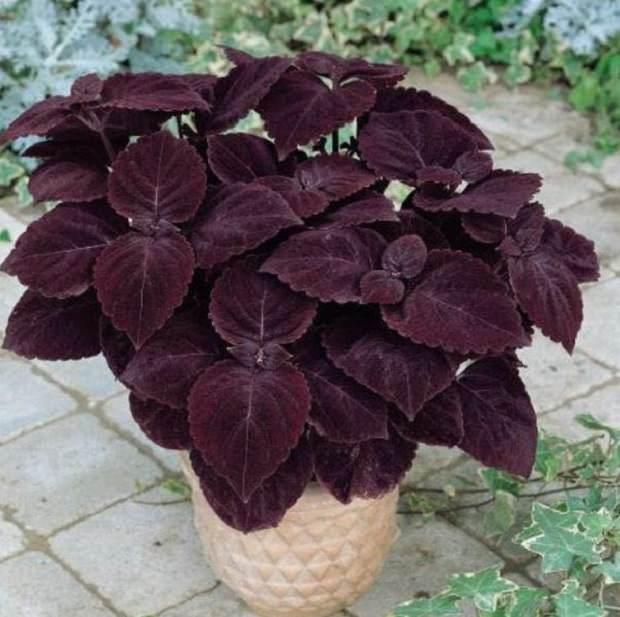
Coleus is a beautiful, showy plant that is available in various colors and styles. Mostly used as an annual for outdoor gardens, it is super easy to grow as an indoor plant as well. The vibrancy of its colors comes from receiving an adequate amount of sunlight. The more the light, the more vivid the colors. However, shade does allow the colors to form as well, though they will be a tad subdued. Coleus is remarkably easy to propagate. The eye-catchy, fancy leaves can liven up a dull drawing room, while the compact structure does justice to space-constrained corners well.
3. Prayer Plant
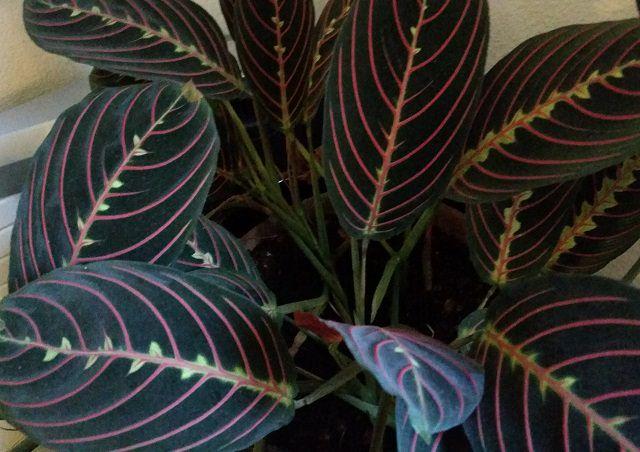
The prayer plant, with its unusual, purplish brown leaf markings is a fun little plant to have around the house. Also known as rabbit tracks, it has two different varieties, the green, and the red one. The latter has bold red leaf veins alongside the markings. Leaves close at night, thereby creating the appearance of praying hands. Prayer plant thrives well on moderately high humidity and uniformly watered soil. However, it appreciates remaining on a drier side in winter.
4. Sweet Caroline ‘Purple’ Potato Vine

We love this! One of the most gorgeous and versatile plants around for CONTAINER GARDENERS, sweet potato vine, performs well in both partial sun and shade and looks pretty in container gardens, borders, garden beds and landscapes. The plant is mainly loved for its brilliant foliage that is available in different colors of lime, purple, bronze, black or copper. And since its beauty comes from its leaf, the plant can be enjoyed all year long without having to wait for the blooms to show up. Sweet potato vine grows best in the moist and well-drained soil. It is remarkably flexible regarding light requirements.
5. Wandering Jew

A unique, easy to grow houseplant, the Wandering Jew is a popular houseplant that is both easy to grow and looks amazing in a hanging basket as well as in a topiary form. The most widely available variety of this vine has leaves marked with characteristic olive and silver markings on the top and a dark purplish maroon color on the undersides. Some varieties flaunt a purplish color on both surfaces of the leaves. Wandering Jew thrives well on medium to bright low light and uniformly-watered soil. You can grow this plant from stem cuttings stuck in water or a moist potting soil. It’s recommended to allow the soil to dry in between watering spells.
6. Ti Plant

Ti plant is an astonishing red-purple colored houseplant featuring flamboyantly colored foliage and an elegant appeal; the ti plant is a perfect choice for adding a pop of color, style, and drama to a well-lit corner of your room. Most varieties have strap-like leaves variegated with bright streaks of different colors of hot pink, white, cream, or deeper shades of purple. Ti plant is picky about sunlight and likes to be in a spot that receives a partial sun.
7. Rex Begonia
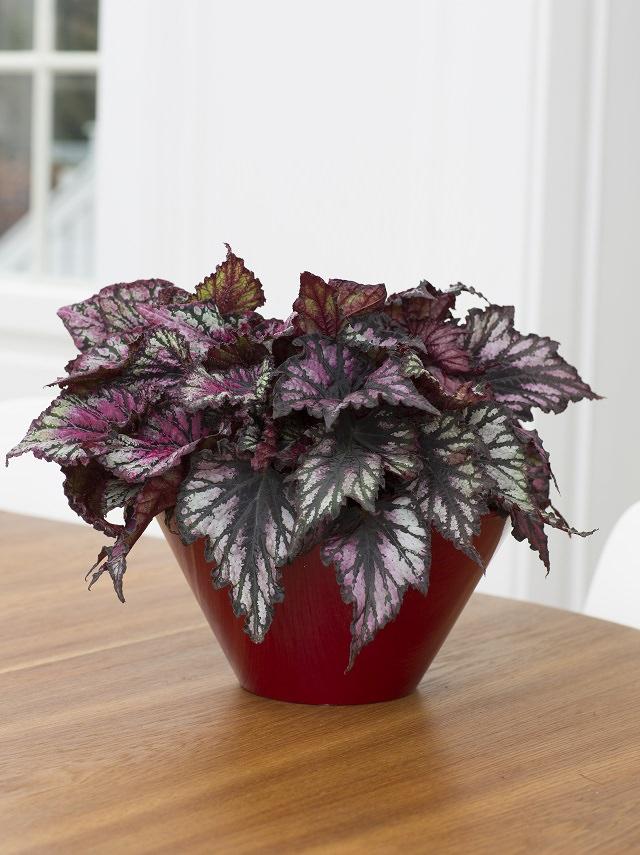
Rex begonia plants are cherished for their dramatically colored and textured foliage. The leaves come in a broad spectrum of colors, shapes, and stripes. While the flowers are insignificant, the unique leaf shapes and attractive color combinations of silver, red, purple, white and pink pretty much makes up for it. Rex begonia mostly enjoys shade gardens, which makes it apt for indoor gardening. Soggy soil and excessive use of fertilizers lead to instant rotting, while prolonged wet leaves make them susceptible to infection. If you keep these in mind, caring for your Rex begonia plant will be a breeze.
8. Purple Passion (Gynura Aurantiaca)
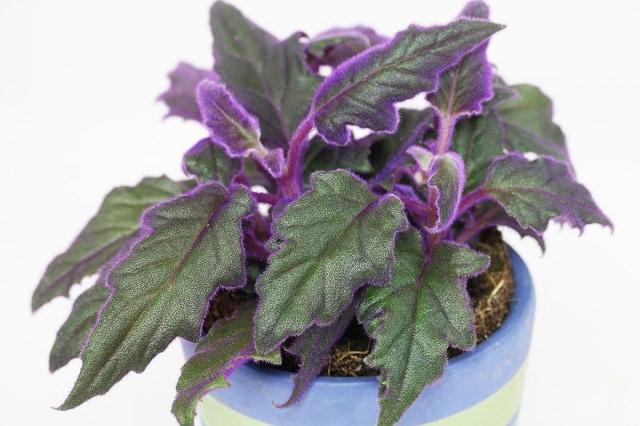
This lovely houseplant has fuzzy green foliage with a dab of purple hairs and edges. Grow it in any neutral colored houseplant, and you’ll see how it’ll stand out from the other houseplants. Its characteristic purple sheen comes when it is touched by a fleck of sunlight. Purple passion has an upright habit when young and becomes more vine-like and spreading as it matures. This makes it a perfect choice for adorning hanging baskets and small trellises alike. The plant enjoys the bright light and evenly moist soil.
9. Caladium

Caladiums are beautiful tropical plants with big, wafer-thin leaves having varying patterns in reds, pink, purple and cream. The brilliant foliage of this plant is its USP, as it is available in unusual shapes like hearts, lances or arrows, as well as eye-catchy color combinations of red, pink, rose and white. Being a shade plant, it doesn’t mind growing indoors, though it requires a minimum of 3-4 hours of filtered light each day.
10. Waffle Plant
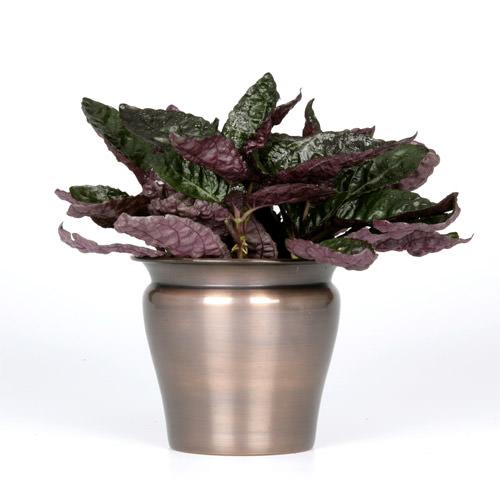
The waffle plant is a beautiful tiny houseplant with colorful foliage having a metallic tone in purple color, the striking appearance, which makes it an excellent addition to your home or office. Its small stature makes it ideal for decorating crammed-up desks or countertops, while its low growing nature makes it suitable for use as a groundcover underneath larger indoor plants like ficus trees. Waffle plant benefits from medium to bright light indoors. Remember, if it doesn’t get adequate sunlight, it may lose its vibrant purple coloring. However, direct light is a hazard as the leaves may bleach and undergo sunburn. Accent the waffle plant’s brilliant foliage with a terracotta container for a classic appeal.
11. Red Aglaonema
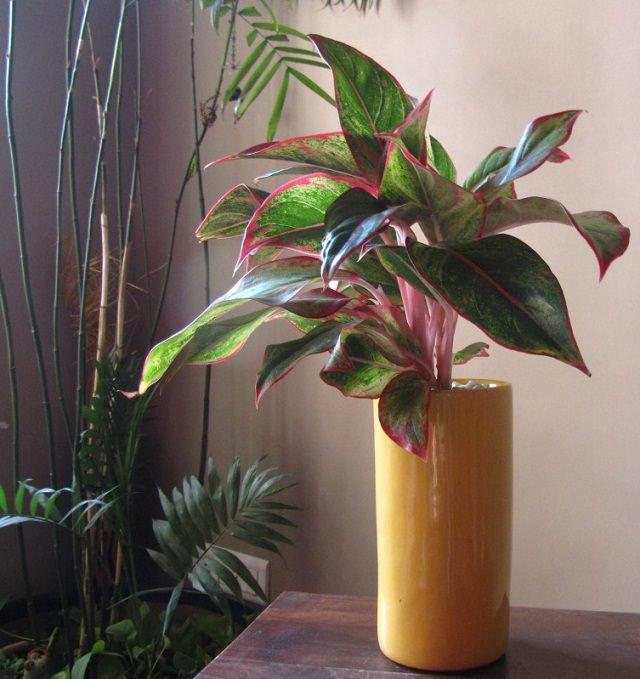
Red aglaonema is a spectacular Chinese evergreen plant with stunning, purple or red-tinted leaves. One of the easiest houseplants to grow, red aglaonema, is a new and stylish entree to the world of houseplants. This beauty flaunts dark green leaves marked elegantly with bright red, purple or pink stripes. Its colorful foliage makes it apt for decorating desks, tabletops, coffee tables as well as side tables in bedrooms. You can also consider using it as a substitute for poinsettia this season. The long-lived houseplant retains its color all through the year and demands little care in the process.
12. Calathea
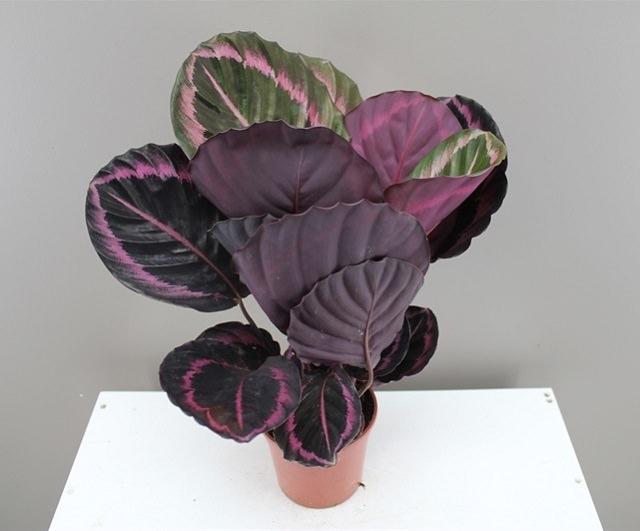
The calathea is one of the most beautiful houseplants that has the potential to light up any room with colorful accents. With a special marking of stark white veins against red, purple, green and cream leaves, the calathea lends an exciting and fashionable touch to your home. Most varieties have reddish purple color on the undersides of leaves, which makes them attractive when viewed from both above or below.
13. Iron-Cross Begonia
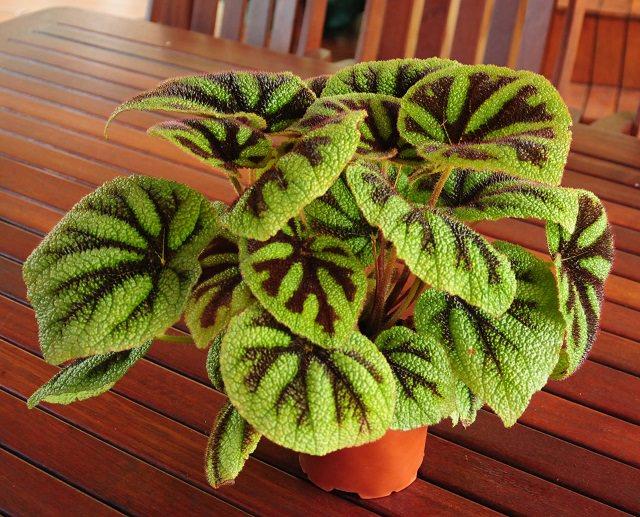
This beautiful New Guinea species is a must for you if you love growing unique indoor plants. Its leaves sport wide, chocolate-brown markings which stand out well against the dark green backdrop and radiate all the way to the leaf margins, thereby resembling the German iron cross. The beautiful coloration set against solid green with a coarse, pebbled texture makes for a very royal presence that is sure to liven up your home like none other. The plant prefers humid conditions, though you are best off cutting back on the water amount if you notice yellowing or browning of the leaves.
14. Rubber Tree (Ficus elastica)
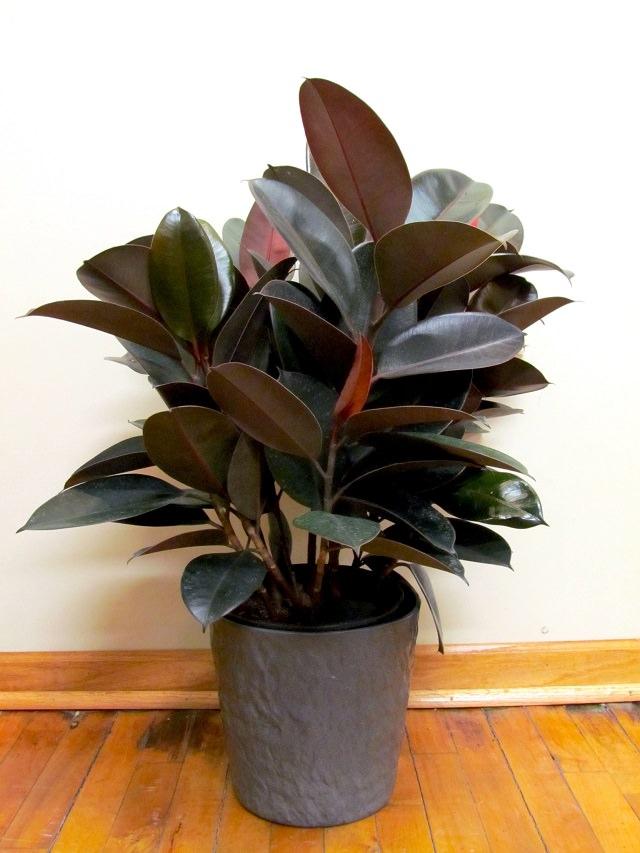
The mention of rubber tree immediately conjures up images of latex oozing out from barks. True that but it is one of the most popular houseplants today and why not it looks impressive indoors and cleanse the air too. Its leaves appear dark purple when mature, and bright red when young and opening. Learn how to grow a rubber tree houseplant here!
Also Read: Plants for Restful Sleep
15. Silver Squill

Contrary to its name, silver squill is a tough little plant. Hailing from the Cape Province of South Africa, it grows in dry habitats and stores moisture in its succulent, bulb-like stems as an adaptation tactic against the moisture-deprived soil. With its unique structure and colorful foliage, it becomes an unusual houseplant, which is sure to attract plenty of eyeballs. The plant derives its name from the lovely, silver-colored polka dots on leaves and the rich purple undersides of the stems. It’s easy to care as well, provided you grow them in the shade.

Native to Brazil, Oxalis plants display unique, pinwheel foliage and a wealth of starry blossoms. Some varieties produce purple leaves or foliage with deeper accent markings. Its delicate foliage and dainty flowers make it an ideal choice for containers and indoors alike. The tiny, triangular leaflets close at night, which make it a fun plant to have around the house.
2. Coleus

Coleus is a beautiful, showy plant that is available in various colors and styles. Mostly used as an annual for outdoor gardens, it is super easy to grow as an indoor plant as well. The vibrancy of its colors comes from receiving an adequate amount of sunlight. The more the light, the more vivid the colors. However, shade does allow the colors to form as well, though they will be a tad subdued. Coleus is remarkably easy to propagate. The eye-catchy, fancy leaves can liven up a dull drawing room, while the compact structure does justice to space-constrained corners well.
3. Prayer Plant

The prayer plant, with its unusual, purplish brown leaf markings is a fun little plant to have around the house. Also known as rabbit tracks, it has two different varieties, the green, and the red one. The latter has bold red leaf veins alongside the markings. Leaves close at night, thereby creating the appearance of praying hands. Prayer plant thrives well on moderately high humidity and uniformly watered soil. However, it appreciates remaining on a drier side in winter.
4. Sweet Caroline ‘Purple’ Potato Vine

We love this! One of the most gorgeous and versatile plants around for CONTAINER GARDENERS, sweet potato vine, performs well in both partial sun and shade and looks pretty in container gardens, borders, garden beds and landscapes. The plant is mainly loved for its brilliant foliage that is available in different colors of lime, purple, bronze, black or copper. And since its beauty comes from its leaf, the plant can be enjoyed all year long without having to wait for the blooms to show up. Sweet potato vine grows best in the moist and well-drained soil. It is remarkably flexible regarding light requirements.
5. Wandering Jew

A unique, easy to grow houseplant, the Wandering Jew is a popular houseplant that is both easy to grow and looks amazing in a hanging basket as well as in a topiary form. The most widely available variety of this vine has leaves marked with characteristic olive and silver markings on the top and a dark purplish maroon color on the undersides. Some varieties flaunt a purplish color on both surfaces of the leaves. Wandering Jew thrives well on medium to bright low light and uniformly-watered soil. You can grow this plant from stem cuttings stuck in water or a moist potting soil. It’s recommended to allow the soil to dry in between watering spells.
6. Ti Plant

Ti plant is an astonishing red-purple colored houseplant featuring flamboyantly colored foliage and an elegant appeal; the ti plant is a perfect choice for adding a pop of color, style, and drama to a well-lit corner of your room. Most varieties have strap-like leaves variegated with bright streaks of different colors of hot pink, white, cream, or deeper shades of purple. Ti plant is picky about sunlight and likes to be in a spot that receives a partial sun.
7. Rex Begonia

Rex begonia plants are cherished for their dramatically colored and textured foliage. The leaves come in a broad spectrum of colors, shapes, and stripes. While the flowers are insignificant, the unique leaf shapes and attractive color combinations of silver, red, purple, white and pink pretty much makes up for it. Rex begonia mostly enjoys shade gardens, which makes it apt for indoor gardening. Soggy soil and excessive use of fertilizers lead to instant rotting, while prolonged wet leaves make them susceptible to infection. If you keep these in mind, caring for your Rex begonia plant will be a breeze.
8. Purple Passion (Gynura Aurantiaca)

This lovely houseplant has fuzzy green foliage with a dab of purple hairs and edges. Grow it in any neutral colored houseplant, and you’ll see how it’ll stand out from the other houseplants. Its characteristic purple sheen comes when it is touched by a fleck of sunlight. Purple passion has an upright habit when young and becomes more vine-like and spreading as it matures. This makes it a perfect choice for adorning hanging baskets and small trellises alike. The plant enjoys the bright light and evenly moist soil.
9. Caladium

Caladiums are beautiful tropical plants with big, wafer-thin leaves having varying patterns in reds, pink, purple and cream. The brilliant foliage of this plant is its USP, as it is available in unusual shapes like hearts, lances or arrows, as well as eye-catchy color combinations of red, pink, rose and white. Being a shade plant, it doesn’t mind growing indoors, though it requires a minimum of 3-4 hours of filtered light each day.
10. Waffle Plant

The waffle plant is a beautiful tiny houseplant with colorful foliage having a metallic tone in purple color, the striking appearance, which makes it an excellent addition to your home or office. Its small stature makes it ideal for decorating crammed-up desks or countertops, while its low growing nature makes it suitable for use as a groundcover underneath larger indoor plants like ficus trees. Waffle plant benefits from medium to bright light indoors. Remember, if it doesn’t get adequate sunlight, it may lose its vibrant purple coloring. However, direct light is a hazard as the leaves may bleach and undergo sunburn. Accent the waffle plant’s brilliant foliage with a terracotta container for a classic appeal.
11. Red Aglaonema

Red aglaonema is a spectacular Chinese evergreen plant with stunning, purple or red-tinted leaves. One of the easiest houseplants to grow, red aglaonema, is a new and stylish entree to the world of houseplants. This beauty flaunts dark green leaves marked elegantly with bright red, purple or pink stripes. Its colorful foliage makes it apt for decorating desks, tabletops, coffee tables as well as side tables in bedrooms. You can also consider using it as a substitute for poinsettia this season. The long-lived houseplant retains its color all through the year and demands little care in the process.
12. Calathea

The calathea is one of the most beautiful houseplants that has the potential to light up any room with colorful accents. With a special marking of stark white veins against red, purple, green and cream leaves, the calathea lends an exciting and fashionable touch to your home. Most varieties have reddish purple color on the undersides of leaves, which makes them attractive when viewed from both above or below.
13. Iron-Cross Begonia

This beautiful New Guinea species is a must for you if you love growing unique indoor plants. Its leaves sport wide, chocolate-brown markings which stand out well against the dark green backdrop and radiate all the way to the leaf margins, thereby resembling the German iron cross. The beautiful coloration set against solid green with a coarse, pebbled texture makes for a very royal presence that is sure to liven up your home like none other. The plant prefers humid conditions, though you are best off cutting back on the water amount if you notice yellowing or browning of the leaves.
14. Rubber Tree (Ficus elastica)

The mention of rubber tree immediately conjures up images of latex oozing out from barks. True that but it is one of the most popular houseplants today and why not it looks impressive indoors and cleanse the air too. Its leaves appear dark purple when mature, and bright red when young and opening. Learn how to grow a rubber tree houseplant here!
Also Read: Plants for Restful Sleep
15. Silver Squill

Contrary to its name, silver squill is a tough little plant. Hailing from the Cape Province of South Africa, it grows in dry habitats and stores moisture in its succulent, bulb-like stems as an adaptation tactic against the moisture-deprived soil. With its unique structure and colorful foliage, it becomes an unusual houseplant, which is sure to attract plenty of eyeballs. The plant derives its name from the lovely, silver-colored polka dots on leaves and the rich purple undersides of the stems. It’s easy to care as well, provided you grow them in the shade.
2
1
文章
Colorful
2017年05月23日

Take a look at these 19 Best low maintenance houseplants, if you’re new to growing plants indoors or find yourself lazy.
There are plenty of good things about having plants in the house. For starters, they clean up the air and smell wonderful. Secondly, they add a much-needed dash of color and accentuate the appeal of your interior.
1. Snake Plant
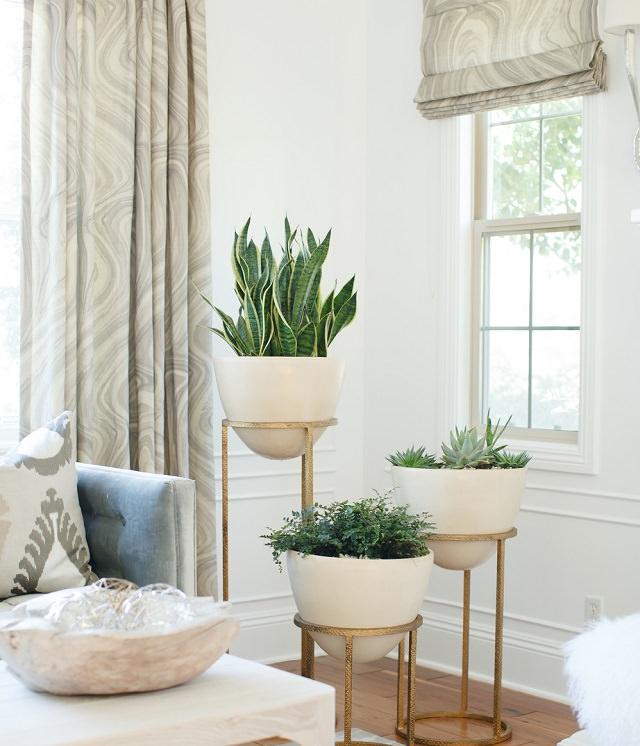
The snake plant is a low-maintenance succulent plant that thrives on neglect pretty well. If you have had little success with indoor gardening , do give the snake plant a try. All types of snake plant tolerate low light and prefer being potbound. The fact that it has thick and waxy leaves means it can withstand scarcity of water for prolonged periods of time. To put it simply, the snake plant is apt for lazy gardeners and two-week vacationers.
2. Tillandsia (Air Plants)
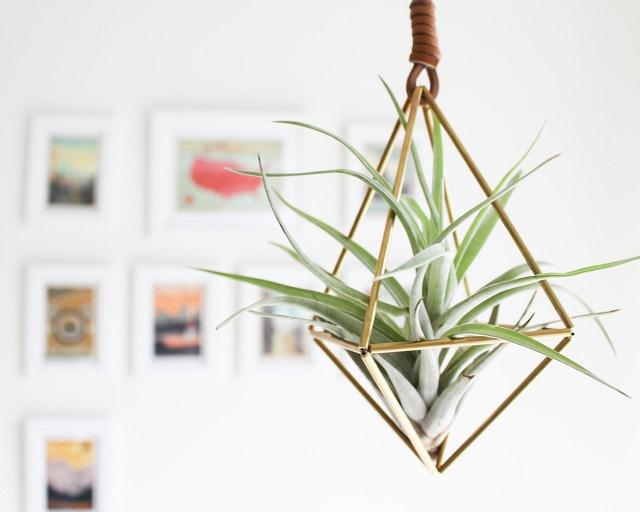
Tillandsia is a genus of air plants native to the deserts, forests and mountains of central and South America. Air plants are epiphyte, meaning they don’t need soil to grow. All you need is to mist or water them up once in a week. Some of the air plants also absorb dust– All this makes them interesting and low-maintenance houseplants. The air plants are a perfect choice for people who wish to add a touch of green to their home without much work.
3. Cast-Iron Plant

The cast-iron plant is true to its name- it’s literally indestructible. It can withstand extremes of conditions, including low light, low humidity, as well as a wide spectrum of temperatures. And it grows slowly, which means you don’t need to repot it often.
4. Kalanchoe

Kalanchoe is a genus of tropical succulent flowering plants, from the wide-leafed and bright ‘Flapjack’ to the compact Kalanchoe manginii or Kalanchoe blossfeldiana. Kalanchoes are easy to grow, all they ask for is a sunny spot and an occasional spritz of water. Both these varieties are architecturally interesting and last for so long with little attention from your end.
5. Philodendron
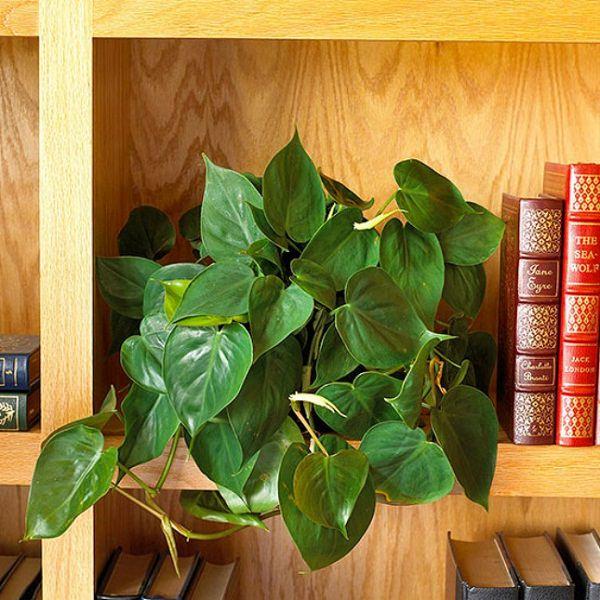
Philodendron is a fast-growing foliage houseplant with bottle-green heart-shaped leaves, similar to pothos. This plant is extremely durable and adapts well to low-light areas. Philodendron looks great in hanging baskets or when branches trailing down from above.
6. ZZ Plant
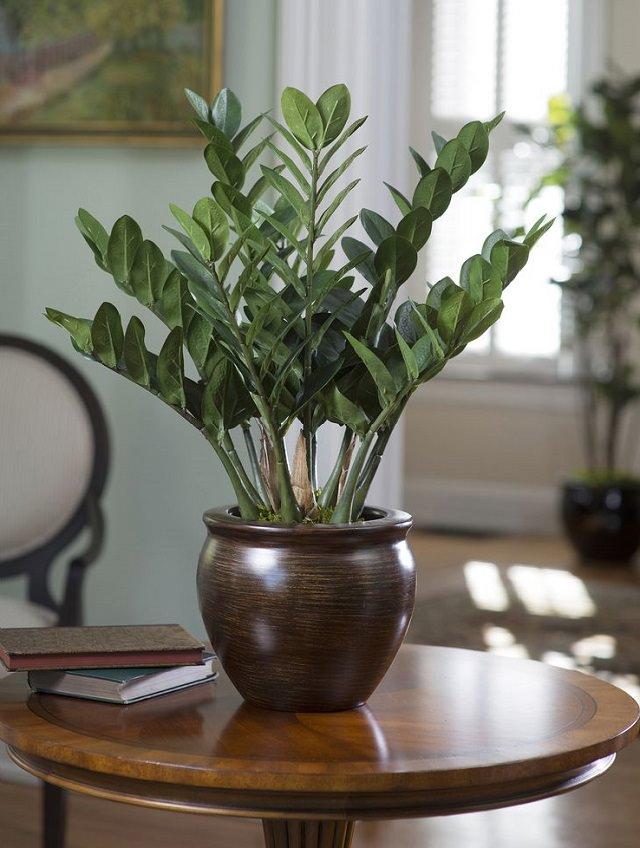
The ZZ plant is also known as the eternity plant as it lasts so long that it’s practically a challenge to kill it! Its fat succulent leaves are thick, fleshy leafstalks are so durable that they can be easily mistaken for plastic. Since the plant is a slow grower, you may want to purchase a large plant if in case you need a big specimen for your house.
7. Bromeliad
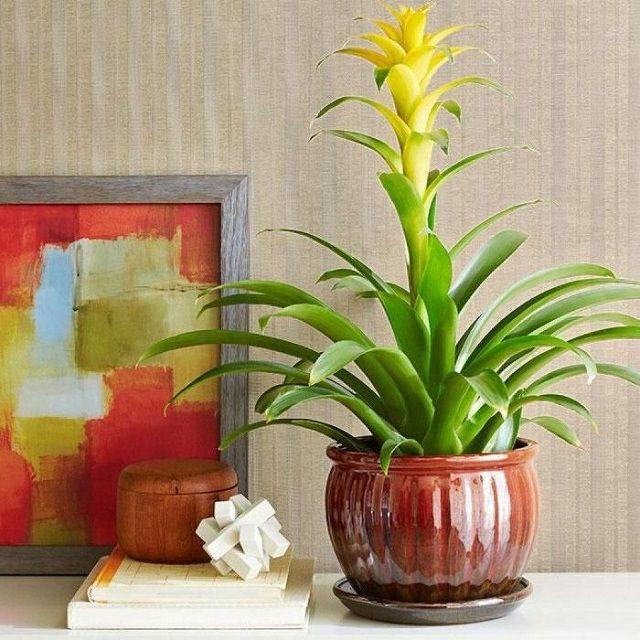
Bromeliad, like pineapple, belongs to the bromeliacea family. This plant produces a delicate pink inflorescence that is beautiful to look at. It lasts long too, and occasionally produces new side shoots that replace the original ones.
8. Jade Plant
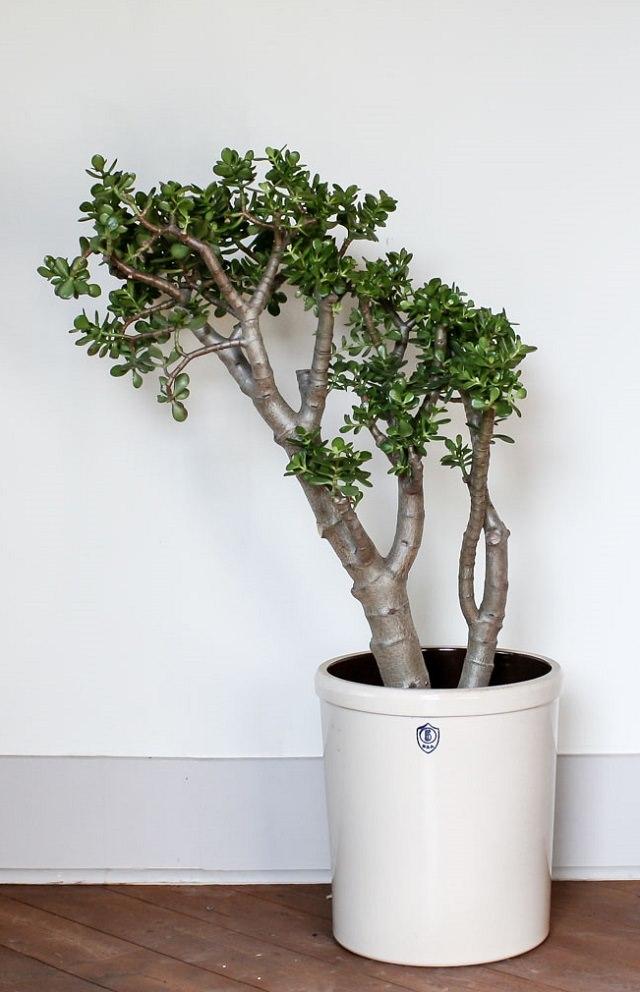
Native to South America, Jade is a low maintenance indoor plant. A succulent that retains water in its round, fleshy leaves. They thrive on neglect, so all you need to do is place them in a bright and airy spot and you’re done. As the thick trunk of jade plant easily gives it a mature look, it is also good for bonsai making.
Also Read: Best Plants and Trees for Bonsai
9. Succulents
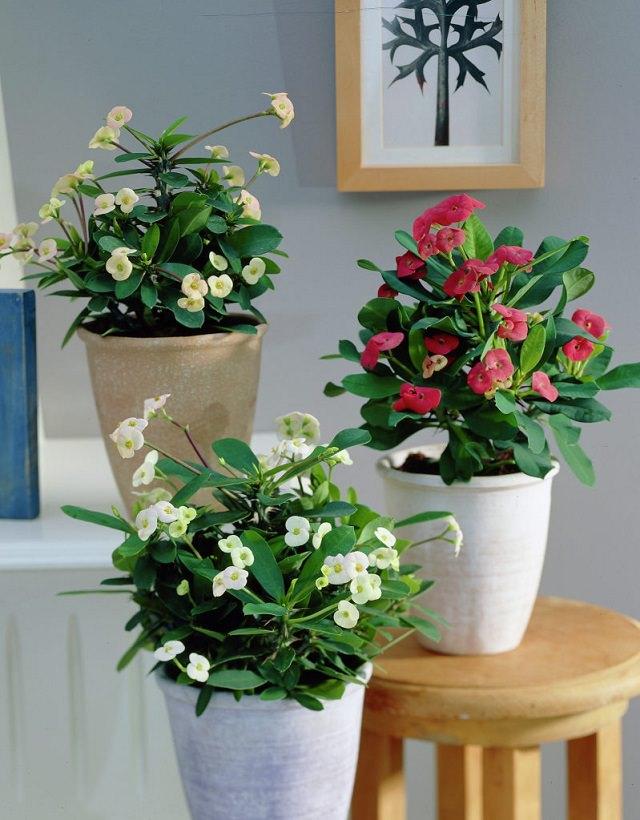
Whether its Crown of thorns or any other succulent most of them are the plants that are easy to grow indoors. Especially for those who forget to water the plants for days. If you’re interested in knowing more about the succulents that are easy to grow click here!
10. Pothos

Pothos is a fast-growing, leafy vine with striking variegated leaves that are tolerant to both irregular watering and low light conditions. The vine extends quickly, often leaving a 10-feet long, green trail over shelves or furniture. Though it’s not as drought-tolerant as many other plants in this list and demands some attention from you when it comes to watering.
11. Peace Lily

The peace lily is an easy-to-care houseplant that tolerates low light and low humidity really well and it seems like it is made for indoor conditions. Glossy, lance-shaped foliage with arched stems that surround the central flower spikes. It produces spoon-shaped blooms in summer usually but some varieties do blossom intermittently throughout the year. As an added bonus, it purifies noxious substances like formaldehyde and carbon monoxide from the air. If growing in a large pot peace lily can even go without water for a month. These plants thrive better on under-watering conditions.
12. Begonia
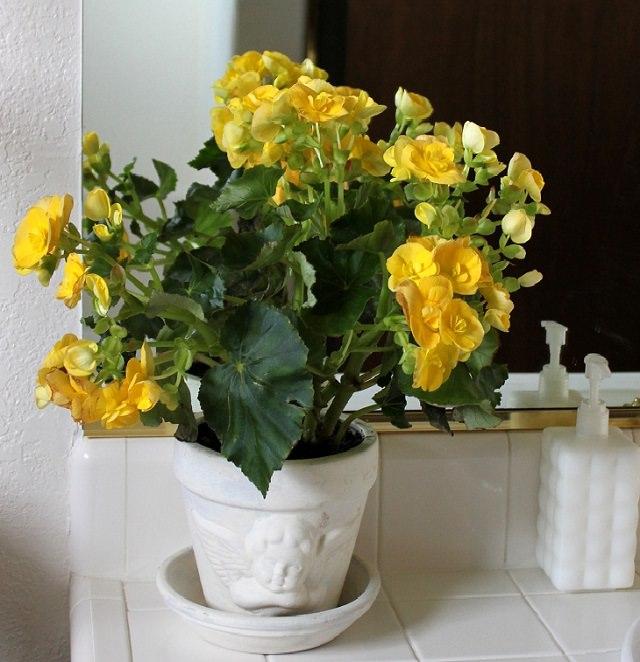
Begonias, with lush, green leaves and satiny flowers paint a pretty picture. Though they are more often thought of as outdoor plants, the fibrous and rhizomatous variants perform well indoors. They prefer humid environments, so you may want to water them 2-3 times a week in summer to make sure they stay healthy and green. They are not that fussy about light/temperature conditions. Bright, indirect sunlight works fine for them.
13. Aloe

Especially, Aloe Vera is one of the most multi-purpose houseplants in Aloe genus you can choose for indoor gardening. Its plump, spiraling leaves ooze out a soothing gel that can be used for burns and cuts. You can use it to relieve sunburns and even ingest its gel for a minty, cool feeling. Aloe loves to have some direct light and a moderate spritz of water every week or two.
Also Read: How to Care for an Aloe Plant
14. Boston Fern
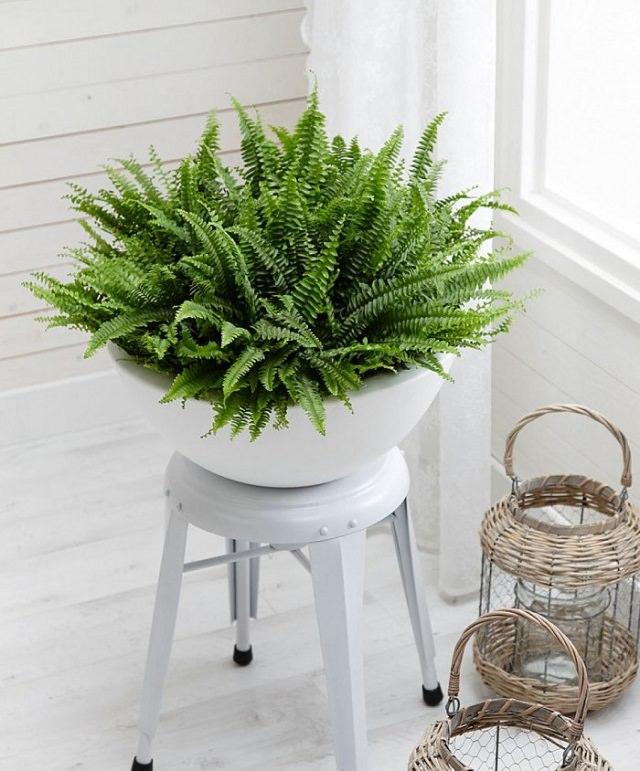
Renowned since the Victorian times, Boston fern is one of the most popular variants of fern. With its delicate, frilly leaves and lush, hanging fronds, it looks aesthetic when displayed in baskets hanging down from ceilings. Being the most drought-tolerant fern, it is easy to care for. All you have to do is to place it in a spot that gets indirect light, avoid dry air. Misting the plant in every few days also help by providing humidity.
15. Dracaena

The plants from Dracaena genus perform well as an indoor plant. They become great houseplants as they are tolerant to extreme indoor conditions. For instance, they survive well in under-watered soil. Additionally, they are not picky about light exposure. The young plants look great on tabletops, while the larger ones require sizable floor space improving the appearance of home and offices.
16. English Ivy
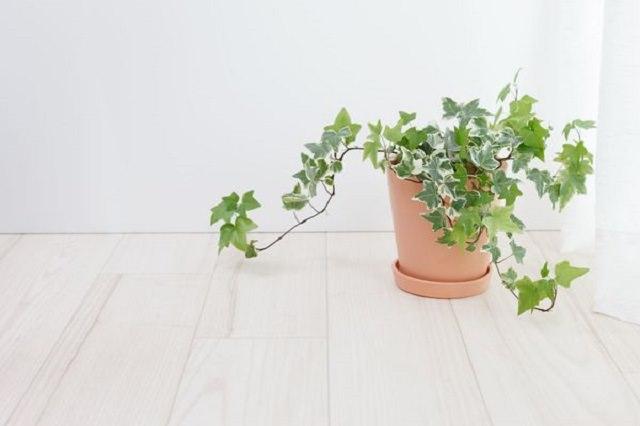
This plant is well known for its evergreen foliage. It is easy to maintain and needs as little as evenly moist soil and bright indirect light to grow well. The stems tend to grow long but can be easily controlled with pruning. For the best display, place your English ivy on a mantel where the stems can hang down luxuriantly.
17. Ponytail Palm

Contrary to its name, the ponytail palm isn’t a palm, in fact, it’s a succulent! AND; we love it. We listed it on our list of best succulents, easiest houseplants, and the best tall and large indoor plants. Don’t forget to check out these articles! It is a slow-growing plant, which means you don’t need to change the pot often. It performs best in sunny spots but never mind low lit areas receiving only bright indirect sunlight day long, also, the plant has low watering needs.
18. Spider Plant
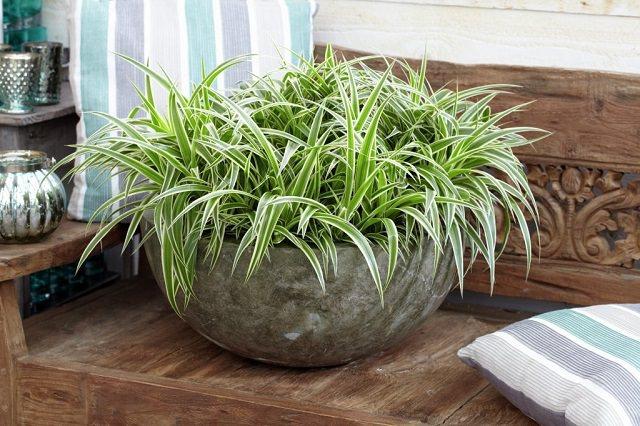
Spider plant is one of the most grown low maintenance houseplants. This forgiving plant doesn’t mind irregular watering and goes for weeks without water if grown in cool indoor conditions. Keeping the spider plant in low light conditions without direct sunlight is also possible.
Also Read: Plants that Grow without Sunlight
19. Rubber Tree Plant
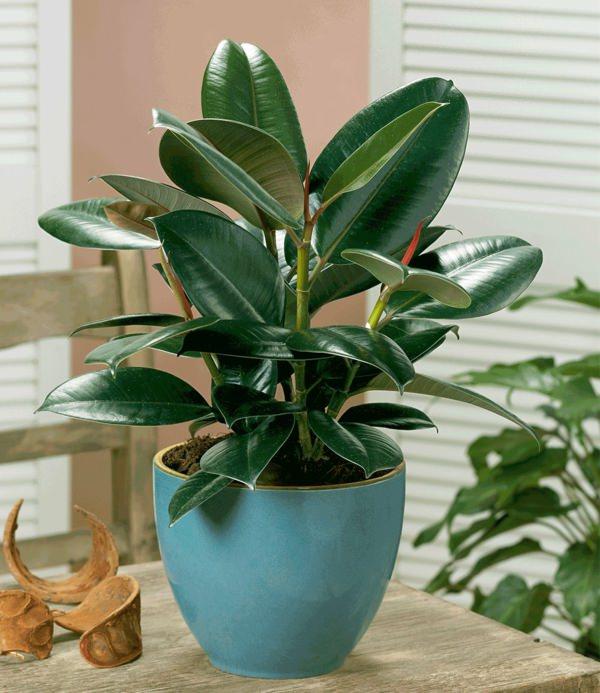
Rubber tree plant is an air purifying plant, it cleanses the formaldehyde. It is not difficult to grow and you can easily keep it in your home or office in a spot that is bright and receives a couple of hours of sunlight if possible. Avoid the exposure of the plant to the intense sun in afternoon.
There are plenty of good things about having plants in the house. For starters, they clean up the air and smell wonderful. Secondly, they add a much-needed dash of color and accentuate the appeal of your interior.
1. Snake Plant

The snake plant is a low-maintenance succulent plant that thrives on neglect pretty well. If you have had little success with indoor gardening , do give the snake plant a try. All types of snake plant tolerate low light and prefer being potbound. The fact that it has thick and waxy leaves means it can withstand scarcity of water for prolonged periods of time. To put it simply, the snake plant is apt for lazy gardeners and two-week vacationers.
2. Tillandsia (Air Plants)

Tillandsia is a genus of air plants native to the deserts, forests and mountains of central and South America. Air plants are epiphyte, meaning they don’t need soil to grow. All you need is to mist or water them up once in a week. Some of the air plants also absorb dust– All this makes them interesting and low-maintenance houseplants. The air plants are a perfect choice for people who wish to add a touch of green to their home without much work.
3. Cast-Iron Plant

The cast-iron plant is true to its name- it’s literally indestructible. It can withstand extremes of conditions, including low light, low humidity, as well as a wide spectrum of temperatures. And it grows slowly, which means you don’t need to repot it often.
4. Kalanchoe

Kalanchoe is a genus of tropical succulent flowering plants, from the wide-leafed and bright ‘Flapjack’ to the compact Kalanchoe manginii or Kalanchoe blossfeldiana. Kalanchoes are easy to grow, all they ask for is a sunny spot and an occasional spritz of water. Both these varieties are architecturally interesting and last for so long with little attention from your end.
5. Philodendron

Philodendron is a fast-growing foliage houseplant with bottle-green heart-shaped leaves, similar to pothos. This plant is extremely durable and adapts well to low-light areas. Philodendron looks great in hanging baskets or when branches trailing down from above.
6. ZZ Plant

The ZZ plant is also known as the eternity plant as it lasts so long that it’s practically a challenge to kill it! Its fat succulent leaves are thick, fleshy leafstalks are so durable that they can be easily mistaken for plastic. Since the plant is a slow grower, you may want to purchase a large plant if in case you need a big specimen for your house.
7. Bromeliad

Bromeliad, like pineapple, belongs to the bromeliacea family. This plant produces a delicate pink inflorescence that is beautiful to look at. It lasts long too, and occasionally produces new side shoots that replace the original ones.
8. Jade Plant

Native to South America, Jade is a low maintenance indoor plant. A succulent that retains water in its round, fleshy leaves. They thrive on neglect, so all you need to do is place them in a bright and airy spot and you’re done. As the thick trunk of jade plant easily gives it a mature look, it is also good for bonsai making.
Also Read: Best Plants and Trees for Bonsai
9. Succulents

Whether its Crown of thorns or any other succulent most of them are the plants that are easy to grow indoors. Especially for those who forget to water the plants for days. If you’re interested in knowing more about the succulents that are easy to grow click here!
10. Pothos

Pothos is a fast-growing, leafy vine with striking variegated leaves that are tolerant to both irregular watering and low light conditions. The vine extends quickly, often leaving a 10-feet long, green trail over shelves or furniture. Though it’s not as drought-tolerant as many other plants in this list and demands some attention from you when it comes to watering.
11. Peace Lily

The peace lily is an easy-to-care houseplant that tolerates low light and low humidity really well and it seems like it is made for indoor conditions. Glossy, lance-shaped foliage with arched stems that surround the central flower spikes. It produces spoon-shaped blooms in summer usually but some varieties do blossom intermittently throughout the year. As an added bonus, it purifies noxious substances like formaldehyde and carbon monoxide from the air. If growing in a large pot peace lily can even go without water for a month. These plants thrive better on under-watering conditions.
12. Begonia

Begonias, with lush, green leaves and satiny flowers paint a pretty picture. Though they are more often thought of as outdoor plants, the fibrous and rhizomatous variants perform well indoors. They prefer humid environments, so you may want to water them 2-3 times a week in summer to make sure they stay healthy and green. They are not that fussy about light/temperature conditions. Bright, indirect sunlight works fine for them.
13. Aloe

Especially, Aloe Vera is one of the most multi-purpose houseplants in Aloe genus you can choose for indoor gardening. Its plump, spiraling leaves ooze out a soothing gel that can be used for burns and cuts. You can use it to relieve sunburns and even ingest its gel for a minty, cool feeling. Aloe loves to have some direct light and a moderate spritz of water every week or two.
Also Read: How to Care for an Aloe Plant
14. Boston Fern

Renowned since the Victorian times, Boston fern is one of the most popular variants of fern. With its delicate, frilly leaves and lush, hanging fronds, it looks aesthetic when displayed in baskets hanging down from ceilings. Being the most drought-tolerant fern, it is easy to care for. All you have to do is to place it in a spot that gets indirect light, avoid dry air. Misting the plant in every few days also help by providing humidity.
15. Dracaena

The plants from Dracaena genus perform well as an indoor plant. They become great houseplants as they are tolerant to extreme indoor conditions. For instance, they survive well in under-watered soil. Additionally, they are not picky about light exposure. The young plants look great on tabletops, while the larger ones require sizable floor space improving the appearance of home and offices.
16. English Ivy

This plant is well known for its evergreen foliage. It is easy to maintain and needs as little as evenly moist soil and bright indirect light to grow well. The stems tend to grow long but can be easily controlled with pruning. For the best display, place your English ivy on a mantel where the stems can hang down luxuriantly.
17. Ponytail Palm

Contrary to its name, the ponytail palm isn’t a palm, in fact, it’s a succulent! AND; we love it. We listed it on our list of best succulents, easiest houseplants, and the best tall and large indoor plants. Don’t forget to check out these articles! It is a slow-growing plant, which means you don’t need to change the pot often. It performs best in sunny spots but never mind low lit areas receiving only bright indirect sunlight day long, also, the plant has low watering needs.
18. Spider Plant

Spider plant is one of the most grown low maintenance houseplants. This forgiving plant doesn’t mind irregular watering and goes for weeks without water if grown in cool indoor conditions. Keeping the spider plant in low light conditions without direct sunlight is also possible.
Also Read: Plants that Grow without Sunlight
19. Rubber Tree Plant

Rubber tree plant is an air purifying plant, it cleanses the formaldehyde. It is not difficult to grow and you can easily keep it in your home or office in a spot that is bright and receives a couple of hours of sunlight if possible. Avoid the exposure of the plant to the intense sun in afternoon.
2
1
文章
Colorful
2017年05月23日

Plants grown indoors bring nature into the home but do you know there are plants that can help you sleep better? 14 Best Houseplants for a Restful Sleep. Take a look!
Plants are known to improve the overall appearance of your home, but do you know they also contributes to your overall health? There are plants that are actually known to have soothing properties and help if you have trouble sleeping from time to time, you can benefit from such plants– not only they detoxify your bedroom’s air, but help you get a warm good night sleep as well.
To start, here are 14 of the best plants you can grow. They add warmth, relaxing fragrance and effectively increase oxygen levels in your room, thus giving you a restful sleep. Try adding one of them in your bedroom to get a little dose of zen.1. Jasmine

The jasmine plant features lovely little white flowers and a warm intense scent known to induce relaxing qualities ever since the ancient times. Studies have found that Jasmine has sedative properties and can significantly reduce anxiety levels, thus giving a positive impact on sleep quality.
How to grow: Use soilless potting mix and plant your jasmine in a medium to large size pot. It’s best to place it in a warm spot with full sun exposure (at least 4-5 hours a day).
2. Gardenia
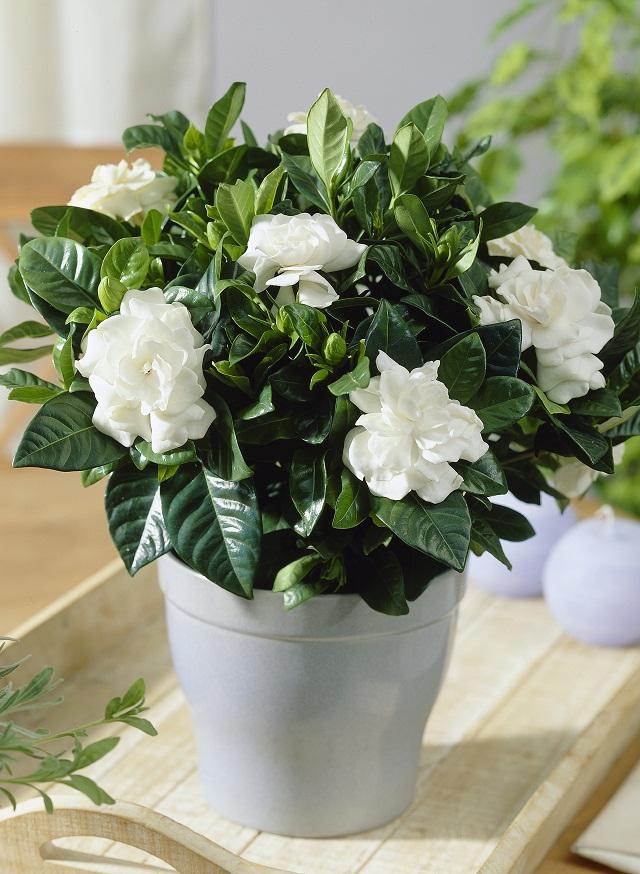
Like the jasmine, gardenia features big white flowers and an intoxicating fragrance that is incomparable– not to mention it also comes with a sedative effect. A study conducted in 2010 has shown that the sweet smell of gardenia flowers has the same effectiveness as that of valium in relaxing the body and brain. So instead of relying on sleeping pills, keeping a gardenia in your bedroom or outside your bedroom window could help you sleep more effectively.
Also Read: Most Fragrant Flowers
How to grow: Gardenia is a fussy plant and requires some care, you can read this growing guide in detail to learn how to grow gardenia in a container.
3. Bamboo Palm

The bamboo palm is great for removing trichloroethylene and benzene, two chemicals which are known to induce respiratory problems, thus a great AIR PURIFYING PLANT. With the plant’s excellent filtering property, you can expect a restful sleep when keeping it in your bedroom. It has been awarded a high purifying score of 8.4 in a study conducted by NASA.
How to grow: Bamboo palm grows perfectly well in shade or in indirect sunlight. It needs a slightly moist soil to thrive but at any case overwatering must be avoided.
Also Read: Best Tall Indoor Plants
4. Valerian
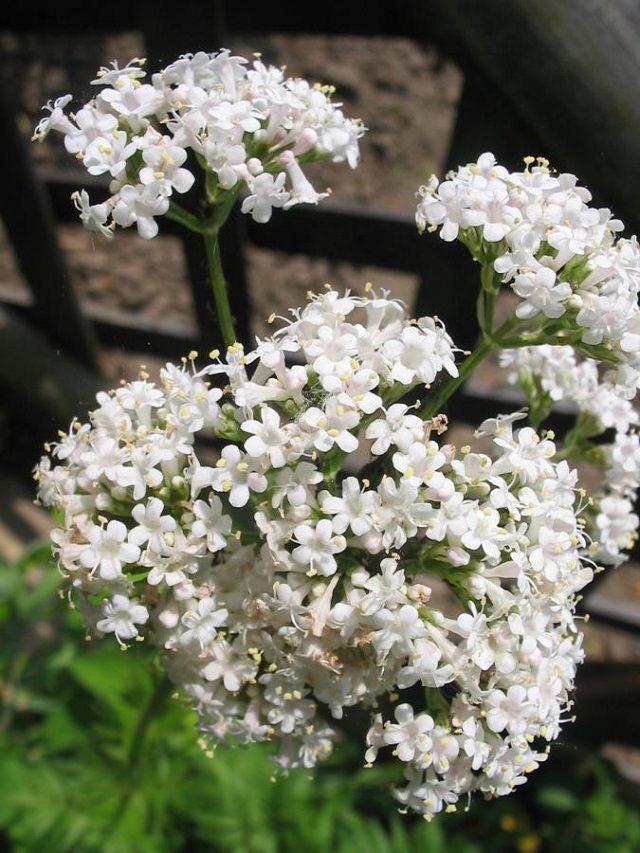
The valerian is a perennial flowering herb which features white, red or pink flowers during summer. It is popular among herbalists in treating anxiety, insomnia, and over-excitability, with its roots being commonly used as an ingredient in mild sedatives. When flowering, the valerian produces a calming vanilla fragrance which induces sleep.
How to grow: The plant will need a minimum sunlight exposure of six hours a day. It’s a good choice if your bedroom has a bright window ledge. It will require rich soil and a lot of water.
Also Read: How to Grow Valerian
5. Honeysuckle
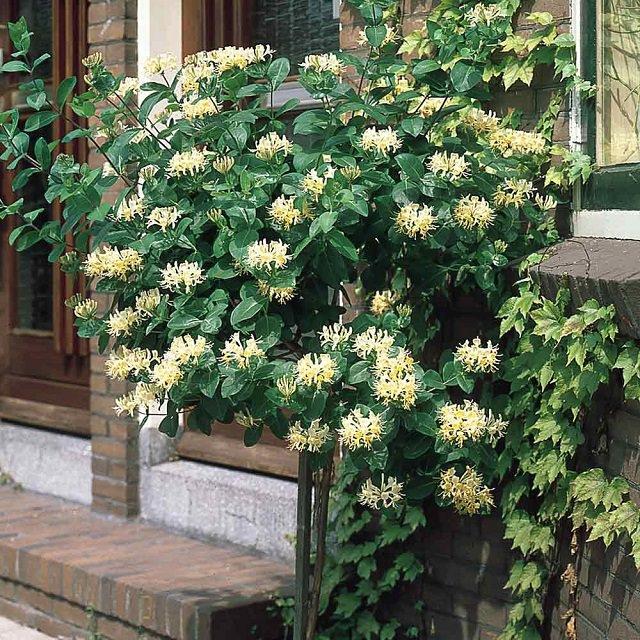
The warm mild fragrance of honeysuckle flowers gets more intense in the dark of the dusk. No wonder, it has the most intoxicating aroma. Growing honeysuckle indoors isn’t practical you may think as it’s a big vine. It is! But you can grow dwarf bush honeysuckle, it’s unique and grow only 4 feet tall. Plant it near a window where it will receive partial sun, it can tolerate shade too.
If you have space try growing a honeysuckle vine outside your bedroom window. Either in a large pot or on the ground.
How to grow: You can grow dwarf honeysuckle indoors near a south or west facing window that receives at least 5-6 hours of sun. Also, the honeysuckle prefers slightly moist soil so keep care of it.
Also Read: Best Vines for Containers
6. Rubber Tree Plant

Besides the ornamental aspect, rubber tree is considered as an air purifying plant. It’s proved that growing rubber tree indoors is beneficial as it cleanses the formaldehyde.
How to Grow: Avoid direct sunlight, especially afternoon sun. Otherwise, the leaves will eventually fall off. Place the plant on a bright and well-lit spot that receives indirect or morning sunlight. To read more on how to grow a rubber tree plant, click here!
7. Peace Lily

The peace lily plant has an ability to filter harmful toxins from the air. Apart from it looking exceptional, it also helps in getting rid of any impurities and airborne microbes that could disturb your sleep.
How to grow: Peace lilies are low maintenance plants, only requiring watering on a weekly basis, usually when top 2 inches soil seems dry. They often grow best in a shady spot.
8. Aloe Vera
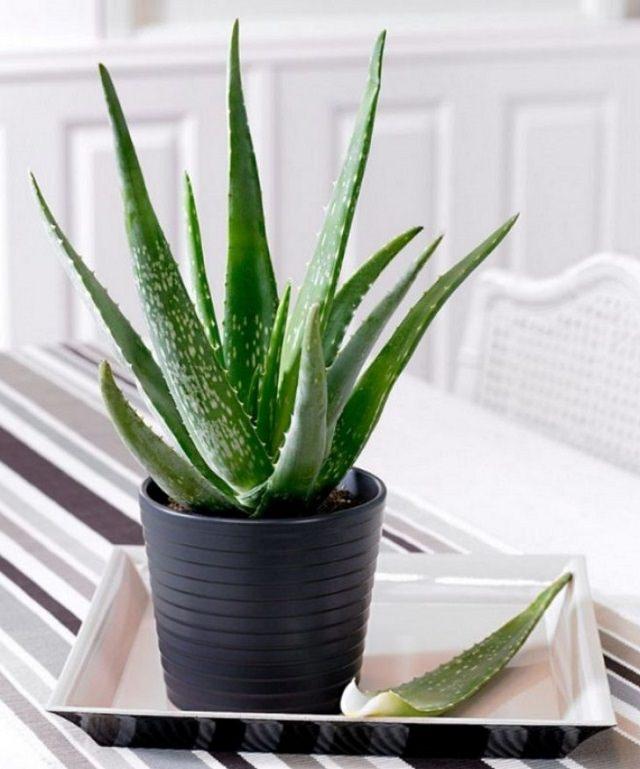
Aloe vera is widely known for its healing property, but it is also considered the most effective plant in terms of filtering out hazardous chemicals and toxins in the air. It lets out oxygen during nighttime, something which is not typical for plants, hence leaving you with a fresher and cleaner air for a more restful sleep. It also produces volatile which provides a positive effect on your immune system. By having an aloe vera inside your bedroom, you can expect a good night sleep.
How to grow: Aloe vera is very easy to care for since it doesn’t require frequent watering. It grows best on spots that receive some sun.
9. Spider Plant
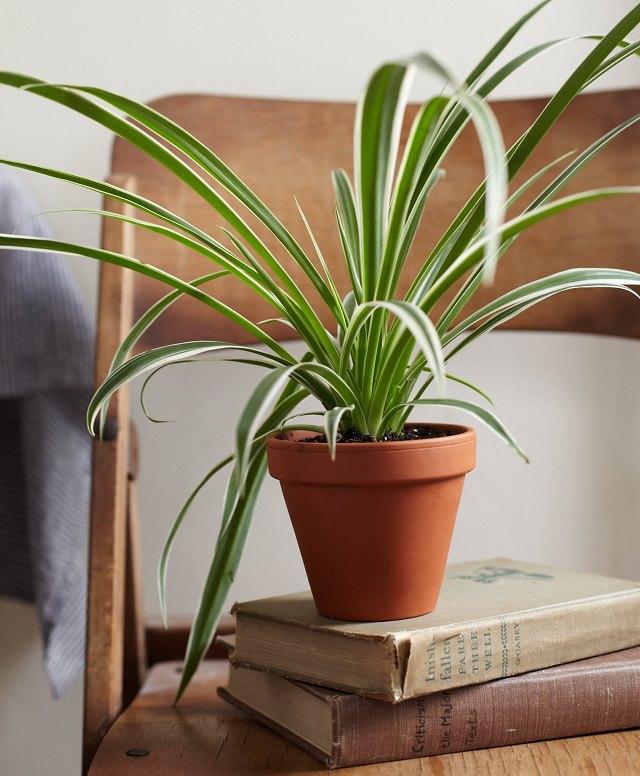
Spider plants are one of the most common house plants which made it to NASA’s list of the most excellent air filtering plants. Spider plants are capable of removing up to 90% of harmful formaldehyde in the air that surrounds them. Other than formaldehyde, they are also capable of filtering benzene, xylene, and carbon monoxide.
How to grow: Spider plants are very easy to grow. As long as they’re provided with a well-drained soil, enough water, and a bright light, they will thrive well.
Also Read: Easiest Houseplant
10. English Ivy plant
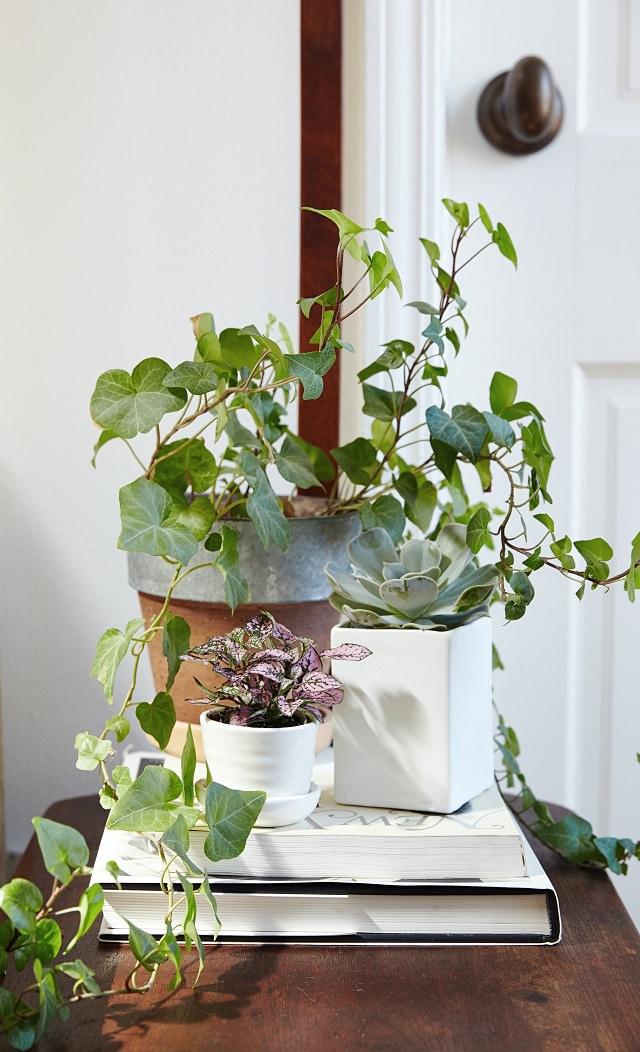
The English ivy plant is a leader when it comes to purifying air, it is also a very hardy plant and thrive in shade. All this makes it an excellent choice for bedrooms. Also, it is discovered to help those who suffer from allergy by purifying the air in its surroundings. With the air effectively purified, you are guaranteed to have a more restful sleep.
How to grow: An English ivy plant is toxic if ingested, which is why you should choose another plant to place in your bedroom if there are small children or pets with you. They grow well in moderate temperatures with moderate sunlight.
11. Lavender

The scent of lavender induces calmness. A study conducted in 2008 has found that the plant’s scent help soothe fussy babies and help them fall into a deep sleep stage. Other than that, research has shown that the lavender is effective for lowering heart rate and blood pressure. As an alternative for the plant, you can use lavender essential oil to get a better sleep.
How to grow: The plant grows best when placed in a bright window with full exposure to the sun. It only requires moderate watering. To learn more click here!
12. Snake plant

According to NASA, the snake plant is among the 10 best houseplants that help filter the air. It absorbs carbon dioxide while at the same time releases oxygen during nighttime, hence allowing you to achieve deep sleep. Through this process, you can expect a naturally clean and fresh air inside your bedroom.
How to grow: A snake plant is a succulent and doesn’t need that much of water or light, hence you can simply place it even in the darkest of corners of your room. It’s actually a low maintenance plant that is ideal for beginners.
Also Read: Plants that Grow without Sunlight
13. Pothos

All plants belong to the pothos family are very easy to grow and low maintenance. This beautiful can be grown in dim corners.
How to Grow: This attractive and hardy vine prefers bright indirect light and a draft free place. It can even grow in really low light and needs slightly moist soil.
14. Hoya
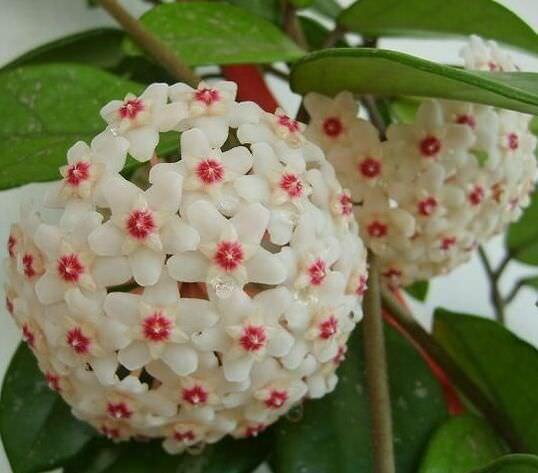
Thick green leathery leaves and long slender stems– the hoya (wax plant) looks beautiful even without its cluster of uniform star-shaped flowers. Sweetly scented hoya flowers can be a wonderful addition to your bedroom and help in providing a RESTFUL SLEEP.
How to grow: Keep the plant in a spot that receives bright indirect sun all day long, a couple of hours of morning sun would be better. Must remember hoya plant requires moderate watering and warm room temperature.
Tips to consider when introducing plants in your room
If you plan on putting houseplants inside your house, make sure you consider the following tips:
Check if they are toxic to the kids and pets inside of your house.Wipe the leaves once a week to make sure the plants can perform their best.Mix your plants with the ones that purify air and the ones that induce deep sleep through their scents.NASA recommends keeping between 15 to 18 air purifying plants in an 1800 sq. ft house, with only a few of them in each bedroom.
Plants are known to improve the overall appearance of your home, but do you know they also contributes to your overall health? There are plants that are actually known to have soothing properties and help if you have trouble sleeping from time to time, you can benefit from such plants– not only they detoxify your bedroom’s air, but help you get a warm good night sleep as well.
To start, here are 14 of the best plants you can grow. They add warmth, relaxing fragrance and effectively increase oxygen levels in your room, thus giving you a restful sleep. Try adding one of them in your bedroom to get a little dose of zen.1. Jasmine

The jasmine plant features lovely little white flowers and a warm intense scent known to induce relaxing qualities ever since the ancient times. Studies have found that Jasmine has sedative properties and can significantly reduce anxiety levels, thus giving a positive impact on sleep quality.
How to grow: Use soilless potting mix and plant your jasmine in a medium to large size pot. It’s best to place it in a warm spot with full sun exposure (at least 4-5 hours a day).
2. Gardenia

Like the jasmine, gardenia features big white flowers and an intoxicating fragrance that is incomparable– not to mention it also comes with a sedative effect. A study conducted in 2010 has shown that the sweet smell of gardenia flowers has the same effectiveness as that of valium in relaxing the body and brain. So instead of relying on sleeping pills, keeping a gardenia in your bedroom or outside your bedroom window could help you sleep more effectively.
Also Read: Most Fragrant Flowers
How to grow: Gardenia is a fussy plant and requires some care, you can read this growing guide in detail to learn how to grow gardenia in a container.
3. Bamboo Palm

The bamboo palm is great for removing trichloroethylene and benzene, two chemicals which are known to induce respiratory problems, thus a great AIR PURIFYING PLANT. With the plant’s excellent filtering property, you can expect a restful sleep when keeping it in your bedroom. It has been awarded a high purifying score of 8.4 in a study conducted by NASA.
How to grow: Bamboo palm grows perfectly well in shade or in indirect sunlight. It needs a slightly moist soil to thrive but at any case overwatering must be avoided.
Also Read: Best Tall Indoor Plants
4. Valerian

The valerian is a perennial flowering herb which features white, red or pink flowers during summer. It is popular among herbalists in treating anxiety, insomnia, and over-excitability, with its roots being commonly used as an ingredient in mild sedatives. When flowering, the valerian produces a calming vanilla fragrance which induces sleep.
How to grow: The plant will need a minimum sunlight exposure of six hours a day. It’s a good choice if your bedroom has a bright window ledge. It will require rich soil and a lot of water.
Also Read: How to Grow Valerian
5. Honeysuckle

The warm mild fragrance of honeysuckle flowers gets more intense in the dark of the dusk. No wonder, it has the most intoxicating aroma. Growing honeysuckle indoors isn’t practical you may think as it’s a big vine. It is! But you can grow dwarf bush honeysuckle, it’s unique and grow only 4 feet tall. Plant it near a window where it will receive partial sun, it can tolerate shade too.
If you have space try growing a honeysuckle vine outside your bedroom window. Either in a large pot or on the ground.
How to grow: You can grow dwarf honeysuckle indoors near a south or west facing window that receives at least 5-6 hours of sun. Also, the honeysuckle prefers slightly moist soil so keep care of it.
Also Read: Best Vines for Containers
6. Rubber Tree Plant

Besides the ornamental aspect, rubber tree is considered as an air purifying plant. It’s proved that growing rubber tree indoors is beneficial as it cleanses the formaldehyde.
How to Grow: Avoid direct sunlight, especially afternoon sun. Otherwise, the leaves will eventually fall off. Place the plant on a bright and well-lit spot that receives indirect or morning sunlight. To read more on how to grow a rubber tree plant, click here!
7. Peace Lily

The peace lily plant has an ability to filter harmful toxins from the air. Apart from it looking exceptional, it also helps in getting rid of any impurities and airborne microbes that could disturb your sleep.
How to grow: Peace lilies are low maintenance plants, only requiring watering on a weekly basis, usually when top 2 inches soil seems dry. They often grow best in a shady spot.
8. Aloe Vera

Aloe vera is widely known for its healing property, but it is also considered the most effective plant in terms of filtering out hazardous chemicals and toxins in the air. It lets out oxygen during nighttime, something which is not typical for plants, hence leaving you with a fresher and cleaner air for a more restful sleep. It also produces volatile which provides a positive effect on your immune system. By having an aloe vera inside your bedroom, you can expect a good night sleep.
How to grow: Aloe vera is very easy to care for since it doesn’t require frequent watering. It grows best on spots that receive some sun.
9. Spider Plant

Spider plants are one of the most common house plants which made it to NASA’s list of the most excellent air filtering plants. Spider plants are capable of removing up to 90% of harmful formaldehyde in the air that surrounds them. Other than formaldehyde, they are also capable of filtering benzene, xylene, and carbon monoxide.
How to grow: Spider plants are very easy to grow. As long as they’re provided with a well-drained soil, enough water, and a bright light, they will thrive well.
Also Read: Easiest Houseplant
10. English Ivy plant

The English ivy plant is a leader when it comes to purifying air, it is also a very hardy plant and thrive in shade. All this makes it an excellent choice for bedrooms. Also, it is discovered to help those who suffer from allergy by purifying the air in its surroundings. With the air effectively purified, you are guaranteed to have a more restful sleep.
How to grow: An English ivy plant is toxic if ingested, which is why you should choose another plant to place in your bedroom if there are small children or pets with you. They grow well in moderate temperatures with moderate sunlight.
11. Lavender

The scent of lavender induces calmness. A study conducted in 2008 has found that the plant’s scent help soothe fussy babies and help them fall into a deep sleep stage. Other than that, research has shown that the lavender is effective for lowering heart rate and blood pressure. As an alternative for the plant, you can use lavender essential oil to get a better sleep.
How to grow: The plant grows best when placed in a bright window with full exposure to the sun. It only requires moderate watering. To learn more click here!
12. Snake plant

According to NASA, the snake plant is among the 10 best houseplants that help filter the air. It absorbs carbon dioxide while at the same time releases oxygen during nighttime, hence allowing you to achieve deep sleep. Through this process, you can expect a naturally clean and fresh air inside your bedroom.
How to grow: A snake plant is a succulent and doesn’t need that much of water or light, hence you can simply place it even in the darkest of corners of your room. It’s actually a low maintenance plant that is ideal for beginners.
Also Read: Plants that Grow without Sunlight
13. Pothos

All plants belong to the pothos family are very easy to grow and low maintenance. This beautiful can be grown in dim corners.
How to Grow: This attractive and hardy vine prefers bright indirect light and a draft free place. It can even grow in really low light and needs slightly moist soil.
14. Hoya

Thick green leathery leaves and long slender stems– the hoya (wax plant) looks beautiful even without its cluster of uniform star-shaped flowers. Sweetly scented hoya flowers can be a wonderful addition to your bedroom and help in providing a RESTFUL SLEEP.
How to grow: Keep the plant in a spot that receives bright indirect sun all day long, a couple of hours of morning sun would be better. Must remember hoya plant requires moderate watering and warm room temperature.
Tips to consider when introducing plants in your room
If you plan on putting houseplants inside your house, make sure you consider the following tips:
Check if they are toxic to the kids and pets inside of your house.Wipe the leaves once a week to make sure the plants can perform their best.Mix your plants with the ones that purify air and the ones that induce deep sleep through their scents.NASA recommends keeping between 15 to 18 air purifying plants in an 1800 sq. ft house, with only a few of them in each bedroom.
3
3
文章
安静的美女子
2017年05月23日

Check out this list of best flowering houseplants! They can add a bright touch to your home, growing them is similar to other indoor plants.1. Begonia

Although begonias are considered as outdoor plants, there are many plants from begonia genus that makes great flowering houseplants. Most of them are easy to grow and good for beginners. Wax Begonia, Rieger Begonia, and Angel-Wing Begonia are among the best and most popular houseplants.
2. Bromeliads

Its colorful foliage and long lasting flowers can beautify any interior. It thrives easily without much care and the best thing is that you can grow this houseplant in low light conditions too.
3. African violet

African violets are easy to grow flowering plants that can be grown indoors for their beautiful flowers and foliage, they prefer warm climate rather than cold. Keep these plant in a spot where they receive filtered sun.
4. Scented Geranium

Scented geraniums with fragrant leaves and bright colorful flowers become incredible houseplants. However, growing geranium indoors is not as easy as other flowering houseplants we have here in this list. It requires a south or west facing window that receives ample sun and moderate watering.
5. Poinsettia

Growing poinsettias in your home can add a bright touch to your interior. Its multicolor bracts look more colorful than its flowers. This tropical plant requires, light, warmth and protection from drafts to thrive indoors.
6. Peace Lily

If you want to grow a low-care plant, grow peace lily. Inside your home, it can live without water for days. Peace lily’s beautiful white flowers flourish in low lighting conditions. It also removes the toxins from the air.
7. Lipstick Plant

Although not commonly grown as a houseplant, lipstick plant can be grown indoors. It requires constantly warm temperature and humid surrounding to grow and thrive. Here is more on how to grow lipstick plant.
8. Jasmine

Many jasmine varieties can be grown indoors. If you keep this most fragrant vine in a bright spot where it receives some hours of direct sunlight daily, it’ll grow. The selection of jasmine varieties you want to plant indoors depends on the climate you live in. For colder regions, Jasminum polyanthum is the one you can try, whereas in tropics most of the plants from this species will grow.
9. Impatiens
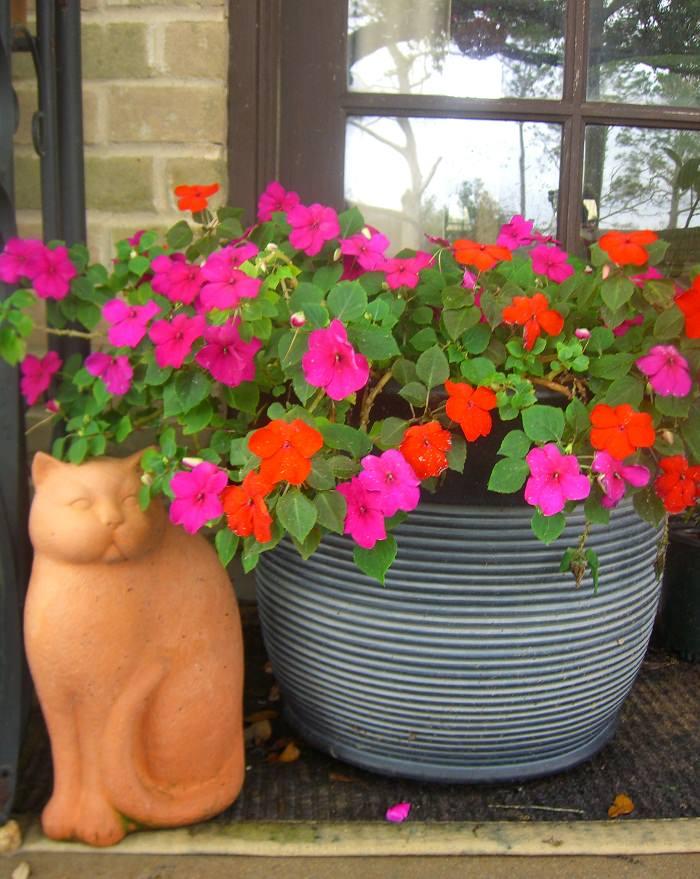
Impatiens are beautiful shade loving annuals but in optimum conditions, you can grow them year-round as a houseplant. Maintain room temperature above 50-55 F and place the pot in a spot that receives bright indirect sun all day long, it would be better if you can provide 1-2 hours of direct sunlight too.
10. Kalanchoe

Kalanchoe is a tropical succulent, plants of this genus grows best outdoors in warm climates. However, it can be grown indoors. This flowering succulent comes in a variety of colors and has low watering needs. You can keep it near a window where it can receive a few hours of sun in order to bloom.
11. Oxalis or Purple Leaf Shamrock

This beautiful flowering houseplant can adorn your house with showy purple foliage and white or pink flowers. Place it at a bright spot for abundant blooms and allow the soil to dry out between watering spells.
12. Cape Primrose

Cape Primrose or “Streptocarpus x hybridus” is a relative of the African violet. If you keep the soil lightly moist and give it bright, indirect sun year-round, it will bloom continuously. Also, there are many new hybrid varieties available with bigger flowers, longer blooming time, and more compact foliage.
13. Christmas Cactus

Christmas cactus is an old-fashioned favorite houseplant of many. When it blooms it creates a warm atmosphere. Red, pink, white or orange: The lovely flowers can quickly brighten up any interior. If maintained well, it can even bloom again from one year to another for years.
Also Read: How to Make Christmas Cactus Bloom at Christmas
14. Crown of Thorns

The Crown of Thorns becomes an exceptional houseplant due to its continuous blooms and low watering needs. If you can provide a sunny window where the plant can be placed, it will grow happily. Available in so many colors, the plant prefers loamy succulent soil and warm temperature.
15. Black Eyed Susan Vine

Black-eyed Susan vine can be grown indoors. Depending on your climate, this annual or perennial flowering plant can add a dramatic appeal to your rooms. Keep it near a window, where it receives a lot of sun.
Also Read: Best Indoor Vines
16. Purple Heart or Inch Plant (Wandering Jew)

A cluster of purple, lance-shaped leaves makes purple heart an impressive houseplant with or without its pink flowers. This beautiful trailing indoor plant can be grown in small colorful pots or hanging baskets and can be used as a table accent. Keep your purple heart (Tradescantia pallida) plant in a spot where it will receive 2-3 hours of sun for a healthy plant.
Note: Several other plants from this genus apart from Tradescantia pallida are known with similar names! For example, Tradescantia zebrina and Tradescantia fluminensis17. Orchids

Orchids are different from other houseplants. Unlike ferns, philodendrons, palms and Swedish ivy, orchids do not grow in soil. Putting an orchid in soil is actually one of the best ways to kill it. You can learn more about growing orchid indoors here.

Although begonias are considered as outdoor plants, there are many plants from begonia genus that makes great flowering houseplants. Most of them are easy to grow and good for beginners. Wax Begonia, Rieger Begonia, and Angel-Wing Begonia are among the best and most popular houseplants.
2. Bromeliads

Its colorful foliage and long lasting flowers can beautify any interior. It thrives easily without much care and the best thing is that you can grow this houseplant in low light conditions too.
3. African violet

African violets are easy to grow flowering plants that can be grown indoors for their beautiful flowers and foliage, they prefer warm climate rather than cold. Keep these plant in a spot where they receive filtered sun.
4. Scented Geranium

Scented geraniums with fragrant leaves and bright colorful flowers become incredible houseplants. However, growing geranium indoors is not as easy as other flowering houseplants we have here in this list. It requires a south or west facing window that receives ample sun and moderate watering.
5. Poinsettia

Growing poinsettias in your home can add a bright touch to your interior. Its multicolor bracts look more colorful than its flowers. This tropical plant requires, light, warmth and protection from drafts to thrive indoors.
6. Peace Lily

If you want to grow a low-care plant, grow peace lily. Inside your home, it can live without water for days. Peace lily’s beautiful white flowers flourish in low lighting conditions. It also removes the toxins from the air.
7. Lipstick Plant

Although not commonly grown as a houseplant, lipstick plant can be grown indoors. It requires constantly warm temperature and humid surrounding to grow and thrive. Here is more on how to grow lipstick plant.
8. Jasmine

Many jasmine varieties can be grown indoors. If you keep this most fragrant vine in a bright spot where it receives some hours of direct sunlight daily, it’ll grow. The selection of jasmine varieties you want to plant indoors depends on the climate you live in. For colder regions, Jasminum polyanthum is the one you can try, whereas in tropics most of the plants from this species will grow.
9. Impatiens

Impatiens are beautiful shade loving annuals but in optimum conditions, you can grow them year-round as a houseplant. Maintain room temperature above 50-55 F and place the pot in a spot that receives bright indirect sun all day long, it would be better if you can provide 1-2 hours of direct sunlight too.
10. Kalanchoe

Kalanchoe is a tropical succulent, plants of this genus grows best outdoors in warm climates. However, it can be grown indoors. This flowering succulent comes in a variety of colors and has low watering needs. You can keep it near a window where it can receive a few hours of sun in order to bloom.
11. Oxalis or Purple Leaf Shamrock

This beautiful flowering houseplant can adorn your house with showy purple foliage and white or pink flowers. Place it at a bright spot for abundant blooms and allow the soil to dry out between watering spells.
12. Cape Primrose

Cape Primrose or “Streptocarpus x hybridus” is a relative of the African violet. If you keep the soil lightly moist and give it bright, indirect sun year-round, it will bloom continuously. Also, there are many new hybrid varieties available with bigger flowers, longer blooming time, and more compact foliage.
13. Christmas Cactus

Christmas cactus is an old-fashioned favorite houseplant of many. When it blooms it creates a warm atmosphere. Red, pink, white or orange: The lovely flowers can quickly brighten up any interior. If maintained well, it can even bloom again from one year to another for years.
Also Read: How to Make Christmas Cactus Bloom at Christmas
14. Crown of Thorns

The Crown of Thorns becomes an exceptional houseplant due to its continuous blooms and low watering needs. If you can provide a sunny window where the plant can be placed, it will grow happily. Available in so many colors, the plant prefers loamy succulent soil and warm temperature.
15. Black Eyed Susan Vine

Black-eyed Susan vine can be grown indoors. Depending on your climate, this annual or perennial flowering plant can add a dramatic appeal to your rooms. Keep it near a window, where it receives a lot of sun.
Also Read: Best Indoor Vines
16. Purple Heart or Inch Plant (Wandering Jew)

A cluster of purple, lance-shaped leaves makes purple heart an impressive houseplant with or without its pink flowers. This beautiful trailing indoor plant can be grown in small colorful pots or hanging baskets and can be used as a table accent. Keep your purple heart (Tradescantia pallida) plant in a spot where it will receive 2-3 hours of sun for a healthy plant.
Note: Several other plants from this genus apart from Tradescantia pallida are known with similar names! For example, Tradescantia zebrina and Tradescantia fluminensis17. Orchids

Orchids are different from other houseplants. Unlike ferns, philodendrons, palms and Swedish ivy, orchids do not grow in soil. Putting an orchid in soil is actually one of the best ways to kill it. You can learn more about growing orchid indoors here.
1
2
文章
Gina
2017年05月23日
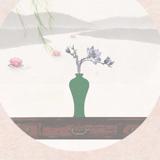

Houseplants are just another way to garden. Indoor gardening has been polar for centuries, and I think it’s a basic human need to want to nurture nature, even within our homes. Plus, houseplants are great decorating accents, and help clean the air within a home. However, I think killing houseplants is an all time top factor behind the term “black thumb”. There are houseplants, however, that are easy to grow, and hard to kill. Here are our top easy houseplants that any gardener can grow indoors. In addition, the plants we have chosen are great for families because they are all non-poisonous. Remember however, to always check with your poison control center with the Latin name from the tag on the plant you buy. Our featured photo plant (above) is the house plant Peperomia. Easy to find in any nursery, and tolerant of a wide range of conditions. Prefer well drained soil, bright light and only water when soil is dry on the surface.
Norfolk Pine – This is an upright plant that reminds me of Christmas. In fact, my Norfolk Pine started it’s life as a mini holiday tree during December vacation to the beaches of Oregon. Likes bright light, but not direct sun. Can grow up to ten feet tall with time. Loves moist air as well, so keep out of the draft of a heating vent. Water when soil surface is dry to the touch.
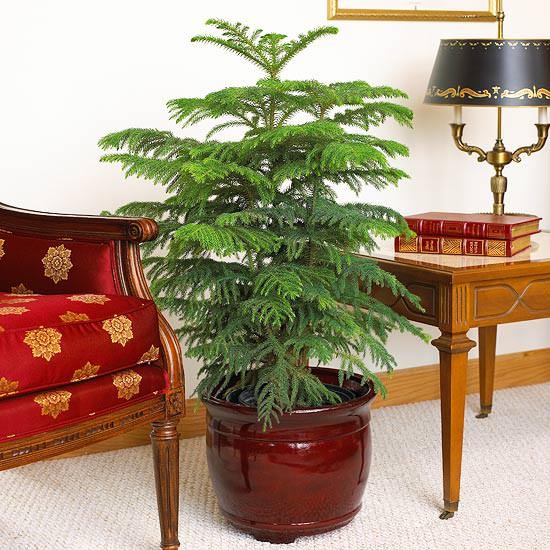
Spider Plant – Who doesn’t love a Spider Plant? Famous for their “babies”, or little plant lets that grow at the ends of stems, and their wonderful arching shape. You can root the “babies” in water easily and create more plants! I love the variegated foliage. Bright to medium light. Keep evenly moist. Leaves will lose color if they are thirsty, but they will bounce right back.
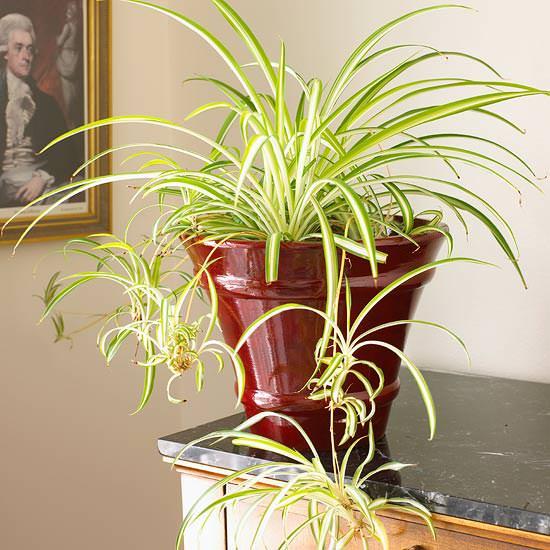
Umbrella Tree (Shefflera) – This larger upright plant has a fan of glossy dark green leaves attached to each stem. Can grow to eight feet tall. Will look leggy in too low of light. Water moderately.

Grape Ivy – Do not confuse this with English Ivy, which can be poisonous. Grape ivy is a wonderful hanging plant, and has glossy bright green leaves shaped like an oak leaf. Will tolerate lower light, but prefers moderate light. Water moderately.
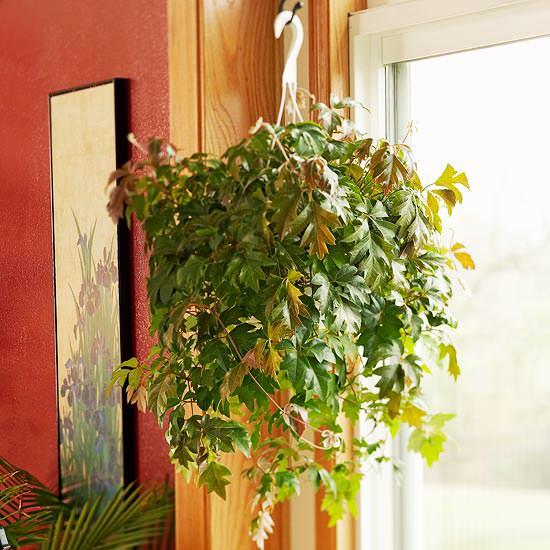
Cast Iron Plant – This plant coms by it’s name honestly…its made like cast iron! Hard to kill… will even bounce back from a bad wilt from lack of water, will tolerate low light and neglect. That having been said, it’s stripy leaves (sometimes spotted with cream) look best in medium light, with evenly moist soil. Thats it! Doesn’t get easier!
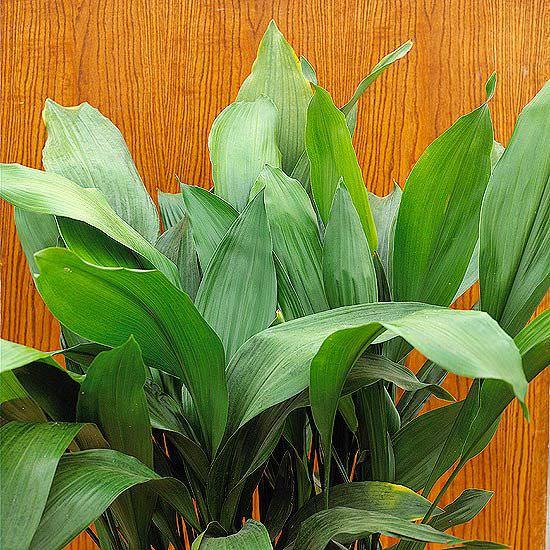
Whether it’s because it’s the depths of winter and you want to see some green living things, or just because you enjoy having houseplants in your home, these easy houseplants are a great place for busy gardeners to start their “indoor garden”.
0
0
文章
Abigal
2017年03月13日


If you garden at all, you need a potting bench! Why? Yes, you could transplant those seedlings on the back patio, and you could re-pot all your houseplants on a newspaper covered dining table. But once you’ve discovered the convenience of having a dedicated potting table for all your garden chores, you will never go back! Don’t want to shell out hundreds for a nice looking one from the catalogs? No problem. We have instructions for some great DIY potting benches anyone can make. BTW… excellent Mom’s Day, Birthday or Anniversary gift! (Or, just because you want to love your gardening hobby just a little bit more, gift…) Our featured photo (above) comes from Jardin Designs. They created this potting bench from an old dresser…. Love this!
Use scrap wood to attach a headboard and footboard together, then apply a tabletop and paint a great color! From the Backyard Diva.

Robins Nesting Place made this potting bench from old rummage sale junk! This is so cute!

Fabulous Home Ideas made this potting bench against a garage wall…and I love how this looks! With supplies from a home improvement shop and surplus supplies for the table top, they created something that looks really cool without looking sloppy.

We found this potting bench floating around Pinterest, and I had to share it because it looks so amazing… Obviously old fencing material with an old window… Creative repurposing, yet looks like it would last forever! If anyone knows who created this, please share so we can pick their brain!

Want to build a sturdy, yet simple DIY potting bench from scratch? This Old House has a full tutorial!

Also found on Pinterest, an old baby changing table and recycled wood pallets make this DIY potting bench!

Potting bench made from an antique door, beadboard, porch posts, chicken wire and a working antique light – wow! From HGTV Gardens…

This cute DIY pallet potting bench is budget friendly. From Ana-White.

And one of my favorites from BHG, this armoire potting bench has step by step instructions.
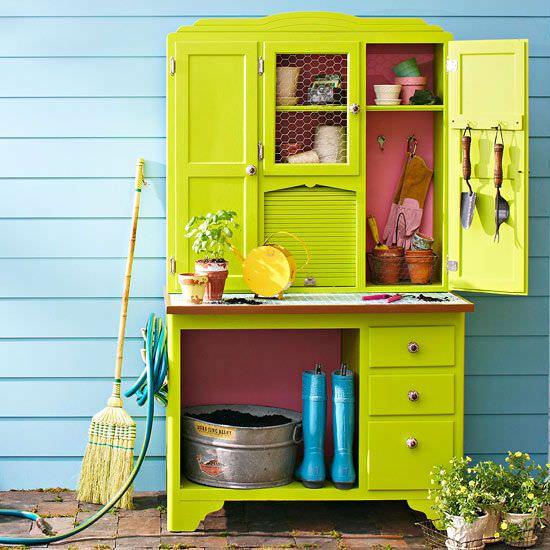
Finally, an inspirational potting bench from Ty Pennington. Keep garden dreaming!

0
0




